Organizational Optimization – Workshop 2 (Needs Prioritization)

The Appleton Greene Corporate Training Program (CTP) for Organizational Optimization is provided by Mr. Shortt Certified Learning Provider (CLP). Program Specifications: Monthly cost USD$2,500.00; Monthly Workshops 6 hours; Monthly Support 4 hours; Program Duration 12 months; Program orders subject to ongoing availability.
If you would like to view the Client Information Hub (CIH) for this program, please Click Here
Learning Provider Profile

Mr. Shortt is a Certified Learning Provider (CLP) at Appleton Greene and Co (AGC) as well as the owner of an international business education and consultancy company which focuses on individual, personnel and overall business optimization. Mr. Shortt is honored to provide AGC services through a wide array of past business experience that includes such industries as Biotechnology, Healthcare, Government and Utilities. In these industries, Mr. Shortt has held various roles in operations management, product management and design, sales, and workflow optimization.
Historically, Mr. Shortt has worked with many of the Fortune 500 global leaders in diagnostics, information technology products and services, such as McKesson, Roche, and Danaher, and has also served in the US Army as an officer in the Medical Service Corps, where Mr. Shortt provided not only leadership expertise, but also workflow optimization utilizing IT and hardware applications, leveraging such workflows aids as robotics and automation. Mr. Shortt’s personal education, which is highlighted by an MBA with an Executive certification, has been structured for him to be able to provide leadership perspective and expertise in how to identify a business’ foundational current state in such areas as Financials, Business Strategy, Marketing Strategy, and Personnel Management, and then to leverage that expertise to prioritize and optimize a business’ path to success. Mr. Shortt holds various certifications, such as Business Analysis from a managerial perspective, and also possesses a Six-Sigma Black Belt certification. Mr. Shortt’s personally-owned business, Ascension Advising Solutions, LLC, which is based in Raleigh, North Carolina, USA, as well as in Tallinn, Estonia in the EU, has provided business training and consultation services for various international companies in Europe, the United Kingdom, South Africa, and recently in China. Mr. Shortt is the author of two books on finding financial success and empowering your business, as well as a business optimization blog. Mr. Shortt is also the primary author and life coach of a self-optimization website dedicated to the long-standing benefits of mindfulness meditation in today’s modern world. Mr. Shortt’s service skills for AGC notably incorporate: leadership optimization, business strategy and optimization, personnel management, and program education and development.
MOST Analysis
Mission Statement
As a result of the information triggers from Month One, the proper placement of the program can be established. As current leaders of the organization with executive responsibility for operations, Month Two is dedicated to the determination, and possibly, the prioritization of optimizing processes within business units and/or departments. Larger organizations that are comprised of product and/or service delivery functions, logistics, human resources and training, and information technology units, can have many areas of need for business optimization. It is at this point in the program that the organization establishes buy-in for where this program will first be implemented: At what tier in the organization and which business unit(s)? If at lower departmental tiers within business units, which departments are considered higher priority for the benefits of optimization? Should this program be implemented across departments with multiple starting points, and possibly over multiple years? These are all questions that will be answered as means of proper placement of the program based on priority and how the benefits of the program can provide the best overall impact to the organization.
Objectives
01. Defining a Need: departmental SWOT analysis; strategy research and development. Time Allocated: 1 Month
02. Organizational Priorities: departmental SWOT analysis; strategy research and development. Time Allocated: 1 Month
03. Purpose and Vision: departmental SWOT analysis; strategy research and development. Time Allocated: 1 Month
04. Prioritization Process: departmental SWOT analysis; strategy research and development. Time Allocated: 1 Month
05. Identifying and Clarifying Needs: departmental SWOT analysis; strategy research and development. Time Allocated: 1 Month
06. Define Characteristics of Each Need: departmental SWOT analysis; strategy research and development. Time Allocated: 1 Month
07. Tackling Needs in Order of Urgency: departmental SWOT analysis; strategy research and development. 1 Month
08. Additional Criteria for Needs Prioritization: departmental SWOT analysis; strategy research and development. Time Allocated: 1 Month
09. Prioritization Tools: departmental SWOT analysis; strategy research and development. Time Allocated: 1 Month
10. Roadmapping Tools : departmental SWOT analysis; strategy research and development. Time Allocated: 1 Month
11. Stakeholder Communication and Buy-in: departmental SWOT analysis; strategy research and development. Time Allocated: 1 Month
12. Define Stakeholders for Process Improvement Projects: departmental SWOT analysis; strategy research and development. Time Allocated: 1 Month
Strategies
01. Defining a Need: Each individual department head to undertake departmental SWOT analysis; strategy research and development.
02. Organizational Priorities: Each individual department head to undertake departmental SWOT analysis; strategy research and development.
03. Purpose and Vision: Each individual department head to undertake departmental SWOT analysis; strategy research and development.
04. Prioritization Process: Each individual department head to undertake departmental SWOT analysis; strategy research and development.
05. Identifying and Clarifying Needs: Each individual department head to undertake departmental SWOT analysis; strategy research and development.
06. Define Characteristics of Each Need: Each individual department head to undertake departmental SWOT analysis; strategy research and development.
07. Tackling Needs in Order of Urgency: Each individual department head to undertake departmental SWOT analysis; strategy research and development.
08. Additional Criteria for Needs Prioritization: Each individual department head to undertake departmental SWOT analysis; strategy research and development.
09. Prioritization Tools: Each individual department head to undertake departmental SWOT analysis; strategy research and development.
10. Roadmapping Tools: Each individual department head to undertake departmental SWOT analysis; strategy research and development.
11. Stakeholder Communication and Buy-in: Each individual department head to undertake departmental SWOT analysis; strategy research and development.
12. Define Stakeholders for Process Improvement Projects: Each individual department head to undertake departmental SWOT analysis; strategy research and development.
Tasks
01. Create a task on your calendar, to be completed within the next month, to analyze Defining a Need.
02. Create a task on your calendar, to be completed within the next month, to analyze Organizational Priorities.
03. Create a task on your calendar, to be completed within the next month, to analyze Purpose and Vision.
04. Create a task on your calendar, to be completed within the next month, to analyze Prioritization Process.
05. Create a task on your calendar, to be completed within the next month, to analyze Identifying and Clarifying Needs.
06. Create a task on your calendar, to be completed within the next month, to analyze Define Characteristics of Each Need.
07. Create a task on your calendar, to be completed within the next month, to analyze Tackling Needs in Order of Urgency.
08. Create a task on your calendar, to be completed within the next month, to analyze Additional Criteria for Needs Prioritization.
09. Create a task on your calendar, to be completed within the next month, to analyze Prioritization Tools.
10. Create a task on your calendar, to be completed within the next month, to analyze Roadmapping Tools.
11. Create a task on your calendar, to be completed within the next month, to analyze Stakeholder Communication and Buy-in.
12. Create a task on your calendar, to be completed within the next month, to analyze Define Stakeholders for Process Improvement Projects.
Introduction
The goal of Workshop 2 is to identify any current significant pain points that your organization may be experiencing. The needs prioritization would probably be focused on a well-known, obvious problem, like persistent logistical errors that are negatively hurting actual sales. Every company will experience problems that need to be resolved, and the goal of this workshop is to identify these problems and acquire the information needed to rapidly and efficiently address them (s). However, depending on the job or position of the user, this application itself is a guide to show people how to effectively assess, prioritize, and manage/implement change across numerous pain points (bottlenecks) inside a department, and/or across departments and/or business units.
Every organization needs what is called a “Hierarchy of Purpose”. It is nearly impossible to prioritize effectively without one.
Strategic and operational prioritization can frequently mean the difference between success and failure. However, a lot of businesses do it poorly.
Let’s use a real-world illustration: a corporation that delivers packages to customers via the postal service. In an era of escalating competition and digital equivalents, the company has been fighting to survive, much like many other postal systems. At a series of town hall meetings, senior management invited staff members to focus on two operational priorities: effectiveness (improving delivery times) and customer satisfaction (ensuring customers had a good experience).
Mary, a worker, understood the message. And all went smoothly until she was out delivering items when an old guy knocked on her door and invited her inside for a short conversation. Mary’s instinct was to see the lonely old man for a while. In addition to being a kind thing to do, it would undoubtedly improve consumer satisfaction. She then froze, though. How about effectiveness? Her delivery timings would suffer if she talked to her customer for even a brief period of time. What exactly was she to do? At this company, thousands of workers had to make comparable decisions every day.
The situation is a common one. The postal company’s senior management believed they had conveyed clear priorities, but in reality, they had produced an operational conundrum as a result of strategic uncertainty.
Compare this to other profitable businesses. For instance, the low-cost airline Ryanair in Europe is quite open about the fact that it is a no-frills business where operational priority is efficiency, which takes precedence above customer service. Ryanair employees are aware of the importance of each task and know how to prioritize their time accordingly.
Prioritizing improves strategic project success rates, senior management team focus and alignment toward strategic goals, operational team confidence in decision-making, and, most importantly, fosters an execution attitude and culture.
Of course, there are times when leaders just select the incorrect priorities and make the wrong decisions. However, in many cases, the issue seen more frequently is that leaders don’t actually make any obvious judgments. They don’t make it clear what they mean when they say, “it matters.” Simply put, they lack priorities.
Companies with highly developed perceptions of priorities include Apple, Amazon, Lego, Ikea, and Western Union, and the benefits are significant. Companies that start prioritizing can see significant cost savings as less important tasks are eliminated and redundant efforts are combined.
An organization’s list of priorities can be very telling. A senior executive team will typically have a generous portfolio of priorities if their risk appetite is very low (or if they lack the ability or desire to make the difficult decisions); they don’t want to take the risk of not being compliant, missing a market opportunity, not having the newest technologies, etc. However, based on many observations, the most effective executives tend to take more risks and have a laser-like focus on a select few priorities. These business leaders are cognizant of current and future issues. At its most extreme, this may involve focusing only on one priority. More concentration is preferable.

The Hierarchy of Purpose
The Hierarchy of Purpose, a simple framework developed by Antonio Nieto-Rodriguez, is a tool that executive teams can use to help them prioritize strategic initiatives and projects:
• Purpose. What is the purpose of the organization and how is that purpose best pursued? What is the strategic vision supporting this purpose?
• Priorities. Given the stated purpose and vision, what matters most to the organization now and in the future? What are its priorities now and over the next two to five years?
• Projects. Based on the answers to the first two points, which projects are the most strategic and should be resourced to the hilt? Which projects align with the purpose, vision, and priorities, and which should be stopped or scrapped?
• People. Now that there is clarity around the strategic priorities and the projects that matter most, who are the best people to execute on those projects?
• Performance. Traditionally, project performance indicators are tied to inputs (e.g., scope, cost, and time). They are much easier to track than outputs (such as benefits, impact, and goals). However, despite the difficulty companies have in tracking outputs, it’s the outputs that really matter. What are the precise outcome-related targets that will measure real performance and value creation? Reduce your attention to inputs and focus on those instead.
The strategic dialogue and alignment at the top of the company are best improved by prioritizing. From that point, it then cascades to the remainder of the organization. Priorities become ingrained in the business and its corporate culture if you successfully guide the leadership team to comprehend this.
Consider the priorities of your organization. Are all of your varied activities prioritized for the organization’s overall success? What is the best way to utilize the company’s current and foreseeable financial and operational resources? What would become more important to you in the event of a rapid economic downturn?
Most projects and initiatives in an organization are aligned with its strategies when organizational priorities are understood and well-communicated. However, organizations are considerably more complex in reality than most people realize. Strategic goals can occasionally be hazy or absent entirely. Between the corporate strategic objectives and those of the various business units, divisions, or functions, there is frequently a disconnect and lack of alignment.
It is actually not viable to align all of an organization’s initiatives and programs with its strategic goals. For example, it is more feasible to guarantee that at least the 20 most crucial projects and programs are completely in line with the strategic goals.
Executives realize that shifting priorities are a reality of corporate life by using the Hierarchy of Purpose. In fact, whenever a company drops a priority, the company becomes more focused. Every objective that is dropped presents an opportunity to grow and improve moving forward. Only when senior management makes difficult decisions can priorities change and have the power to radically alter organizations.

Prioritizing Organizational Wants vs. Needs and How to Tell the Difference
Strategic planning often forces leaders to choose between alternatives. Before making any judgments about action planning, it is crucial to identify which alternatives are optional and which are actual business necessities. It might be challenging to distinguish between organizational wants and needs and to rank them in terms of importance. Strong knowledge of the existing company environment, clear long-term goals, and opportunity cost analyses for each option all facilitate the process.
Basic Analysis Information
Without initially doing a thorough analysis of the existing business environment and establishing long-term company objectives, it is impossible to pinpoint organizational needs or rank them in terms of importance. Information about the environment comprises both internal and external variables that could have an impact on the company. This involves an examination of the state of the economy, a market study, and the findings of an internally generated analysis of the company’s strengths, weaknesses, opportunities, and threats (SWOT). With this knowledge, the business owner can create broad goals that span three to five years and are in line with the organization’s vision.
Opportunity Alternatives
Long-term objectives have been created as the source of opportunity options. Depending on each company’s desired long-term emphasis, many options are available, including as creating new revenue streams, breaking into new markets, expanding sales regions, or perhaps buying another company. As an illustration, setup, advertising, and upkeep options are potential alternatives coming from a revenue stream target to build up a website. The site might be built from scratch internally or with a custom design as setup options. Utilizing the present company logo in its current form or altering it to better suit the website are two other options.
Distinguishing Wants Vs. Needs
A leader or executive can discern between a wish and a necessity by using an opportunity cost analysis, which calculates the costs of selecting one choice over another. The criteria used to assess opportunity value most frequently is which choice will result in the highest profit. Among the variables that may be employed are time, labor, or worker productivity. For instance, while comparing several options for website setup, consideration can be given to development time, employee productivity, and overall cost to the company. The business owner must decide whether lost employee productivity and a corresponding overall reduced setup cost are more relevant than no lost productivity, but a significantly higher setup cost, when determining whether to construct a website from scratch internally or have it custom-built. The requirement is for whichever choice is eventually the most profitable, regardless of the desire of the business owner. For purposes of this study, a desire is defined as a course of action that does not increase business revenues or further strategic objectives.
Prioritizing Wants and Needs
Needs are usually given priority over wants when setting priorities. Prioritizing needs in accordance with the importance of their parent strategic objectives is a frequent starting point. Building the website comes in first, if finding new money sources is the main strategic goal. Other chance possibilities that have been identified as wants within this target include incorporating the current company logo exactly as is, setting up click-based advertising, and creating a website newsletter. If time and resources permit and once all needs have been satisfied, more opportunities designated as desires might be added to the website in accordance with the priority order in which they were assigned.

Prioritizing Your Business Goals
For a firm to succeed, a lot of effort and sacrifice must be made. Successful companies don’t just appear out of nowhere. The first step in growing your business is to set goals and order them by priority . Setting and achieving business goals will help you make sure that your company is headed in the proper direction.
Short-term objectives created for the business are known as business goals. Every organization has goals that are specific to how it operates, and no two organizations will necessarily have the same goals. It is simpler to evaluate the success of your company in relation to the specified goals when business processes are measured.
Your company’s goals and priorities must always be reviewed and up to date in the quickly evolving business world.
For many firms, developing an actionable plan is a huge difficulty. Your annual exercise should include reassessing your goals to make sure that all business operations are coordinated. You should keep the following points in mind when you examine your company goals for this year.
1. Evaluate the previous quarter
Analyzing the final quarter of the previous year will provide you a clear picture of the future direction of your company. Your business is likely to carry over its performance from the previous year’s fourth quarter (Q4) into the current one if you had a strong Q4. It won’t always be that simple, though, and you’ll have to consider the good and bad from the previous three months.
You can evaluate the objectives you had set at the time by understanding where you made mistakes. You can investigate the causes of any success or failure and create better company objectives. You can create a better strategy for the following year if you remember all the lessons you learned from this experience.
2. Prioritizing Your Business Goals
After evaluating the final three months of the year, you can next evaluate the full prior year. You can learn what worked and what didn’t for the company last year by talking to your team. Any factor that contributed to your company’s success should be used to spur expansion in the coming year.
The failures from the prior year do, however, point to weak points in the company that require strengthening. Your course of action will be heavily influenced by the nature of the weakness. It will frequently be essential to direct or redirect resources toward the troublesome location.
A few typical company sectors that could use improvement include management, marketing, operations, and finance. However, you should follow up on each evaluation with specific plans to capitalize on your company’s advantages and address its shortcomings.
3. Make training a priority
Your company will need to make an investment in the development of its human resources as it relates to the competencies of your team and your organization. Your team’s professional development will be crucial in assisting you in achieving your business objectives. You must prioritize training if you want to accomplish this.
All employees, especially the management, must receive top-notch training to keep up with the current commercial trends. These could include any advancements in corporate technology, modifications to laws, and novel marketing strategies. Additionally, by educating your staff on these fresh concepts in business automation, you can foster the expansion of your company.
Making the appropriate budget for training will depend on your understanding of the particular requirements of your company. Due to the bulk discounts provided, group training is relatively economical. If your workforce needs training at any point, having inside experts on hand can be helpful.
4. Set SMART business goals
You must establish specific goals if you want your firm to expand. By establishing SMART business goals, this is feasible. Specific, Measurable, Achievable, Realistic, and Time-Bound goals are the best. This implies that you should have specific objectives that clearly outline the things you need to do as well as a timeline for doing so. You must also make it clear how you plan to demonstrate that each objective has been accomplished.
For instance, your company provides farms with animal feed. To boost sales of pig feed by 3% by the end of the second quarter, you can set a SMART target. You can decide to accomplish this target by running internet ads for three months. Here, increased revenue will be a sign that the company has accomplished its objectives.
5. Use High-Quality Data
Today’s business world is heavily reliant on data. Your company’s success or failure will consequently be determined by how accurate the data used in it is. Effective business analysis depends on using correct, well-structured data, whereas using inaccurate data might harm your company irreparably.
Prioritizing the type of data being used should be your first step. Encourage your staff to use best practices for data management, such as documenting business processes to get precise data on your company’s success. Additionally, you can frequently clean and/or update your databases and assess the caliber of the data used.
To assist with this work, you could hire a data consultant(s). They may also assist with evaluating your company’s current database to make sure it is accurate and consistent and has the data you need. Additionally, you should rank the data according to importance for the company and evaluate the data’s quality using key performance indicators (KPI’s).
You can hire qualified academic writers at assignment to handle your business research, data analytics, and business presentation projects. Research writing is a specialty area for writers employed by dissertation writing services, and they can work miracles for you.

6. Assess Your Business Leverage
Assessing your company’s financial leverage can aid in its expansion. You can establish whether the company can obtain loans and repay them on time by performing this assessment.
Businesses that choose not to incur debt frequently pass up the chance to make new investments, recruit new personnel, and pay off old debts. You can better execute your strategic plans by evaluating your leverage. If your company can handle finance internally, you won’t need to.
7. Make Your Vision Clear
You should base the development of your business goals on your company’s vision. This is a crucial step in developing your strategic plan. Set objectives that will help the company realize its long-term strategy.
It will be simpler for you to position your role and provide your company direction as a result. To make your goals more attainable, always make sure that your vision is current and distinct. Your team should be motivated by and able to easily understand your vision. It should also explain the purpose for which the company exists.
8. Set Your Business Goals
Writing down your long-term goals is necessary once you’ve reviewed your business goal. Decide on one to three objectives that you believe are most crucial for the success of your company. By fulfilling these objectives, you should be moving closer to realizing your company’s vision.
Your yearly objective can be to increase sales, gain market share, or enhance the consumer experience for your brand. It has been established that quantifiable goals are simpler to monitor and more doable.
9. Create Achievable Milestones
You’ll be able to be more strategic and tactical as you work to attain your business goals if you set them in line with the business vision. The goal you’ve established for the upcoming year can easily be divided up into manageable stages. Setting quarterly targets, for instance, makes it simpler for you to accomplish the overall business goal this year.
Your objective can be to boost your company’s revenue. You must make sure that you increase sales throughout the year in order to do this. To grow sales of your portfolio by a specific percentage every three months, you may set quarterly goals.
10. Give Each Goal a Value
Value is the benefit you receive from completing a specific task. This is the benefit that comes from reaching a particular objective for your company. Every business objective needs to be valued. This will let you give the most crucial objective for your company top priority.
11. Quantify the Goals
You can more easily quantify the goals once you’ve given each one a value. This will enable you to prioritize your business goals objectively, especially if you have a number of short-term objectives for your company to meet. You can rank your goals in importance by quantifying them and assigning values to them. This makes it simpler for your company to concentrate on accomplishing that objective initially.
12. Create the Accountability Agreement
With your team, decide on the accountability after defining SMART business goals with a value. This will make it easier to accomplish the goals through predetermined milestones by assigning responsibility for their execution to a certain team or person. In addition, you should make sure that everyone in your company is aware of the business objective so that everyone can work to achieve it.
Conclusion
Prioritizing and setting your business goals may seem like a daunting task. However, now is the best time to get the team and yourself ready for the entire year. You can create SMART goals supported by solid business results by thoroughly reviewing the accomplishments and failures of the preceding year.
You can prioritize your data as you develop a goal aimed at realizing the business vision with the aid of a well-trained workforce. You will gain the skills and information necessary to put your company on the road to successfully prioritizing business needs and so boosting overall business success and optimization after attending this course.
Executive Summary
Chapter 1: Defining a Need
Without initially doing a thorough analysis of the existing business environment and establishing long-term company objectives, it is impossible to pinpoint organizational needs or rank them in terms of importance. Information about the environment comprises both internal and external variables that could have an impact on the company. This involves an examination of the state of the economy, a market study, and the findings of an internally generated analysis of the company’s strengths, weaknesses, opportunities, and threats (SWOT). With this knowledge, the business owner can create broad goals that span three to five years and are in line with the organization’s vision.
Organizations are frequently viewed in terms of their capabilities and roles rather than as living things with basic and sophisticated needs. The same applies to only considering a vehicle in terms of what it is capable of doing, such as speed, aesthetics, low fuel consumption, etc., rather than as a machine with needs.
Planning and growth require an understanding that organizations, like machines and humans, have needs.
Unmet needs have an impact on how an organization performs. Abraham Maslow viewed human motivation as a quest to satisfy fundamental needs, which he arranged hierarchically, in Motivation and Personality (1954). The lowest unmet need in this hierarchy determines motivation. After one need is satisfied, a higher unmet need takes over, and the pursuit of its satisfaction directs our behavior.
Two significant issues related to managing organizations are brought up by this concept. Can we create a similar Needs Hierarchy for organizations first? Second, how well does that structure describe the actions of the organization?
In order to scope the hierarchy of requirements for organizations, we think we can transfer Maslow’s paradigm onto organizational dynamics.
Understanding the organizational demands hierarchy will aid entrepreneurs and business executives in concentrating resources and reducing distractions.
Additionally, recognizing these needs will aid business-to-business (B2B) marketers in positioning their product more effectively.
Maslow’s hierarchy of needs and the hierarchy of organizational needs are not identical, but it is still important to understand where they overlap, why an organization’s need at a given time might differ from an employee’s need, and how to integrate these theories to build exceptional organizations.

Chapter 2: Organizational Priorities
What are organizational priorities?
The most significant acts, activities, products, or services that the organization provides might be regarded as its organizational priorities. An organization finds it challenging to rank priorities in a clear order in many business sectors because many of them are interconnected and dependent on one another. Sometimes, this debate can turn into a “chicken or egg” situation.
Even if it is challenging, it is nonetheless crucial to make an effort to identify the organization’s needs and establish priorities. A high, medium, and low priority list could be useful. This priority list may already exist for a number of organizations and industries as a result of an earlier strategic or operational planning process, making a quick assessment and reordering possible.
Objectives
Identification of organizational priorities will:
• Assist the organization, leaders and staff to focus on what is most important
• Identify what needs the most attention
• Assist in the allocation of resources and time to a specific activity or priority area/demographic
• Provide clarity on why some things are being done first
How are organizational priorities identified?
Once more, the time to think about this is right now. It could be challenging to predict what would occur in the future with relation to the effects of implementing one priority over another. The priority list should be made based on the assumption that there are no constraints or negative effects, regardless of the predicted order or time frame. The steps of scenario mapping and recovery planning will aid in determining the activity’s significance at each level of the needs prioritization procedure.
Prior priority lists, strategic plans, operational plans, and annual reports will all be helpful. But now is a good opportunity to reflect on them in light of the current situation and ask yourself, “Was ABC really the most crucial thing?” or “DEF seems to be the main topic right now; no one seems to care about ABC.” Do not be hesitant to alter the priorities of your organization or the way your industry operates as needs and demands evolve within your industry.
In light of scarce resources, you might want to consider if some activities or demographics are more important than others. What if you can’t accomplish everything, for instance? Be critical of the priorities, since for certain organizations and leaders, this will be the situation. The mere fact that something is low priority does not exclude its completion or recommendation in the future.
Even while the current situation might not be conducive to a lengthy consultation process, some rapid and focused input or remarks from your members, stakeholders, and partners, including your next highest authority, may be necessary.
This needs to be prepared as a public document that may be sent to interested parties, organizations, and members. It will demonstrate to your stakeholders and members what matters most to the company or what needs to be supported first.
Identification of organizational priorities
There are a lot of possibilities for this procedure and some firms will already have their own favored way. Here is one simple method that you may like to consider.
High — Medium — Low
As a simple exercise: Using post- it notes, ask each of the personnel engaged to jot down a significant activity or component of your operations (i.e., junior training, office administration or senior fitness sessions, etc.) and set them on a board or butchers paper. Each part of the board or butchers paper should be designated as high, medium or low. Ask them to place the note on the area that they think is relevant.
The next stage is to establish if any of the operations or activities are all in one region, and start to concentrate on areas of consensus. Enable some debates on any that are in the low and high (as an example) as people may have solid points on why they choose that location.
Consolidate the activities or operations into a final table that lists those that are high, medium or low.

Chapter 3: Purpose and Vision
Organizational Purpose
We’ve all witnessed it: businesses with the “it” factor, an excitement and fire that enlivens staff, enthralls clients, and gleams for investors. It goes beyond the brand’s cozier fleece, better ice cream, or even innovative technology. And it also goes well beyond a mission statement. Its objective. The question, “What would the world lose if your company vanished?” is addressed in its purpose. It identifies a company’s fundamental purpose and the beneficial effects it has on the world as a result. Successful businesses are motivated by a mission, and they strive harder and accomplish more as a result. Competitors ponder how and where they may sprinkle on some of that magic.
If that is what you anticipate—a purpose that is readily added to your mix—prepare to be let down. Purpose cannot be approached in a shallow manner. In reality, the effects of a poorly implemented and/or defined purpose can cause a lot of damage, exposing your business to claims of deception or “purpose-washing,” alienating clients or driving them away completely, and negatively influencing staff members throughout your entire organization. When a solution is a patch job, poor results will result.
However, the converse is also true: organizations that have a sincere, “lived” mission exude authenticity and prosper by doing good universally. Investors, partners, suppliers, and customers are aware of the value offerings. Senior leaders make strategic decisions when allocating money and resources. Employees also continuously consider their purpose and regularly incorporate it into their decision-making. Creating those dynamics is difficult. Leaders must integrate purpose across the entire organization. Your company’s “superpower”—its distinctive and inherently unique capacity to produce value—must be connected to your company’s purpose, as we’ve previously explained. Purpose is not the same as ESG (Environmental, Social, and Governance). Your business’s core purpose can be to serve others, for example.
We outline a framework in this course manual that businesses may utilize in assisting to realize their goals, avoid any pitfalls or negative consequences, and help create genuine value. This structure is known as the 5P’s.
Organizational vision
What Is a Vision Statement and Why Is it Important?
Every new company or organization starts with a concept. This proposal is supported by a vision of what the organization might become if it had the appropriate structure, the proper leadership, sufficient financing, and a group of supporters. The mission and reasons for the organization’s existence are discussed in the vision.
Vision statements are used by all kinds of organizations, including for-profit businesses, nonprofits, charities, and other groups, to direct them in their crucial job. They must be certain of the function the vision will play within the company. We’ll go into more detail about vision statements in this course manual.

Chapter 4: Prioritization Process
One of the most crucial duties for a leader is coming up with a strategy or tactics. These must be informed by facts, assessed frequently, and updated as necessary. But maybe even more significant are the related duties of selecting priorities and carrying out strategies. These are frequently the essentials for reaching your strategic goals. The ability to identify what is important and then perform the important things well is one of the qualities that makes a great leader. Success or failure in this regard is one of their distinguishing characteristics. Find the tasks that are most important to the objective first, and then determine how to complete them effectively and on schedule.
Project prioritizing is the cornerstone of a successful project implementation. Here, your projects are aligned with strategy. You obtain executive sponsorship and support there. You locate and get rid of garbage there.
Poor prioritization causes projects to fail and ultimately results in failed business objectives. When properly implemented, a sound project prioritizing approach will enable you to strategically align your decisions about the allocation of resources while producing more productive projects.
One of the most crucial skills for any business that manages projects is the ability to prioritize initiatives. It is the starting point for your portfolio’s overall performance.
When setting project priorities, you should:
• Align your projects with your strategy
• Quantify which projects add value and which don’t
• Balance the volume of projects you take on with you capability to deliver those projects
• Focus your whole project delivery team on business benefits
In layman’s terms, prioritization is the process of determining which tasks are most crucial so that your resources can be concentrated on successfully completing those value-added projects.
It is the first and most important stage in creating a solid and balanced portfolio of projects and in choosing wisely how to allocate resources when putting those initiatives into action.
Further, there are appropriate (and inappropriate) ways to order project tasks. There are pitfalls you can get caught in.
Why Prioritize Projects?
Project prioritization is much more than just a budgetary procedure, which is how many businesses view it.
On average, strategic prioritizing investments increase value by 40% for the organizations that make them.
Even though this sounds like sufficient justification to invest in enhancing the project prioritizing process, many businesses don’t even recognize that their current method is flawed because it has developed through time and is expected to continue working in the future.
Every day, the environment changes around us. If your organization doesn’t have a well-structured process for identifying and responding to these changes, and doing so in a way that has the support of the majority of the executive team, it will fall short of its business objectives.
It should go without saying, but you will gain advantages in the following areas if you enhance your project prioritizing procedure and choose a portfolio that more accurately reflects your objectives and priorities:
• Increased project success rate. Projects that are well aligned with strategy are 57% more likely to succeed (PMI data). Good prioritization ensures your projects are aligned and that fewer fail. This is partly about better executive sponsorship, partly about stronger engagement from “the business” for strategically aligned projects and partly about deploying resources more strategically — we cover this in more detail later.
• Higher return on investment. Projects that are better aligned with corporate goals will naturally deliver more value to the organization. Align the whole portfolio with those goals and you’re looking at a significant leap in return on investment. Of course, value doesn’t just mean money. Value can come in all kinds of forms and means different things to different people. Measuring “return on investment” is not necessarily as simple as it initially sounds – this is one of the things that makes good prioritization difficult. Our guide to Return on Investment (ROI) goes into more detail on the challenges of measuring ROI.
• Better quality of project requests. When your managers understand the strategic goals of your organization, they align their initiatives with those goals. They are able to brainstorm ways of improving performance against those strategic drivers rather than reacting to more local problems. Ultimately, this leads to better quality projects being requested.
• Eliminate obsolete projects. A structured project prioritization process will ensure that only well-aligned projects are approved and that any projects that become obsolete will be caught early. We typically find that between 10% and 40% of a portfolio is not well aligned to strategy and is, therefore, waste…. just imagine what you could achieve if you just stopped allocating rersources to those projects!
• Project team commitment. Transparent, value-based prioritization means that project teams understand why their projects are important. This builds trust in the portfolio and individuals commit more fully to completing projects, as highlighted by research from Stanford University.
• Executive sponsorship. When every project is tightly aligned with specific strategic goals or operational targets, it helps maintain the executive sponsorship that can make-or-break a project.
• Resources allocation. When an organization commits to too many projects it is locking in project failure. When resources are stretched, or when they “project hop”, they become less efficient and make mistakes. A good project prioritization process will allow you to “right size” your portfolio while having a clearly prioritized list of projects means that resources can be more effectively allocated during implementation. This will help increase project velocity and will help reduce project risk – this webinar goes into more detail.
• In-project decisions. Every member of a project team makes decisions. It may be something as trivial as the design of a page or something as fundamental as selecting a vendor, but all these decisions contribute to the success (or failure) of a project. Project teams are able to make better decisions when they understand the goals and drivers of the project and a good project prioritization process will deliver that clarity.

Chapter 5: Identifying and Clarifying Needs
The Value of Business Analysis: Identifying Business Need
Identifying business needs is one of the crucial responsibilities of the Business Analyst (BA) or Enterprise Analyst (EA) in the field of Enterprise Analysis. Many business professionals erroneously believe that because it is called “Enterprise Analysis,” determining business needs can only take place at the corporate level. Nothing could be further from the truth; enterprise analysis and business requirement identification might take place at the business unit level, involving several business lines within the firm, but not the entire enterprise.
The business analyst can determine business needs using a variety of elements or approaches. It could come about as a result of market research or a new opportunity discovered as a result of a vendor or competitor’s activity. It could come from an organizational initiative or strategic aim. It might have resulted from a Root Cause Analysis conducted after a business user complained about a current system issue. It might also come from a task the BA completed as part of enterprise analysis, like a capability gap analysis, SWOT analysis, or product feasibility analysis.
If this crucial duty is not carried out, the organization will not profit from identifying some business needs that must be addressed, maybe acquiring a stronger competitive edge, possibly attaining strategic goals, or even seizing an opportunity in the market. As you can see, this may directly impact the organization’s bottom line and strategic success.
Define Business Need
The business requirement(s) should be established and then documented in the business case in order to launch a project to create a solution. Some solutions are entirely business solutions, while others may or may not entail the development of information technology applications. The problem that the business analyst is trying to solve is defined by the business need. Which alternative solutions will be taken into consideration, which stakeholders will be consulted, and which solution approaches will be assessed depend on how the business need is stated.
Define Problem
Business need definition and problem definition are two distinct concepts. The problem is caused by the business need, but both the business need and problem statement need to be understood and recorded. Consider the fact that you’ve noticed a decline in sales over the past three years. Therefore, “Need higher sales” may be your business’ need statement. What is the scope of your problem? An aging sales force employing antiquated sales methods, no new products introduced to the market in three years, competitors introducing products with novel features, no new marketing campaigns in the previous two years, rising costs, and production equipment in need of repair and upgrade were discovered as the root causes of the problem.
Leads to the Solution
The business can now launch different projects to discover answers for the issues with sales, products, marketing, production, rising expenses, and production equipment now that the real issues have been identified. The team in charge of the sales issue might decide whether it’s necessary to bring on younger salespeople, train them in modern tactics, improve sales assistance, or put in place a new Customer Relationship Management (CRM) system. The other project teams will similarly decide on appropriate solutions to their specified problem statements.
Trying to define the business need by the solution is a trap that many project teams and business analysts fall into. In actuality, rather than identifying the issue statement first, the business stakeholders frequently determine the solution at the beginning of the project. Instead of beginning with the problem, they start with the solution. As a result, fewer alternative solutions are considered, which could result in a less useful solution being deployed than what could have been considered otherwise. Consequently, the business analyst’s recommendation and the most beneficial solution for the firm will be shown if you start with the business need, problem definition, and solution scope, and then build alternative options.
In the previous example of a sales issue, the company may have noticed declining revenues for the past three years. Insufficient issue statement identification may lead the company team to simply opt to improve sales by hiring additional salespeople. They might hire elderly salespeople, like the rest of their sales staff, if thorough root cause analysis is not performed. Because the team jumped to the solution before identifying the real issues that needed to be addressed, none of the true root cause problems were ever handled.

Chapter 6: Define Characteristics of Each Need
Think of a successful organization, regardless of industry. The ability of a business to keep at least one step ahead of its market is one indicator of its success. Real alignment gives an organization a significant edge because it makes it easier to know what to do at any given time and it can trust employees to move in the right direction. Real alignment occurs when strategy, goals, and meaningful purpose reinforce one another. As a result, an organization may concentrate more on doing and less on deciding what to do.
The links between direction, strategy, goals, and purpose are critical to an organization’s ongoing effectiveness, according to recent studies. One study discovered, for instance, that a business’s earnings margin is twice as likely to be above the median when individuals are aware of and enthusiastic about the direction their company is heading. And research also demonstrated that high-achieving firms are also superior than others at translating their goals into workable strategies that direct operational planning—something that, despite what many business leaders may believe, is frequently challenging to execute in practice.
The last link is to the personal motivations of each person. Professor Teresa Amabile of Harvard Business School and independent researcher Steven Kramer discovered that the best firms were those that supported their employees’ inner work lives by enabling them to advance in meaningful work in their 2011 book The Progress Principle.
That is unusual. The vision generally fails at the individual level, when workers become demotivated since they only notice the disconnect between the aspirational language and their actual workdays.
However, some organizations create all the connections necessary for the convergence of vision, strategy, and goals into meaningful labor. By doing this, they foster a sense of accomplishment among their workforce, which empowers them to continually strive for greater success.
Types of Business Needs
Businesses frequently have goals that their staff are assisting them in achieving. By identifying their demands, it may take into account the procedures necessary to accomplish their goals. You can decide what your organization needs to attain its objectives by understanding the many needs that organizations may have. In this post, we define business needs and offer a list of eight crucial needs that you may use as a guide when determining what your firm could need.
What are business needs?
Business needs are the tools or strategies that an organization needs to use to accomplish its objectives. The demands of an organization can be determined through investigation and critical thought. Determine the current state of the company, what it has to do to advance, and any obstacles that may stand in the way of its growth. Making decisions to sustain the effectiveness of the business can be aided by understanding the target objectives. When determining a business’s needs, consider the following questions:
• What are the aims and targets of each department in the company?
• How do you envision the goals and objectives’ results or outcomes?
• Are there any difficulties you’re facing? How would you deal with them?

Chapter 7: Tackling Needs in Order of Urgency
Do you feel as though you have completed your most urgent tasks but nothing that is genuinely vital by the end of the day? You are not by yourself. In a recent series of research findings published in the Journal of Consumer Research, it was found that even when jobs with less urgent deadlines were as simple and offered a greater reward, consumers tended to choose to finish them.
It’s normal to desire to finish up and cross off deadline-driven things from your mental to-do list. The paradox that our most important tasks are less likely to have deadlines than ones that are relatively trivial is one that many individuals encounter. Your top priority may be in relation to:
• enacting your values (for example, volunteering or spending more time with your children)
• achieving public recognition (getting invited to sit on industry panels or writing a book)
• improving vital skills (upping your knowledge of statistics or learning a new language)
• averting disasters (scheduling an annual checkup at the doctor or creating a crisis management protocol for your business)
If you’re like most people, you work on low-importance, time-specific chores like making hotel reservations for conferences, organizing your email inbox, or creating a monthly newsletter while more pressing priorities drift to the back of your mind.
Prioritization skills can transform your life. Knowing your priorities can help you manage stress, attention, and fear of missing out (FOMO). It can also increase productivity and time management, which can help you achieve work-life balance as you set clearer limits for your workday.
You begin to understand that much of the work that initially appeared urgent doesn’t actually require your attention once you learn how to prioritize your activities and your time, at least not straight away.
What can you do, then? We will cover useful tactics in this course manual, but keep in mind that none of these recommendations will ensure that you make the best decisions possible. People get stuck when they strive for perfection. Instead, put methods in place that won’t take much work but will gradually drive you in the most profitable direction.

Chapter 8: Additional Criteria for Needs Prioritization
Prioritizing Projects to Maximize Return on Investment
The important of ROI
The link connecting project investments to business outcomes is return on investment (ROI). In an increasingly difficult business environment, organizations that methodically forecast, monitor, and manage the business return of their initiatives gain an advantage.
Few businesses adopt effective processes for ROI alignment out of principle or as part of a larger plan. Poor alignment has been felt by many in the form of exhausted budgets and unsuccessful (or unfinished) projects.
The adaptable architecture described in this course manual can be used to create and implement ROI studies for the projects your firm is working on.
The following techniques are highlighted by the framework:
• Using lessons learned from past projects.
• Weighing corporate priorities.
• Evaluating problems with current processes.
• Identifying new initiatives.
• Evaluating alternatives.
• Identifying comprehensive initiatives.
• Planning Implementation.
We have included a high-level overview of the framework, as well as detailed instructions and guidelines, in this course manual.
Low-hanging fruit
Prioritizing which projects or continuous improvement initiatives to pursue is an issue that every team member, project manager, or leader encounters. A team may feel so overwhelmed by the amount of problems they are dealing with that they are unsure of where to start. Additionally, each member of a team will have their own priorities based on their current problems or organizational requirements. This is particularly true in heavily matrixed teams, as each functional area would have its own priorities based on its objectives.
Finding low-hanging fruit projects or efforts might be a valuable exercise in this situation. The Low-Hanging Fruit Matrix is one tool to aid with this; it assists the team leader or project manager in facilitating team alignment on where they should concentrate their efforts.
The phrase “low-hanging fruit” is sometimes used to refer to tasks that are unimportant in comparison to more difficult problems. Similar to the simple but low priority tasks on your to-do list, they may be simple for you to complete but somewhat unimportant relative to your greater known issues. And just as time management specialists advise, concentrating on the most crucial goals will produce the best outcomes. Business executives should refrain from spending too much time looking for easier targets.
Low-Hanging Fruit in Business
It will be simpler to accomplish some objectives you establish for your company than others. For instance, if a customer satisfaction survey you conducted revealed that consumers aren’t happy with your telephone support service, you could set a number of targets to address the issues they raised. One objective would be to answer every call that comes in within a particular amount of time, while another objective might be to handle 90% of customer service concerns during the first call.
The first objective is much simpler to accomplish.
More phone agents can be hired, and any additional equipment required, to quickly reduce the time it takes to respond. Although adding personnel and equipment necessitates financial resources, this objective would still be seen as the low-hanging fruit.
In order to improve the general customer experience, the second goal is more difficult than the first and may call for you to raise the technical expertise of the customer support employees. It entails a number of tasks, including personnel appraisal, training, the probable firing of some employees and the employment of replacements.

Chapter 9: Prioritization Tools
Benchmarking
The continual enhancement of internal company processes to better satisfy customer needs is a major focus of overall quality management. Benchmarking adds a valuable external dimension that can hasten improvement and inspire transformation. By giving a thorough grasp of the procedures and abilities that lead to outstanding performance, benchmarking produces an external perspective that surpasses that of conventional competition analysis. Along with identifying performance gaps, it also offers a strategy for the company to close those gaps by making significant, as opposed to incremental, improvements to process performance. However, benchmarking is a process and, like many other processes, depends on meticulous and committed early planning phases to guarantee that all later stages result in a successful outcome. The choice of the best business activity for benchmarking is one of the most difficult early stages. Choosing the incorrect activity can result in the loss of important resources. This common benchmarking error can be avoided with the aid of the prioritization process.
Benchmarking best practices can give innovation professionals the tools they need to resolve internal stalemates and persuade the c-suite that risk can potentially be reduced when launching new initiatives. This is especially true for those who want to act and effectively prioritize their business needs. The opportunity to express strengths and identify improvement areas is provided by benchmarking for those with existing programs who are having trouble communicating value. Nobody enjoys being audited or having to go to the doctor for an annual physical, but those procedures are also in place for a reason.
Innovation initiatives that follow industry norms may have a higher chance of establishing a good reputation in the ecosystem, delivering continued benefits to parent companies, and avoiding closure.
Data gathering is the first step in an effective benchmarking process since it gives you a complete picture of your application. Whoever is in charge of the benchmarking exercise should gather data regarding the tactics and strategies used in your program and speak with the innovation team at your company. Your team can keep the innovation program on track with the support of a good benchmarking methodology, which will provide precise suggestions for ongoing progress. All innovation projects, including internal product development, business development with new and established businesses, minority investing, and mergers and acquisitions, are covered by this.
Prioritizing matrix
Any project that is a success is built on outstanding ideas as well as excellent execution. Having a fantastic concept, a terrific team, and outstanding tools are not sufficient. Your execution must be flawless if you want to succeed and beat your rivals. Your business will develop stable growth and a trustworthy reputation with customers, partners, and stakeholders by setting goals and keeping deadlines.
Despite being straightforward in theory, execution calls for a disciplined attitude that not everyone naturally possesses but can be trained. Prioritization, or knowing what to work on, when to work on it, and when to set it aside for something more urgent, is one of the most crucial components of execution.
Prioritization is based on a number of criteria, including urgency, significance, cost in terms of money or resources, need for a later job, etc. A prioritization matrix is one of the most crucial tools you can use to help you consider these aspects and choose which chores and projects to finish first.
This strategy can assist your productivity and execution go from efficient to spectacular by providing a clear way to map out priorities. In this piece, we’ll explain what a priority matrix is, why it’s effective, and how to use one in your company.

Chapter 10: Roadmapping Tools
Many people aren’t familiar with business roadmaps.
That’s not an uncommon starting point. Roadmaps aren’t traditionally associated with more general “business” topics. But if you circle back to the concept of what a roadmap is, in general, it will become more clear as a necessary tool.
You’ve got goals and objectives, and multiple steps to get there. How are we going to make this happen? The question is where a business roadmap can create alignment by visually explaining how everything will come together to make that vision become a reality.
What is a Business Roadmap?
Most businesses start with a business plan. The business plan is often used to secure funding from banks or investors. This plan will identify opportunities and provide a market analysis of the current players and solutions addressing these opportunities.
The plan then points out how the company can attack this opportunity in a novel way. From there, it will delve into the details of the execution. It may also touch on the management team before getting into the financials.
Business plans are dense, text-heavy documents. Aside from some charts and graphs to hammer points home, they’re not particularly visual. They’re also often pretty light on the execution phase of things.
But here is where business roadmaps can shine. They complement the business plan while at the same time bringing it to life. The business plan itself doesn’t provide much specific direction. The roadmap expands out in detail what needs to happen, when it needs to happen and who needs to do it.
With a business roadmap, it becomes crystal clear how various roles, tasks, and responsibilities come together. Best of all, it’s available at a glance and easily updated, versus having to sift through pages of text or the minutiae of project plans.
Unlike product roadmaps—where dates are discouraged—they’re an essential aspect of a business roadmap. Business roadmaps are all about the logistics. Whereas, product roadmaps tend to disconnect those from the vision and goals of a product.
When well constructed with thoughtful and thorough consideration, a roadmap lays out everything required to turn a business plan into reality. Stakeholders and individual contributors alike can get the full picture.
It shows the siloed activities of different departments in the context of the larger plan. The knock-on effects of any delays or disruptions are visible.
Characteristics of a Roadmap
By defining an overall goal along with the major steps needed to reach it, a roadmap helps articulate the why behind the desired outcome and the plan for getting there within all kinds of strategic initiatives.
To better understand the role of a roadmap, let us review what this strategic tool is and is not:.
What a roadmap is
• A high-level plan that states an overarching objective and captures the major steps to achieve it – a valid roadmap makes a persuasive case for undertaking any specific action towards the main objective and paints a clear picture of how these underlying activities interconnect to bring the desired outcome.
• A communication tool that conveys a product’s/project’s strategy – when using a concise and convincing rationale for taking a certain step/including a specific feature, a roadmap proves essential to the effective coordination of cross-functional teams around a common goal, and for gaining the approval from company leadership, partners, and customers.
What a roadmap is not
• Difference between a roadmap and a backlog – a backlog is a to-do list consisting of all the tasks required to carry out a strategic initiative, usually arranged based on their priority; meanwhile, a roadmap translates a collection of backlog tasks and ideas into a high-level strategic vision.
• Difference between a roadmap and a project management tracker – a project management tracker is a compilation of all the tasks and associated details (the individual assignments, the staff responsible for each task, planned meetings to discuss major milestones, deadlines for each critical phase, etc.) that are related to the completion of an initiative.; Iin contrast, a roadmap summarizes the main efforts that need to be undertaken in order to achieve the planned results.
• Difference between a roadmap and a list of features – when it comes to product development and management, many managers mistakenly confuse a list of features with a roadmap, but a list of features doesn’t articulate the strategic thinking that supports building a product in a specific way, whereas a roadmap shows how all those features come together and yield a product that meets specific company goals.

Chapter 11: Stakeholder Communication and Buy-in
There are always going to be stakeholders, members of the public, or people of the community who are influenced by a project, no matter how big or little. A project’s size and the number of individuals it will impact are inversely connected. However, a lot of businesses don’t always give their successful interactions with these groups enough thought.
One element unites all successful past projects: they all engaged stakeholders and community organizations and handled these relationships pro-actively rather than reactively.
Effective stakeholder engagement increases the flow of information between parties, builds and maintains support for the project, collects data for the organization, lowers the likelihood of conflict or other project-debilitating issues, and ultimately improves the organization’s and the project’s reputation.
Communication is Key
Effective stakeholder communication helps an organization understand those who will be impacted by a project, how they will access and interpret information from the organization, and how stakeholders will react. It also aims to ensure that stakeholders are aware of the objectives and specifics of a project.
Supporting the Big Picture
Organizations may influence how stakeholders view a project and aid in gaining support for it by effectively engaging with them, maintaining open lines of communication with them, and having meaningful dialogues with them.
Information Acquisition
Stakeholder information on those who are impacted by a project can be gathered through effective stakeholder engagement techniques. With this knowledge, project plans may be shaped to benefit all parties involved.
No Conflict, No Problem!
A project’s potential opponents can be identified by organizations through effective stakeholder engagement. It is possible to better comprehend the motivations, influences, and behaviors of individuals who are opposed to the project by knowing who supports and opposes it. With this knowledge, organizations are better equipped to ensure that there are no conflicts or problems that can possibly damage the project’s reputation.
Once this is recognized, organizations can take the crucial actions necessary to secure support for the initiative. Organizations will probably experience a successful and conflict-free project outcome with the help of stakeholders.
Beating a Bad Rap
Organizations that communicate effectively and are open with their stakeholders engage their stakeholders by following best practices.
Organizations can reduce the possibility of bad press for a major project by being proactive with stakeholder involvement. Being open about a project, taking in and considering the feedback from the stakeholders, and doing so not only makes the project operate more smoothly, but it also actively improves the organization’s reputation and fosters support for the initiative.
What is stakeholder buy-in?
Stakeholders must be included in decision-making and committed to the project’s vision and objective in order for them to “buy-in” to it.
Buy-in also entails more than just approval. It calls for consent to enact or enforce whatever solution is being developed, as well as true comprehension of the project’s objectives and the success indicators.
How to get stakeholder buy-in
To put it another way, if you want your stakeholders to support what you’re doing, you need reliable processes, tools, and communication.
The philosophy of the Head, Heart, and Hands:
The Head: You can gain that “brain-centered” input from a stakeholder by using focused communications to aid in their intellectual comprehension of the project’s objectives.
The Heart comes next, where stakeholders start to feel that the initiative is beneficial to both their organization and to them individually.
In order to finish the job, the Hands must have all the necessary training and experience. It highlights the various layers of where and how you acquire buy-in in a really holistic and effective way.
Why is stakeholder buy-in important?
The success percentage of your project increases proportionally with stakeholder buy-in! The project will be more sticky when your internal stakeholders are on board. The entire project management process is also lot more efficient and frequently more collaborative.
You will inevitably interact with stakeholders and need to provide information to them in order to keep the team going forward as planned, whether you are the team lead on a web development project or the primary associate for a client’s account at a law firm.

Chapter 12: Define Stakeholders for Process Improvement Projects
What is a project stakeholder?
Project stakeholders are defined by the Project Management Institute as:
“Individuals and organizations who are actively involved in the project, or whose interests may be positively or negatively affected as a result of project execution or successful project completion.”
In other words, the parties involved in your project who stand to benefit (or lose) from its success are its stakeholders.
One cannot manage a project alone.
A project is a group undertaking. Even if the project manager is in charge of overseeing it, they still need to rely on, collaborate with, and report to other individuals in order for the project to be successful.
Project stakeholders include the project management team, other organizational departments, the leadership, and clients. But exactly what does that mean? How do your project’s stakeholders impact it? What can you do to ensure their happiness?
What is a stakeholder in process improvement project management?
Therefore, a stakeholder is anyone who has invested in or has an interest in your enterprise. But how does that actually manifest itself in daily life?
Your stakeholders are an eclectic group with a range of passions.
Additionally, the list of stakeholders may change over the course of the project; for instance, depending on the phase of the project, a particular stakeholder’s importance may increase or decrease.
Throughout the course of the project, a project manager’s responsibility is to keep all stakeholders informed, involved, and on board. One of the major KPI’s of a successful project is stakeholder satisfaction, therefore it’s critical to have the right buy-in and check the appropriate boxes at the appropriate times.
Ultimately, one of a project manager’s main competencies is managing those intricate stakeholder relationships. It’s not a simple task, though, because there are so many varied interests, viewpoints, and personalities to balance.
The following information about your stakeholders is important for you to know: who they are, what they do, why they matter, and how to work with them.
Who are the stakeholders in a project?
Anyone with a stake in the project is considered a stakeholder, as you are already aware. You might be shocked by how long the list can be though when you actually start to plan that out.
This is due to the fact that investment in your project might come in a variety of shapes and sizes. The resources could come from the corporation, a sponsoring executive, or a manager. It can also be applied to the client or end user, whose requirements must be taken into account while determining the direction of your project.
Let’s briefly examine some of the various stakeholders in a project in more detail.
Types of stakeholders in project management
Internal and external stakeholders are the two basic categories in project management.
Internal stakeholders
These parties involved are coming from within the building. Internal stakeholders are individuals or organizations that are a part of the company, including team members, managers, executives, and so on.
External stakeholders
As you might have guessed, external stakeholders are individuals or organizations outside the company. Customers, users, suppliers, and investors are all included in this.
Stakeholders don’t always work for the project manager, as you can see. It goes without saying that this can add another level of complexity because you have to be able to connect with individuals who are engaged, influential, and interested in different aspects of the business at all different levels.
Examples of stakeholders in a project
Depending on the project’s nature and industry, the stakeholders in any given project will vary, but the following are a few instances of the many stakeholder types in project management that you would need to take into account:
• Project manager
• Team members
• Managers
• Resource managers
• Executives
• Senior management
• Company owners
• Investors
• Sponsors
• Financiers
• Suppliers
• Vendors
• Consultants
• Customers
• End users
How do you determine which stakeholders to concentrate on for your specific project, then? You must conduct a stakeholder analysis for that.
Curriculum
Organizational Optimization – Workshop 2 – Needs Prioritization
- Defining a Need
- Organizational Priorities
- Purpose and Vision
- Prioritization Process
- Identifying and Clarifying Needs
- Define Characteristics of Each Need
- Tackling Needs in Order of Urgency
- Additional Criteria for Needs Prioritization
- Prioritization Tools
- Roadmapping Tools
- Stakeholder Communication and Buy-in
- Define Stakeholders for Process Improvement Projects
Distance Learning
Introduction
Welcome to Appleton Greene and thank you for enrolling on the Organizational Optimization corporate training program. You will be learning through our unique facilitation via distance-learning method, which will enable you to practically implement everything that you learn academically. The methods and materials used in your program have been designed and developed to ensure that you derive the maximum benefits and enjoyment possible. We hope that you find the program challenging and fun to do. However, if you have never been a distance-learner before, you may be experiencing some trepidation at the task before you. So, we will get you started by giving you some basic information and guidance on how you can make the best use of the modules, how you should manage the materials and what you should be doing as you work through them. This guide is designed to point you in the right direction and help you to become an effective distance-learner. Take a few hours or so to study this guide and your guide to tutorial support for students, while making notes, before you start to study in earnest.
Study environment
You will need to locate a quiet and private place to study, preferably a room where you can easily be isolated from external disturbances or distractions. Make sure the room is well-lit and incorporates a relaxed, pleasant feel. If you can spoil yourself within your study environment, you will have much more of a chance to ensure that you are always in the right frame of mind when you do devote time to study. For example, a nice fire, the ability to play soft soothing background music, soft but effective lighting, perhaps a nice view if possible and a good size desk with a comfortable chair. Make sure that your family know when you are studying and understand your study rules. Your study environment is very important. The ideal situation, if at all possible, is to have a separate study, which can be devoted to you. If this is not possible then you will need to pay a lot more attention to developing and managing your study schedule, because it will affect other people as well as yourself. The better your study environment, the more productive you will be.
Study tools and rules
Try and make sure that your study tools are sufficient and in good working order. You will need to have access to a computer, scanner and printer, with access to the internet. You will need a very comfortable chair, which supports your lower back, and you will need a good filing system. It can be very frustrating if you are spending valuable study time trying to fix study tools that are unreliable, or unsuitable for the task. Make sure that your study tools are up to date. You will also need to consider some study rules. Some of these rules will apply to you and will be intended to help you to be more disciplined about when and how you study. This distance-learning guide will help you and after you have read it you can put some thought into what your study rules should be. You will also need to negotiate some study rules for your family, friends or anyone who lives with you. They too will need to be disciplined in order to ensure that they can support you while you study. It is important to ensure that your family and friends are an integral part of your study team. Having their support and encouragement can prove to be a crucial contribution to your successful completion of the program. Involve them in as much as you can.
Successful distance-learning
Distance-learners are freed from the necessity of attending regular classes or workshops, since they can study in their own way, at their own pace and for their own purposes. But unlike traditional internal training courses, it is the student’s responsibility, with a distance-learning program, to ensure that they manage their own study contribution. This requires strong self-discipline and self-motivation skills and there must be a clear will to succeed. Those students who are used to managing themselves, are good at managing others and who enjoy working in isolation, are more likely to be good distance-learners. It is also important to be aware of the main reasons why you are studying and of the main objectives that you are hoping to achieve as a result. You will need to remind yourself of these objectives at times when you need to motivate yourself. Never lose sight of your long-term goals and your short-term objectives. There is nobody available here to pamper you, or to look after you, or to spoon-feed you with information, so you will need to find ways to encourage and appreciate yourself while you are studying. Make sure that you chart your study progress, so that you can be sure of your achievements and re-evaluate your goals and objectives regularly.
Self-assessment
Appleton Greene training programs are in all cases post-graduate programs. Consequently, you should already have obtained a business-related degree and be an experienced learner. You should therefore already be aware of your study strengths and weaknesses. For example, which time of the day are you at your most productive? Are you a lark or an owl? What study methods do you respond to the most? Are you a consistent learner? How do you discipline yourself? How do you ensure that you enjoy yourself while studying? It is important to understand yourself as a learner and so some self-assessment early on will be necessary if you are to apply yourself correctly. Perform a SWOT analysis on yourself as a student. List your internal strengths and weaknesses as a student and your external opportunities and threats. This will help you later on when you are creating a study plan. You can then incorporate features within your study plan that can ensure that you are playing to your strengths, while compensating for your weaknesses. You can also ensure that you make the most of your opportunities, while avoiding the potential threats to your success.
Accepting responsibility as a student
Training programs invariably require a significant investment, both in terms of what they cost and in the time that you need to contribute to study and the responsibility for successful completion of training programs rests entirely with the student. This is never more apparent than when a student is learning via distance-learning. Accepting responsibility as a student is an important step towards ensuring that you can successfully complete your training program. It is easy to instantly blame other people or factors when things go wrong. But the fact of the matter is that if a failure is your failure, then you have the power to do something about it, it is entirely in your own hands. If it is always someone else’s failure, then you are powerless to do anything about it. All students study in entirely different ways, this is because we are all individuals and what is right for one student, is not necessarily right for another. In order to succeed, you will have to accept personal responsibility for finding a way to plan, implement and manage a personal study plan that works for you. If you do not succeed, you only have yourself to blame.
Planning
By far the most critical contribution to stress, is the feeling of not being in control. In the absence of planning we tend to be reactive and can stumble from pillar to post in the hope that things will turn out fine in the end. Invariably they don’t! In order to be in control, we need to have firm ideas about how and when we want to do things. We also need to consider as many possible eventualities as we can, so that we are prepared for them when they happen. Prescriptive Change, is far easier to manage and control, than Emergent Change. The same is true with distance-learning. It is much easier and much more enjoyable, if you feel that you are in control and that things are going to plan. Even when things do go wrong, you are prepared for them and can act accordingly without any unnecessary stress. It is important therefore that you do take time to plan your studies properly.
Management
Once you have developed a clear study plan, it is of equal importance to ensure that you manage the implementation of it. Most of us usually enjoy planning, but it is usually during implementation when things go wrong. Targets are not met and we do not understand why. Sometimes we do not even know if targets are being met. It is not enough for us to conclude that the study plan just failed. If it is failing, you will need to understand what you can do about it. Similarly if your study plan is succeeding, it is still important to understand why, so that you can improve upon your success. You therefore need to have guidelines for self-assessment so that you can be consistent with performance improvement throughout the program. If you manage things correctly, then your performance should constantly improve throughout the program.
Study objectives and tasks
The first place to start is developing your program objectives. These should feature your reasons for undertaking the training program in order of priority. Keep them succinct and to the point in order to avoid confusion. Do not just write the first things that come into your head because they are likely to be too similar to each other. Make a list of possible departmental headings, such as: Customer Service; E-business; Finance; Globalization; Human Resources; Technology; Legal; Management; Marketing and Production. Then brainstorm for ideas by listing as many things that you want to achieve under each heading and later re-arrange these things in order of priority. Finally, select the top item from each department heading and choose these as your program objectives. Try and restrict yourself to five because it will enable you to focus clearly. It is likely that the other things that you listed will be achieved if each of the top objectives are achieved. If this does not prove to be the case, then simply work through the process again.
Study forecast
As a guide, the Appleton Greene Organizational Optimization corporate training program should take 12-18 months to complete, depending upon your availability and current commitments. The reason why there is such a variance in time estimates is because every student is an individual, with differing productivity levels and different commitments. These differentiations are then exaggerated by the fact that this is a distance-learning program, which incorporates the practical integration of academic theory as an as a part of the training program. Consequently all of the project studies are real, which means that important decisions and compromises need to be made. You will want to get things right and will need to be patient with your expectations in order to ensure that they are. We would always recommend that you are prudent with your own task and time forecasts, but you still need to develop them and have a clear indication of what are realistic expectations in your case. With reference to your time planning: consider the time that you can realistically dedicate towards study with the program every week; calculate how long it should take you to complete the program, using the guidelines featured here; then break the program down into logical modules and allocate a suitable proportion of time to each of them, these will be your milestones; you can create a time plan by using a spreadsheet on your computer, or a personal organizer such as MS Outlook, you could also use a financial forecasting software; break your time forecasts down into manageable chunks of time, the more specific you can be, the more productive and accurate your time management will be; finally, use formulas where possible to do your time calculations for you, because this will help later on when your forecasts need to change in line with actual performance. With reference to your task planning: refer to your list of tasks that need to be undertaken in order to achieve your program objectives; with reference to your time plan, calculate when each task should be implemented; remember that you are not estimating when your objectives will be achieved, but when you will need to focus upon implementing the corresponding tasks; you also need to ensure that each task is implemented in conjunction with the associated training modules which are relevant; then break each single task down into a list of specific to do’s, say approximately ten to do’s for each task and enter these into your study plan; once again you could use MS Outlook to incorporate both your time and task planning and this could constitute your study plan; you could also use a project management software like MS Project. You should now have a clear and realistic forecast detailing when you can expect to be able to do something about undertaking the tasks to achieve your program objectives.
Performance management
It is one thing to develop your study forecast, it is quite another to monitor your progress. Ultimately it is less important whether you achieve your original study forecast and more important that you update it so that it constantly remains realistic in line with your performance. As you begin to work through the program, you will begin to have more of an idea about your own personal performance and productivity levels as a distance-learner. Once you have completed your first study module, you should re-evaluate your study forecast for both time and tasks, so that they reflect your actual performance level achieved. In order to achieve this you must first time yourself while training by using an alarm clock. Set the alarm for hourly intervals and make a note of how far you have come within that time. You can then make a note of your actual performance on your study plan and then compare your performance against your forecast. Then consider the reasons that have contributed towards your performance level, whether they are positive or negative and make a considered adjustment to your future forecasts as a result. Given time, you should start achieving your forecasts regularly.
With reference to time management: time yourself while you are studying and make a note of the actual time taken in your study plan; consider your successes with time-efficiency and the reasons for the success in each case and take this into consideration when reviewing future time planning; consider your failures with time-efficiency and the reasons for the failures in each case and take this into consideration when reviewing future time planning; re-evaluate your study forecast in relation to time planning for the remainder of your training program to ensure that you continue to be realistic about your time expectations. You need to be consistent with your time management, otherwise you will never complete your studies. This will either be because you are not contributing enough time to your studies, or you will become less efficient with the time that you do allocate to your studies. Remember, if you are not in control of your studies, they can just become yet another cause of stress for you.
With reference to your task management: time yourself while you are studying and make a note of the actual tasks that you have undertaken in your study plan; consider your successes with task-efficiency and the reasons for the success in each case; take this into consideration when reviewing future task planning; consider your failures with task-efficiency and the reasons for the failures in each case and take this into consideration when reviewing future task planning; re-evaluate your study forecast in relation to task planning for the remainder of your training program to ensure that you continue to be realistic about your task expectations. You need to be consistent with your task management, otherwise you will never know whether you are achieving your program objectives or not.
Keeping in touch
You will have access to qualified and experienced professors and tutors who are responsible for providing tutorial support for your particular training program. So don’t be shy about letting them know how you are getting on. We keep electronic records of all tutorial support emails so that professors and tutors can review previous correspondence before considering an individual response. It also means that there is a record of all communications between you and your professors and tutors and this helps to avoid any unnecessary duplication, misunderstanding, or misinterpretation. If you have a problem relating to the program, share it with them via email. It is likely that they have come across the same problem before and are usually able to make helpful suggestions and steer you in the right direction. To learn more about when and how to use tutorial support, please refer to the Tutorial Support section of this student information guide. This will help you to ensure that you are making the most of tutorial support that is available to you and will ultimately contribute towards your success and enjoyment with your training program.
Work colleagues and family
You should certainly discuss your program study progress with your colleagues, friends and your family. Appleton Greene training programs are very practical. They require you to seek information from other people, to plan, develop and implement processes with other people and to achieve feedback from other people in relation to viability and productivity. You will therefore have plenty of opportunities to test your ideas and enlist the views of others. People tend to be sympathetic towards distance-learners, so don’t bottle it all up in yourself. Get out there and share it! It is also likely that your family and colleagues are going to benefit from your labors with the program, so they are likely to be much more interested in being involved than you might think. Be bold about delegating work to those who might benefit themselves. This is a great way to achieve understanding and commitment from people who you may later rely upon for process implementation. Share your experiences with your friends and family.
Making it relevant
The key to successful learning is to make it relevant to your own individual circumstances. At all times you should be trying to make bridges between the content of the program and your own situation. Whether you achieve this through quiet reflection or through interactive discussion with your colleagues, client partners or your family, remember that it is the most important and rewarding aspect of translating your studies into real self-improvement. You should be clear about how you want the program to benefit you. This involves setting clear study objectives in relation to the content of the course in terms of understanding, concepts, completing research or reviewing activities and relating the content of the modules to your own situation. Your objectives may understandably change as you work through the program, in which case you should enter the revised objectives on your study plan so that you have a permanent reminder of what you are trying to achieve, when and why.
Distance-learning check-list
Prepare your study environment, your study tools and rules.
Undertake detailed self-assessment in terms of your ability as a learner.
Create a format for your study plan.
Consider your study objectives and tasks.
Create a study forecast.
Assess your study performance.
Re-evaluate your study forecast.
Be consistent when managing your study plan.
Use your Appleton Greene Certified Learning Provider (CLP) for tutorial support.
Make sure you keep in touch with those around you.

Tutorial Support
Programs
Appleton Greene uses standard and bespoke corporate training programs as vessels to transfer business process improvement knowledge into the heart of our clients’ organizations. Each individual program focuses upon the implementation of a specific business process, which enables clients to easily quantify their return on investment. There are hundreds of established Appleton Greene corporate training products now available to clients within customer services, e-business, finance, globalization, human resources, information technology, legal, management, marketing and production. It does not matter whether a client’s employees are located within one office, or an unlimited number of international offices, we can still bring them together to learn and implement specific business processes collectively. Our approach to global localization enables us to provide clients with a truly international service with that all important personal touch. Appleton Greene corporate training programs can be provided virtually or locally and they are all unique in that they individually focus upon a specific business function. They are implemented over a sustainable period of time and professional support is consistently provided by qualified learning providers and specialist consultants.
Support available
You will have a designated Certified Learning Provider (CLP) and an Accredited Consultant and we encourage you to communicate with them as much as possible. In all cases tutorial support is provided online because we can then keep a record of all communications to ensure that tutorial support remains consistent. You would also be forwarding your work to the tutorial support unit for evaluation and assessment. You will receive individual feedback on all of the work that you undertake on a one-to-one basis, together with specific recommendations for anything that may need to be changed in order to achieve a pass with merit or a pass with distinction and you then have as many opportunities as you may need to re-submit project studies until they meet with the required standard. Consequently the only reason that you should really fail (CLP) is if you do not do the work. It makes no difference to us whether a student takes 12 months or 18 months to complete the program, what matters is that in all cases the same quality standard will have been achieved.
Support Process
Please forward all of your future emails to the designated (CLP) Tutorial Support Unit email address that has been provided and please do not duplicate or copy your emails to other AGC email accounts as this will just cause unnecessary administration. Please note that emails are always answered as quickly as possible but you will need to allow a period of up to 20 business days for responses to general tutorial support emails during busy periods, because emails are answered strictly within the order in which they are received. You will also need to allow a period of up to 30 business days for the evaluation and assessment of project studies. This does not include weekends or public holidays. Please therefore kindly allow for this within your time planning. All communications are managed online via email because it enables tutorial service support managers to review other communications which have been received before responding and it ensures that there is a copy of all communications retained on file for future reference. All communications will be stored within your personal (CLP) study file here at Appleton Greene throughout your designated study period. If you need any assistance or clarification at any time, please do not hesitate to contact us by forwarding an email and remember that we are here to help. If you have any questions, please list and number your questions succinctly and you can then be sure of receiving specific answers to each and every query.
Time Management
It takes approximately 1 Year to complete the Organizational Optimization corporate training program, incorporating 12 x 6-hour monthly workshops. Each student will also need to contribute approximately 4 hours per week over 1 Year of their personal time. Students can study from home or work at their own pace and are responsible for managing their own study plan. There are no formal examinations and students are evaluated and assessed based upon their project study submissions, together with the quality of their internal analysis and supporting documents. They can contribute more time towards study when they have the time to do so and can contribute less time when they are busy. All students tend to be in full time employment while studying and the Organizational Optimization program is purposely designed to accommodate this, so there is plenty of flexibility in terms of time management. It makes no difference to us at Appleton Greene, whether individuals take 12-18 months to complete this program. What matters is that in all cases the same standard of quality will have been achieved with the standard and bespoke programs that have been developed.
Distance Learning Guide
The distance learning guide should be your first port of call when starting your training program. It will help you when you are planning how and when to study, how to create the right environment and how to establish the right frame of mind. If you can lay the foundations properly during the planning stage, then it will contribute to your enjoyment and productivity while training later. The guide helps to change your lifestyle in order to accommodate time for study and to cultivate good study habits. It helps you to chart your progress so that you can measure your performance and achieve your goals. It explains the tools that you will need for study and how to make them work. It also explains how to translate academic theory into practical reality. Spend some time now working through your distance learning guide and make sure that you have firm foundations in place so that you can make the most of your distance learning program. There is no requirement for you to attend training workshops or classes at Appleton Greene offices. The entire program is undertaken online, program course manuals and project studies are administered via the Appleton Greene web site and via email, so you are able to study at your own pace and in the comfort of your own home or office as long as you have a computer and access to the internet.
How To Study
The how to study guide provides students with a clear understanding of the Appleton Greene facilitation via distance learning training methods and enables students to obtain a clear overview of the training program content. It enables students to understand the step-by-step training methods used by Appleton Greene and how course manuals are integrated with project studies. It explains the research and development that is required and the need to provide evidence and references to support your statements. It also enables students to understand precisely what will be required of them in order to achieve a pass with merit and a pass with distinction for individual project studies and provides useful guidance on how to be innovative and creative when developing your Unique Program Proposition (UPP).
Tutorial Support
Tutorial support for the Appleton Greene Organizational Optimization corporate training program is provided online either through the Appleton Greene Client Support Portal (CSP), or via email. All tutorial support requests are facilitated by a designated Program Administration Manager (PAM). They are responsible for deciding which professor or tutor is the most appropriate option relating to the support required and then the tutorial support request is forwarded onto them. Once the professor or tutor has completed the tutorial support request and answered any questions that have been asked, this communication is then returned to the student via email by the designated Program Administration Manager (PAM). This enables all tutorial support, between students, professors and tutors, to be facilitated by the designated Program Administration Manager (PAM) efficiently and securely through the email account. You will therefore need to allow a period of up to 20 business days for responses to general support queries and up to 30 business days for the evaluation and assessment of project studies, because all tutorial support requests are answered strictly within the order in which they are received. This does not include weekends or public holidays. Consequently you need to put some thought into the management of your tutorial support procedure in order to ensure that your study plan is feasible and to obtain the maximum possible benefit from tutorial support during your period of study. Please retain copies of your tutorial support emails for future reference. Please ensure that ALL of your tutorial support emails are set out using the format as suggested within your guide to tutorial support. Your tutorial support emails need to be referenced clearly to the specific part of the course manual or project study which you are working on at any given time. You also need to list and number any questions that you would like to ask, up to a maximum of five questions within each tutorial support email. Remember the more specific you can be with your questions the more specific your answers will be too and this will help you to avoid any unnecessary misunderstanding, misinterpretation, or duplication. The guide to tutorial support is intended to help you to understand how and when to use support in order to ensure that you get the most out of your training program. Appleton Greene training programs are designed to enable you to do things for yourself. They provide you with a structure or a framework and we use tutorial support to facilitate students while they practically implement what they learn. In other words, we are enabling students to do things for themselves. The benefits of distance learning via facilitation are considerable and are much more sustainable in the long-term than traditional short-term knowledge sharing programs. Consequently you should learn how and when to use tutorial support so that you can maximize the benefits from your learning experience with Appleton Greene. This guide describes the purpose of each training function and how to use them and how to use tutorial support in relation to each aspect of the training program. It also provides useful tips and guidance with regard to best practice.
Tutorial Support Tips
Students are often unsure about how and when to use tutorial support with Appleton Greene. This Tip List will help you to understand more about how to achieve the most from using tutorial support. Refer to it regularly to ensure that you are continuing to use the service properly. Tutorial support is critical to the success of your training experience, but it is important to understand when and how to use it in order to maximize the benefit that you receive. It is no coincidence that those students who succeed are those that learn how to be positive, proactive and productive when using tutorial support.
Be positive and friendly with your tutorial support emails
Remember that if you forward an email to the tutorial support unit, you are dealing with real people. “Do unto others as you would expect others to do unto you”. If you are positive, complimentary and generally friendly in your emails, you will generate a similar response in return. This will be more enjoyable, productive and rewarding for you in the long-term.
Think about the impression that you want to create
Every time that you communicate, you create an impression, which can be either positive or negative, so put some thought into the impression that you want to create. Remember that copies of all tutorial support emails are stored electronically and tutors will always refer to prior correspondence before responding to any current emails. Over a period of time, a general opinion will be arrived at in relation to your character, attitude and ability. Try to manage your own frustrations, mood swings and temperament professionally, without involving the tutorial support team. Demonstrating frustration or a lack of patience is a weakness and will be interpreted as such. The good thing about communicating in writing, is that you will have the time to consider your content carefully, you can review it and proof-read it before sending your email to Appleton Greene and this should help you to communicate more professionally, consistently and to avoid any unnecessary knee-jerk reactions to individual situations as and when they may arise. Please also remember that the CLP Tutorial Support Unit will not just be responsible for evaluating and assessing the quality of your work, they will also be responsible for providing recommendations to other learning providers and to client contacts within the Appleton Greene global client network, so do be in control of your own emotions and try to create a good impression.
Remember that quality is preferred to quantity
Please remember that when you send an email to the tutorial support team, you are not using Twitter or Text Messaging. Try not to forward an email every time that you have a thought. This will not prove to be productive either for you or for the tutorial support team. Take time to prepare your communications properly, as if you were writing a professional letter to a business colleague and make a list of queries that you are likely to have and then incorporate them within one email, say once every month, so that the tutorial support team can understand more about context, application and your methodology for study. Get yourself into a consistent routine with your tutorial support requests and use the tutorial support template provided with ALL of your emails. The (CLP) Tutorial Support Unit will not spoon-feed you with information. They need to be able to evaluate and assess your tutorial support requests carefully and professionally.
Be specific about your questions in order to receive specific answers
Try not to write essays by thinking as you are writing tutorial support emails. The tutorial support unit can be unclear about what in fact you are asking, or what you are looking to achieve. Be specific about asking questions that you want answers to. Number your questions. You will then receive specific answers to each and every question. This is the main purpose of tutorial support via email.
Keep a record of your tutorial support emails
It is important that you keep a record of all tutorial support emails that are forwarded to you. You can then refer to them when necessary and it avoids any unnecessary duplication, misunderstanding, or misinterpretation.
Individual training workshops or telephone support
Please be advised that Appleton Greene does not provide separate or individual tutorial support meetings, workshops, or provide telephone support for individual students. Appleton Greene is an equal opportunities learning and service provider and we are therefore understandably bound to treat all students equally. We cannot therefore broker special financial or study arrangements with individual students regardless of the circumstances. All tutorial support is provided online and this enables Appleton Greene to keep a record of all communications between students, professors and tutors on file for future reference, in accordance with our quality management procedure and your terms and conditions of enrolment. All tutorial support is provided online via email because it enables us to have time to consider support content carefully, it ensures that you receive a considered and detailed response to your queries. You can number questions that you would like to ask, which relate to things that you do not understand or where clarification may be required. You can then be sure of receiving specific answers to each individual query. You will also then have a record of these communications and of all tutorial support, which has been provided to you. This makes tutorial support administration more productive by avoiding any unnecessary duplication, misunderstanding, or misinterpretation.
Tutorial Support Email Format
You should use this tutorial support format if you need to request clarification or assistance while studying with your training program. Please note that ALL of your tutorial support request emails should use the same format. You should therefore set up a standard email template, which you can then use as and when you need to. Emails that are forwarded to Appleton Greene, which do not use the following format, may be rejected and returned to you by the (CLP) Program Administration Manager. A detailed response will then be forwarded to you via email usually within 20 business days of receipt for general support queries and 30 business days for the evaluation and assessment of project studies. This does not include weekends or public holidays. Your tutorial support request, together with the corresponding TSU reply, will then be saved and stored within your electronic TSU file at Appleton Greene for future reference.
Subject line of your email
Please insert: Appleton Greene (CLP) Tutorial Support Request: (Your Full Name) (Date), within the subject line of your email.
Main body of your email
Please insert:
1. Appleton Greene Certified Learning Provider (CLP) Tutorial Support Request
2. Your Full Name
3. Date of TS request
4. Preferred email address
5. Backup email address
6. Course manual page name or number (reference)
7. Project study page name or number (reference)
Subject of enquiry
Please insert a maximum of 50 words (please be succinct)
Briefly outline the subject matter of your inquiry, or what your questions relate to.
Question 1
Maximum of 50 words (please be succinct)
Maximum of 50 words (please be succinct)
Question 3
Maximum of 50 words (please be succinct)
Question 4
Maximum of 50 words (please be succinct)
Question 5
Maximum of 50 words (please be succinct)
Please note that a maximum of 5 questions is permitted with each individual tutorial support request email.
Procedure
* List the questions that you want to ask first, then re-arrange them in order of priority. Make sure that you reference them, where necessary, to the course manuals or project studies.
* Make sure that you are specific about your questions and number them. Try to plan the content within your emails to make sure that it is relevant.
* Make sure that your tutorial support emails are set out correctly, using the Tutorial Support Email Format provided here.
* Save a copy of your email and incorporate the date sent after the subject title. Keep your tutorial support emails within the same file and in date order for easy reference.
* Allow up to 20 business days for a response to general tutorial support emails and up to 30 business days for the evaluation and assessment of project studies, because detailed individual responses will be made in all cases and tutorial support emails are answered strictly within the order in which they are received.
* Emails can and do get lost. So if you have not received a reply within the appropriate time, forward another copy or a reminder to the tutorial support unit to be sure that it has been received but do not forward reminders unless the appropriate time has elapsed.
* When you receive a reply, save it immediately featuring the date of receipt after the subject heading for easy reference. In most cases the tutorial support unit replies to your questions individually, so you will have a record of the questions that you asked as well as the answers offered. With project studies however, separate emails are usually forwarded by the tutorial support unit, so do keep a record of your own original emails as well.
* Remember to be positive and friendly in your emails. You are dealing with real people who will respond to the same things that you respond to.
* Try not to repeat questions that have already been asked in previous emails. If this happens the tutorial support unit will probably just refer you to the appropriate answers that have already been provided within previous emails.
* If you lose your tutorial support email records you can write to Appleton Greene to receive a copy of your tutorial support file, but a separate administration charge may be levied for this service.

How To Study
Your Certified Learning Provider (CLP) and Accredited Consultant can help you to plan a task list for getting started so that you can be clear about your direction and your priorities in relation to your training program. It is also a good way to introduce yourself to the tutorial support team.
Planning your study environment
Your study conditions are of great importance and will have a direct effect on how much you enjoy your training program. Consider how much space you will have, whether it is comfortable and private and whether you are likely to be disturbed. The study tools and facilities at your disposal are also important to the success of your distance-learning experience. Your tutorial support unit can help with useful tips and guidance, regardless of your starting position. It is important to get this right before you start working on your training program.
Planning your program objectives
It is important that you have a clear list of study objectives, in order of priority, before you start working on your training program. Your tutorial support unit can offer assistance here to ensure that your study objectives have been afforded due consideration and priority.
Planning how and when to study
Distance-learners are freed from the necessity of attending regular classes, since they can study in their own way, at their own pace and for their own purposes. This approach is designed to let you study efficiently away from the traditional classroom environment. It is important however, that you plan how and when to study, so that you are making the most of your natural attributes, strengths and opportunities. Your tutorial support unit can offer assistance and useful tips to ensure that you are playing to your strengths.
Planning your study tasks
You should have a clear understanding of the study tasks that you should be undertaking and the priority associated with each task. These tasks should also be integrated with your program objectives. The distance learning guide and the guide to tutorial support for students should help you here, but if you need any clarification or assistance, please contact your tutorial support unit.
Planning your time
You will need to allocate specific times during your calendar when you intend to study if you are to have a realistic chance of completing your program on time. You are responsible for planning and managing your own study time, so it is important that you are successful with this. Your tutorial support unit can help you with this if your time plan is not working.
Keeping in touch
Consistency is the key here. If you communicate too frequently in short bursts, or too infrequently with no pattern, then your management ability with your studies will be questioned, both by you and by your tutorial support unit. It is obvious when a student is in control and when one is not and this will depend how able you are at sticking with your study plan. Inconsistency invariably leads to in-completion.
Charting your progress
Your tutorial support team can help you to chart your own study progress. Refer to your distance learning guide for further details.
Making it work
To succeed, all that you will need to do is apply yourself to undertaking your training program and interpreting it correctly. Success or failure lies in your hands and your hands alone, so be sure that you have a strategy for making it work. Your Certified Learning Provider (CLP) and Accredited Consultant can guide you through the process of program planning, development and implementation.
Reading methods
Interpretation is often unique to the individual but it can be improved and even quantified by implementing consistent interpretation methods. Interpretation can be affected by outside interference such as family members, TV, or the Internet, or simply by other thoughts which are demanding priority in our minds. One thing that can improve our productivity is using recognized reading methods. This helps us to focus and to be more structured when reading information for reasons of importance, rather than relaxation.
Speed reading
When reading through course manuals for the first time, subconsciously set your reading speed to be just fast enough that you cannot dwell on individual words or tables. With practice, you should be able to read an A4 sheet of paper in one minute. You will not achieve much in the way of a detailed understanding, but your brain will retain a useful overview. This overview will be important later on and will enable you to keep individual issues in perspective with a more generic picture because speed reading appeals to the memory part of the brain. Do not worry about what you do or do not remember at this stage.
Content reading
Once you have speed read everything, you can then start work in earnest. You now need to read a particular section of your course manual thoroughly, by making detailed notes while you read. This process is called Content Reading and it will help to consolidate your understanding and interpretation of the information that has been provided.
Making structured notes on the course manuals
When you are content reading, you should be making detailed notes, which are both structured and informative. Make these notes in a MS Word document on your computer, because you can then amend and update these as and when you deem it to be necessary. List your notes under three headings: 1. Interpretation – 2. Questions – 3. Tasks. The purpose of the 1st section is to clarify your interpretation by writing it down. The purpose of the 2nd section is to list any questions that the issue raises for you. The purpose of the 3rd section is to list any tasks that you should undertake as a result. Anyone who has graduated with a business-related degree should already be familiar with this process.
Organizing structured notes separately
You should then transfer your notes to a separate study notebook, preferably one that enables easy referencing, such as a MS Word Document, a MS Excel Spreadsheet, a MS Access Database, or a personal organizer on your cell phone. Transferring your notes allows you to have the opportunity of cross-checking and verifying them, which assists considerably with understanding and interpretation. You will also find that the better you are at doing this, the more chance you will have of ensuring that you achieve your study objectives.
Question your understanding
Do challenge your understanding. Explain things to yourself in your own words by writing things down.
Clarifying your understanding
If you are at all unsure, forward an email to your tutorial support unit and they will help to clarify your understanding.
Question your interpretation
Do challenge your interpretation. Qualify your interpretation by writing it down.
Clarifying your interpretation
If you are at all unsure, forward an email to your tutorial support unit and they will help to clarify your interpretation.
Qualification Requirements
The student will need to successfully complete the project study and all of the exercises relating to the Organizational Optimization corporate training program, achieving a pass with merit or distinction in each case, in order to qualify as an Accredited Organizational Optimization Specialist (AOOS). All monthly workshops need to be tried and tested within your company. These project studies can be completed in your own time and at your own pace and in the comfort of your own home or office. There are no formal examinations, assessment is based upon the successful completion of the project studies. They are called project studies because, unlike case studies, these projects are not theoretical, they incorporate real program processes that need to be properly researched and developed. The project studies assist us in measuring your understanding and interpretation of the training program and enable us to assess qualification merits. All of the project studies are based entirely upon the content within the training program and they enable you to integrate what you have learnt into your corporate training practice.
Organizational Optimization – Grading Contribution
Project Study – Grading Contribution
Customer Service – 10%
E-business – 05%
Finance – 10%
Globalization – 10%
Human Resources – 10%
Information Technology – 10%
Legal – 05%
Management – 10%
Marketing – 10%
Production – 10%
Education – 05%
Logistics – 05%
TOTAL GRADING – 100%
Qualification grades
A mark of 90% = Pass with Distinction.
A mark of 75% = Pass with Merit.
A mark of less than 75% = Fail.
If you fail to achieve a mark of 75% with a project study, you will receive detailed feedback from the Certified Learning Provider (CLP) and/or Accredited Consultant, together with a list of tasks which you will need to complete, in order to ensure that your project study meets with the minimum quality standard that is required by Appleton Greene. You can then re-submit your project study for further evaluation and assessment. Indeed you can re-submit as many drafts of your project studies as you need to, until such a time as they eventually meet with the required standard by Appleton Greene, so you need not worry about this, it is all part of the learning process.
When marking project studies, Appleton Greene is looking for sufficient evidence of the following:
Pass with merit
A satisfactory level of program understanding
A satisfactory level of program interpretation
A satisfactory level of project study content presentation
A satisfactory level of Unique Program Proposition (UPP) quality
A satisfactory level of the practical integration of academic theory
Pass with distinction
An exceptional level of program understanding
An exceptional level of program interpretation
An exceptional level of project study content presentation
An exceptional level of Unique Program Proposition (UPP) quality
An exceptional level of the practical integration of academic theory
Preliminary Analysis
Online Article
Forbes
“Five Things Your Business Needs To Prioritize To Be Successful
The business world is complicated and difficult, and reading an article won’t make it easy or simple. That said, there are five major things to keep in mind while doing business that can significantly boost your chances of making your business successful — and keeping it that way.
1. Culture
Workplace culture is a critical part of what makes a company worth working for. Yes, salary and benefits matter, but it is common knowledge that employees who find themselves in a toxic work environment are far more likely to look for other jobs than employees who enjoy the environment they work in.
And the benefits of a healthy work culture don’t stop at having happy employees. If your company is a place people enjoy working, the word gets out, making it easier to find new talent. Once you have that talent, positive culture will help keep them there. It’s a commonly held belief that compensation is the prevailing factor in employees deciding whether to keep the job they have or move on, but the culture of their workplace has an immense role to play in that decision, too. A good place to work is worth a lot to employees.
At my own company, we were purposeful about building a positive working culture. The biggest part of building a positive culture for us has been to focus on our goals and find ways to make coming to work fun.
2. Focus
In business, focus is what gives you your cutting edge and hustle. It’s what makes the laundry list of tasks every week conquerable. Unless you have focus, you’ll have scattered resources and wasted time and energy. To encourage focus in your business, have a clear understanding of your priorities, needs and goals and communicate them effectively to your team.
A simple and effective way to encourage focus is to consider the urgent important matrix. This is a four-section square model divided into the following categories: plans (important but not urgent), crises (urgent and important), distractions (not urgent and not important) and interruptions (urgent but not important).
Tasks that fall under plans, like work that directly contributes toward goals or team building, or crises like client complaints or deadlines, should be prioritized first. Once you’ve identified the priorities for the day or week, communicate them with your team so everyone is on the same page about what needs to get done and by whom.
3. Goals
A business without goals is like a ship without a rudder. Goals are what drive you, your business and your team. They’ll help your business grow, achieve objectives and improve collaboration.
At TWT, we build our goals with the whole team. During our quarterly meetings, we discuss the direction in which we want to go. Naturally, our revenue goals are discussed, but just as important are our goals for client satisfaction. These goals are revisited and revised throughout the quarter as steps are taken and circumstances change.
4. Raving Fans
Every business should look to build a fanbase. If you need evidence for what fans can do for you, just look at any sports team or the most popular movies hitting theaters. Regardless of your industry, there’s room for people to become fans. This doesn’t mean getting people to collect cards of your staff members, but if people know who you are and come to like you more than your competition, you’ve made it.
What do you have to do to get yourself a fanbase? There are three major actions to take to get the ball rolling. The first and arguably most important is to offer an offline experience that people love. Depending on your business, this might mean offering a service people appreciate or selling high-quality merchandise. If you walk your talk, people will be much more likely to continue their relationship with your organization and recommend it to other people.
Listening to your clients and customers is also huge. If people are talking about your organization, on or offline, you have an opportunity to respond with helpful information or entertaining banter. Finally, coming across as a leader in your industry is a key factor of building a fanbase. This can come across in many different ways. Regularly publishing thought-leadership pieces relevant to your industry keeps you relevant, and it also positions you as an expert.
5. Strategy
Strategy and goals are similar, but there is a distinct difference. Goals are the destination and strategy is the plan to get there. A business strategy is built by taking in as much knowledge as you can and considering the available opportunities, present risks, innovations required and long-term goals. Considering all these facets, you’ll be equipped to create your plan of attack, your strategy, for achieving your goals.
We’ve maintained a one-page strategy at TWT, in which we examine our values, mission and goals and how they all relate. Implementing your own business strategy requires communication and accountability. Communicate your plans to your team so that the work of your employees aligns with your objectives. In terms of accountability, it’s the leader’s job to illustrate how even the day-to-day work of every employee impacts the effectiveness of the strategy.
Final Thoughts
These five critical parts of business will be a direct reflection of how well you do, and it does take all five. If you have an awesome work culture but no focus, you have a carnival, not a workplace. If you have awesome goals but no strategy, you’re never going to achieve anything.
If you’ve mastered all five parts of a successful business, you can expect to see success. You’ll attract top-quality talent, churn out awesome work, accomplish your goals, foster brand loyalty and grow a dedicated group of people who love what you do.”
To access the original article, please visit: www.forbes.com

Online Article
Harvard Business Review
“A Better Way to Set Strategic Priorities
Smart leaders understand that their job requires them to identify trade-offs, choosing what not to do as much as what to do. Grading the importance of various initiatives in an environment of finite resources is a primary test of leadership.
To meet this challenge, leaders often turn to rank ordering their priorities; it is natural and easy to make a list. When I work with leaders on the crucial task of priority setting, however, I caution against rank ordering. It can be tremendously demotivating to managers to be assigned a rank, and it all but guarantees dissension and turf wars among team members.
A better way to establish priorities is to put rank ordering aside and return to first principles. To wit: There are three interdependent variables that are essential for executing any initiative — objectives, resources, and timing. You can’t produce the desired effect of a project without precise objectives, ample resources, and a reasonable time frame. If you push or pull on one leg of this triangle, you must adjust the others.
All three variables are important, but resources reign supreme. Resources are what enable an objective to be accomplished within a set time; without dedicated means, an initiative is pure fantasy. Once a leader decides what resources will be allocated to achieve which objectives over what periods of time, she has no more need for ranking. She will be forced to acknowledging three kinds of priorities: critical, important, and desirable.
A critical priority is an objective that must be successfully accomplished within a specified amount of time, no matter what. For example, it might be critical that a company wins a new order (which will be awarded on a given date) from a major customer, or gets a factory fully operational by a certain day. If the objective of winning the order is set and the timing is nonnegotiable, then the only element you can manipulate is resources (money, people, equipment). If the leader is sincere about the priority, then she must make available to the project manager all the resources requested. Though leaders may not realize it, declaring a project “critical” implies that it must be accompanied by a de facto blank check, enabling the manager to draw on all other available resources within the organization. And all critical priorities are, by definition, equal within the category.
An important priority, on the other hand, is an effort that can have a significant positive impact on performance. For these initiatives, resources are fixed and the variable is either time or the objective. For example, an organization may have an aspirational objective but fix the resources that it feels it can afford to invest over a specified time. A leader might say, “Let’s assign Miguel and Aisha to this project full time for the next quarter.” The organization, if it is operating rationally, should be willing to accept however much improvement it can get from that fixed investment. Alternatively, an organization may declare that it will invest a specified amount of resources for as long as it takes to achieve an objective: “We’re going to assign Miguel and Aisha to install the new software, however long that will take.” An important priority implies that the organization be understanding when the objective is variable and patient when time may vary.
A desirable priority is an effort in which resources and time are both variables. The organization desires an outcome but cannot absolutely commit specific resources over any specifiable time period. “Whenever Miguel and Aisha are not required on our critical product launch they will work on installing the software upgrade.” Progress will be made only when and if resources become available.
Because resources are fixed for all critical and important priorities, the potential “blank check” resources that may be required to hit a critical project must all come from desirable projects. You cannot in good conscience set a critical priority unless you also designate desirable projects from which resources will be immediately transferred to the designated critical project when required.
Once you have identified critical, important, and desirable projects, you can begin to identify appropriate objectives, resources, and time for each project. I encourage leaders to follow a four-step process:
List in one column the resources (people, money, highly constrained elements like a sample bus for demonstrating products) available for all proposed projects. For example, you might have 10 salespeople on the East Coast, seven on the West Coast, four in the Midwest, and three in the South; a travel budget of $10,000; and one sample bus.
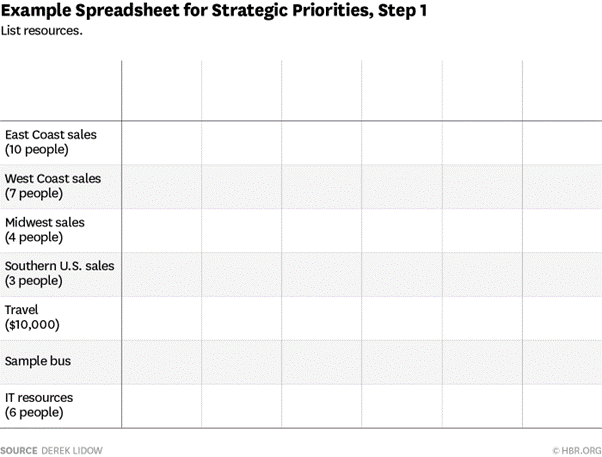
List across the top row the projects, improvements, or initiatives you want to accomplish with those resources with any existing time constraints. For example, you might write, “Renew clients in all four regions; win a contract with IBM by the time your new plant opens on March 1; get Salesforce.com in all regions but on a staggered schedule.”

Indicate in the appropriate cell how the available resources would be allocated in a scenario where everything proceeds as expected. For example, three salespeople in each region might be devoted to renewing customer contracts, while seven salespeople, the sample bus, and half of the travel budget might go toward winning the IBM contract.
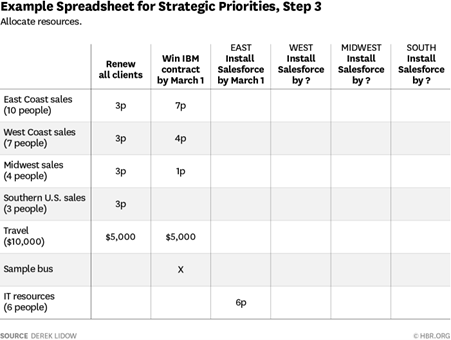
Declare which one or two projects are critical, designating which additional resources from the matrix can be called upon by the critical projects when and if needed. (If you declare more than one project critical, you must keep in mind that they cannot potentially depend upon the same pool of on-call resources.) For example, if the IBM contract is critical, you would ask the project head — in this case, your lead IBM salesperson — what additional resources might conceivably be needed if the going gets tough and where those resources might come. That could include some of the IT resources from the Salesforce implementation on the East Coast, which means that the Salesforce effort is now categorized as desirable and that you cannot expect your people to fulfill the objective by a certain time. Projects that are not critical but aren’t on call to potentially provide resources to a critical project now fall into the important category, where time or the objective is flexible.
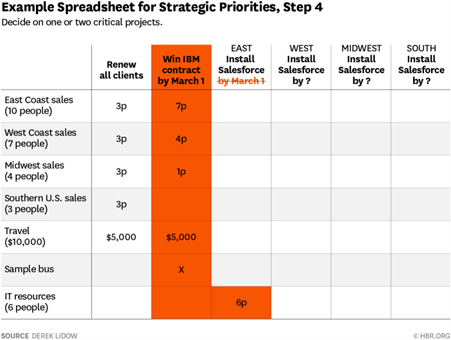
As the projects and resources are listed and the group figures out how best to allocate resources and time constraints among the potential initiatives, this matrix becomes a strategy document. As projects are completed, leaders can revisit the process to reallocate resources that have been freed up. They can also reallocate resources if a crisis occurs — which by definition creates a critical priority. The same is true with a change of strategy.
The transparent allocation of resources and the specifying of responses to changed conditions align the team and head off dissension. Managers no longer feel that giving up resources reduces their status. They are playing an essential role in executing a critical priority. And they are content to be governed by the fair, inexorable logic of realistic priority setting instead of rank ordering that doesn’t add up.”
To access the original article, please visit: hbr.org

Online Article
Medium.com
“How to Prioritize Business Requirements
The prioritization of requirements must be influenced by the needs of the stakeholders, thus ensuring that the maximum value is reached.
Software requirement prioritization is one of the challenges faced by the Business Analyst. For being an ongoing process, with priorities changing as the context changes, it can be a source of problems if the stakeholders are not engaged in determining the requirement importance.
The BABOK® Guide version 3, in “Requirements Life Cycle Management”, presents the following elements for to prioritize requirements:
Recognize the factors that must influence the requirements prioritization
As the basis of prioritization, the Business Analyst needs to identify the typical factors that must influences it, such as:
• Benefit: requirements that offer the most benefits.
• Penalty: requirements that meet regulatory or policy demands imposed on the organization.
• Cost: take into consideration the effort and resources needed to implement.
• Risk: requirements that minimize the risks involved.
• Dependencies: requirements that cannot be satisfied unless the other requirement is fulfilled.
• Time Sensitivity: requirements that need to be delivered before a certain date.
• Stability: establish a lower priority for unstable requirements to avoid rework and wasted effort.
• Regulatory or Policy Compliance: requirements that must be implemented in order to meet regulatory or policy demands imposed on the organization.
Identify the challenges of prioritization
The prioritization of requirements is an arduous task, an assessment of relative value, that involves some challenges, such as:
• Conflict amongst stakeholders: Sometimes, the stakeholder may value requirements differently, what is most important for one stakeholder, can be not interesting for another.
• Difficult to define priority: For some stakeholders are difficult to define what is most important in a project, where sometimes, all requirements became a priority or less important requirements are put in place of another really important requirement.
• Stakeholders that try to influence the result: It´s possible that stakeholders may (intentionally or unintentionally) indicate a priority to influence the result to their desired outcome.
For all factors above, will be required abilities as negotiation and conflict resolution to mediate a correct prioritization.
Keep a continuing prioritization
Priorities tend to vary as the change evolves, old requirements are met, and new requirements emerge. Therefore, the Business Analyst must maintain a continuous service of prioritization with the stakeholders on different levels, such as:
• Initial stage: prioritization is done at a higher level of abstraction.
• After requirements refined: prioritization is done at a more granular level.
• Implementation stage: re-prioritization based on the sequence in which they must be implemented due to technical constraints.
Prioritization is an important step in Business Analysis. It must involve the stakeholders, requirements analysis and understand the effect of different factors that may interfere in the requirements order implementation importance, ensuring the maximum value is achieved.”
To access the original article, please visit: medium.com

Online Article
Harvard Business Review
“A 4-Step Process to Help Senior Teams Prioritize Decisions
Leaders and their teams often pride themselves on their ability to deal with an onslaught of decisions. But the reality is they often end up making rapid-fire calls on issues big and small and wasting their time. They and their organizations would be better served by an approach that treats decisions as a deliberately structured workstream.
Consider the experience of one of the world’s largest footwear manufacturers, whose leaders engaged in an exercise that others can use to revamp the way they make decisions. In its fast-changing industry, big challenges loomed on many fronts. Computer-driven, automated manufacturing that could make reshoring of factories feasible threatened to redraw the supply-chain map. Advanced materials and new construction methods were bringing far greater complexity to manufacturing processes. Product innovations (such as sensors in athletic shoes to detect incipient injury) could add additional layers of complexity. And like all organizations, the manufacturer also faced a steady stream of more mundane challenges: how to comply with product specifications from customers, improve yields at underperforming sites, or refurbish corporate headquarters.
All such issues require decisions — and in some cases, a series of decisions — that differ in magnitude, urgency, and complexity. But in the culture of firefighting that had developed at the company, decisions were treated in isolation or in response to day-to-day developments in the business. Moreover, managers and teams were unsure who owned what decisions, constantly kicking them upstairs and putting more demands on the senior team. As a result, the team found itself handling everything from big-picture questions like how much to invest in the “factory of the future” to far-less-momentous issues like equipment purchases to improve the throughput of a single production line.
Recognizing that ensuring high-quality decisions would require a disciplined process, the executive team embarked on an exercise designed to create a repeatable process for prioritizing decisions and determine the right methodology for each. It consists of these four steps:
1. Compile a list.
Create a list of the decisions likely to arise in coming months, without regard for their significance — everything from major capital investments to promotions to when to hold the next all-hands meeting. Although most large organizations may have defined processes for this, rapidly-changing situations, short-term crises, and urgent needs from customers can overwhelm the team’s agenda. Often they also fail to consider the behavioral aspects of team dynamics — for example, how various members exert their power to get their issues on the agenda. Dynamics between teams can come into play as well: For example, how does a senior regional team interact with the global team?
For the footwear manufacturer, the exercise turned out to be less straightforward than it initially appeared. Using a time horizon of 12 months, members of the senior team offered lists that differed widely. Disagreement emerged about which decisions fell within the specified time frame. Many members listed numerous issues that they expected to bubble up from within their functions. And it soon became clear that little agreement existed about who owned which decisions in the company.
But once the team had compiled the list and become aware of all the decisions members felt needed to be addressed, they could remove duplications and combine similar decisions into more coordinated, larger decisions. For instance, the list included a decision about embarking on a process-innovation strategy and one about bringing the production process closer to the customer. The process-innovation question was then rolled up into a larger decision about a broader customer-centric strategy.
2. Understand their characteristics.
Ultimately, some 26 decisions emerged from the first step. The team then characterized them according to four criteria — magnitude, organizational complexity, analytical complexity, and subject-matter challenge — and used a point system to assign each decision a score.
For magnitude, the metrics included size of capital investment or operational expenditure and time to expected benefits; the greater the investment or longer the time-to-benefit, the higher the point score. Measures of organizational complexity included number of stakeholder groups involved, their degree of alignment, degree of power, and the degree of effort required to achieve alignment, with point scores escalating accordingly. Measures of analytical complexity included quality of relevant data, degree of uncertainty, number of alternatives, and degree of clarity in measures of value, again with escalating point scores. Measures of content challenge included the team’s degree of familiarity with the business or technical issues involved; the less familiarity, the higher the score.
3. Sort them into three categories.
Based on the scores that resulted, the team could assign each of the 26 decisions to one of three categories, each of which requires a distinct decision-making process:
Strategic. These highest-scoring decisions, entailing a great deal of both organizational and analytical complexity, are usually the relatively small number of decisions that will determine the long-term direction of the company. For the footwear manufacturer, these strategic decisions included where and how to deploy automation and the location of factories for proximity to customers. Such decisions require addressing complex organizational challenges such as multiple, often-conflicting stakeholders with differing values, experiences, or cultural needs. Further, these decisions also have considerable analytical complexity such as large, often-incomplete data with considerable ranges of uncertainty.
Strategic decisions usually require the most time and attention of senior teams as well as a rigorous, comprehensive, and uniform decision-making process. Such a process frames the question accurately, generates multiple alternatives (including hybrids of two or more alternatives), generates a wide range of information from experts inside and outside the organization, identifies values and trade-offs, uses sound reasoning (not “gut feel”) that takes uncertainty and risk into account, and concludes with a commitment to action.
Significant. These decisions score in the middle range, require a sound business case, and together can add up to considerable investment. Typical significant decisions include such issues as sourcing, new products, and make-or-buy IT investments. The decision-making process may not require an in-depth application of each step in the strategic-decision-making process. Rather the process should be tailored, depending on the nature of each significant decision.
For significant decisions that are organizationally complex but involve little analytical complexity, the process should focus on the best means for bringing people along and getting buy-in. For the footwear manufacturer, choosing an approach to ERP implementation represented such a decision.
Significant decisions characterized by a high degree of analytical complexity but low organizational complexity require leading-edge data capture and cleansing, as well as the right value-focused analytics. For the manufacturer, that included decisions about energy and water solutions as part of the company’s drive for sustainability.
Quick. These decisions score low on both organizational and analytical complexity and may be addressed by defining procedures that describe the approach needed or that have well defined rules, regulations, checklists, and the like. How to deal with a production process that is drifting out of spec falls into this category. These quick decisions can often be delegated to lower levels in the organization, freeing time for the senior team to focus on strategic and significant decisions.
All upper-tier teams face all three categories of decisions. The kind of decision doesn’t necessarily correlate with where in the organization it should be addressed but with the appropriate way to solve it.
4. Understand the timing.
Once the decisions were defined and categorized, the footwear manufacturer’s senior team could see clearly when each needed to be addressed. By defining time horizons of three, six, and nine months, the team could defer decisions that were not immediately needed and address them at the appropriate point. For example, the team determined that key promotions, which would take into account the change-management abilities of candidates, needed to be addressed ahead of ERP implementation strategy.
When teams consider and score the decisions they face in terms of organizational and analytical complexity, the majority of decisions usually turn out to be classified as significant. Further, with a mechanism in place for characterizing decisions in terms of organizational and analytical complexity in the future, the team can treat decisions as a workflow, which they can periodically review and update. And by defining the most efficient and effective process for dealing with them, the team can free more time for attention to strategic, high-impact decisions. The appropriate delegation of decisions can free even more time. In the case of the footwear manufacturer, the CEO could assure team members that a whole cluster of decisions could be comfortably taken at the departmental level instead of requiring the approval of the entire senior team or him.
Understanding where to focus and when is one of the most important things a senior team can do. As the leadership team of the footwear manufacturer learned, creating and managing a decision agenda is one of the fastest and most efficient ways to do it.”
To access the original article, please visit: hbr.org
Course Manuals 1-12
Course Manual 1: Defining a Need
Four Needs of the Organization
How do you make your staff more powerful? You manage to integrate the four needs of the individual, the four needs of the organization, and the business’s goal, vision, and values. From Effectiveness to Greatness: The Eighth Habit The four demands of the person and the organization — the BODY, MIND, HEART, and SPIRIT — are discussed in Stephen R. Covey’s book Shape.
Key Take Aways
Here are the key take aways:
• Unleash the individual. Know how the four needs relate to the individual.
• Unleash the organization. Know how the four needs relate to the organization.
• Know Maslow’s Hierarchy of Needs. I think that Maslow’s Hierarchy of Needs is complimentary. If individuals are struggling with the basics, then it’s tough to get their full potential.
Because it corresponds to what everyone should attempt to do with their teams, this is very significant. The organization, the people on your teams, and your clients’ quality of life can all be improved.
The Four Needs of the Individual
Covey writes about the four needs of the individual:
“Remember that only those people who are allowed to tap into the needs and motivation of all four parts of their nature will find their voice and volunteer their highest contributions. For the body, the need and motivation is survival — economic prosperity; for the mind, growth and development; for the heart, love and relationships; and for the spirit, meaning, integrity and contribution.”
The Four Needs of the Organization
Covey describes the four organizational demands as follows:
1. (BODY) Survival — financial health.
2. (MIND) Growth and development — economic growth, customer growth, innovation of new products and services, increasing professional and institutional competency.
3. (HEART) Relationships — strong synergy, strong external networks, and partnering, teamwork, trust, caring, valuing differences.
4. (SPIRIT) Meaning, integrity and contribution — serving and lifting all stakeholders: customers, suppliers, employees and their families, communities, society — making a difference in the world.
Universal Mission Statement
Covey writes:
“The key to unleashing the power of the workforce is what I call co-missioning. It’s clarifying the mission, vision, and values of the organization in a way that overlaps the four needs of the individuals with the four needs of the organization. Every person’s job in the organization ought to be co-missioned to explicitly meet the four needs of both the person and the organization. An implicit Universal Mission Statement would need to be something like this:
‘To improve the economic well-being and quality of life of all stakeholders.’
Your organization’s, department’s, team’s, or family’s mission statement would not only embody the spirit of the universal mission statement, but would also represent how you uniquely do that — your unique gift, capacity, niche — your voice.”
The big idea here is to unify the four needs of the individual with the four needs of the organization. The net effect is synergy and leverage.

Organizational Development Needs Analysis
Your need to address the organization’s future demands in accordance with its strategic goals and business plan drives the Organizational Development Needs Analysis (ODNA). When you have numerous conflicting needs, it enables you to set priorities and choose where to direct your limited time, energy, and resources. As a prelude to assembling company leaders, it can be successfully paired with senior team strategy.
What is Organizational Development Needs Analysis?
Planning your organization’s development needs through organizational development needs analysis (or ODNA) entails:
• Clarifying where you are now, and where you want to be
• Assessing the gap between them
• Identifying the challenges or obstacles in your way
• Developing a plan for bridging the gap
What are the benefits of Organizational Development Needs Analysis?
• All learning and development plans are aligned with the organization’s goals
• You gain a greater understanding of the organizational, department, team and individual needs.
• It focuses on ‘right first time’ which achieves efficiencies and avoids costly mistakes.
• You get an insight into wider issues that are impacting performance and how to address these through training and non-training interventions.
How do you carry out an ODNA?
Context
To determine where you want to be, you would evaluate your short-term and long-term objectives. This phase involves holding a meeting with representatives from several organizational divisions to understand the objectives, procedures, and difficulties. Being open and honest at this point is crucial since the knowledge gathered lays a solid basis for the remainder of the procedure.
Research
Then you will conduct more extensive research to determine the unique requirements of particular departments and teams. Depending on the time and resources available, this can involve some or all of the following:
• Meetings with employees, managers and key stakeholders or clients
• Observations and shadowing
• Surveys or questionnaires
• Focus group discussions
• Analysis of job descriptions, charters and SLAs
• Going through the department’s succession plan
• Gaining understanding of planned or anticipated changes
• Budget assessment
For the purpose of ensuring that the appropriate decisions are taken, this information must be gathered.
Analysis
You would examine the data gathered and evaluate each department’s immediate, long-term, and future development needs. When significant persons have been identified, this analysis may be conducted for the department as a whole or occasionally on an individual basis.
Report
The ODNA process ends with the creation of a report outlining your results and offering suggestions for closing the gap between “where you are now” and “where you want to be.” In addition to strategic planning concerns like goal-setting, decision-making, prioritizing, communicating, and managing environmental challenges as necessary, this will include learning and development strategies.
What does an ODNA report include?
Your ODNA reports shouldn’t only highlight the development solutions that were actually implemented. Many people firmly believe in the importance of self-driven and on-the-job development, and you will be able to suggest particular personal development activities like in-house shadowing, mentoring, and coaching when necessary.
Senior team strategy
The best preparation for senior team strategy work is thorough analysis. Senior company leaders are often brought together for a one- or two-day meeting to ensure that they can agree on and implement a best practise approach to creating and accomplishing organizational goals as well as developing competency throughout the organization. Tools like scenario planning, interpersonal diagnostics, cultural effect assessments, the objectives quadrant action planning tool, consequence questions, systems and solution-focused coaching, action learning techniques, authentic leadership, and appreciative inquiry are among the ones you could employ.

Maslow’s Hierarchy of Needs
Every company wants its workers to have big ideas, put in a lot of effort, be motivated, and even inspire others. What do they therefore need in order to perform at their best? Abraham Maslow, a psychologist, may have given a blueprint.
Maslow created a psychological theory of human motivation, arguing that basic needs must be met before higher-level motivation or self-actualization can take place. Maslow’s five-tier hierarchical model goes from self-esteem and self-actualization to fundamental physiological necessities, safety, and belonging.

Individuals’ physiological (nutrition, health), safety (shelter, stability), and social (friendship, belonging) needs must be met before they may realize their full potential.
The same rules hold true for business. Employees’ fundamental needs must come first if they are to develop and perform to the best of their abilities.
Maslow’s Hierarchy of Needs can be used to demonstrate how to support employees in achieving the highest degrees of self-actualization, allowing firms to succeed and prosper financially.
The explanation
SURVIVAL: the least important organizational need. An organization will fail if it does not have the resources to remain operational. Everything else is secondary.
STABILITY: At this stage, all that matters is for the company to maintain their market acceptance while making sure they don’t lose their current clientele, lest they go back into survival mode. the requirement for structures that will fuel the organization’s rapid expansion.
GROWTH: combining commercial objectives. Needs for relatedness. At this stage, growth goes much beyond revenue growth. The emphasis is considerably more on mental and emotional development. It is an expansion of knowledge, skills, understanding, and capacities.
DOMINANCE: the requirement to hold the largest proportion of the market. lucrative virality.
PERPETUATION: the requirement to stay current with both economic and technical revolutions. the requirement to outlive the corporate longevity cap.
PLEASE NOTE
1. The hierarchy of organizational needs is flexible because we believe it is possible for an organization to be working on their growth needs even when their stability need remains to be met.
2. The hierarchy of organizational needs also takes into consideration the fact that an organizational that has progressed through certain levels of needs can retrogress, declining to Survival. The ones who ignore the flexibility of each level almost always sink into oblivion.
3. The hierarchy of organizational needs does not apply to individuals selling their skills. It refers to organizations. You must run your business or initiative like an organization, at least if business growth is part of your dream.
Business Application of Maslow’s Hierarchy

Maslow’s Need: PHYSIOLOGICAL
Business Application: safe working conditions. adequate illumination. tidy facilities Airflow. Heat. the greatest equipment for the job.
Example: Google includes a gaming lounge, organic gardens, electric cars, and bicycles for personnel to use to travel to meetings. The corporation is constantly looking for methods to enhance the health, well-being, and morale of its Googlers in order to make their lives as comfortable as possible.
Maslow’s Need: SAFETY
Business Application: Respect your coworkers at work. Give them the freedom to take chances without receiving harsh feedback or humiliation.
Example: It says a lot about Mark Zuckerberg’s business practices that the CEO of Facebook, one of the most dynamic and rapidly expanding corporations in the world, is meeting with entry-level workers. Facebook values everyone’s thoughts in distinct and definite ways rather than classifying people into categories based on their age and experience.
Maslow’s need: BELONGING
Business Application: Allow everyone a chance to be heard. Establish a sense of neighborhood. The things that coworkers do are a part of something greater. They are fully aware of the importance of a mission driven by values.
Example: The Corporate Social Responsibility team of HBO brings together staff members, celebrities, and non-profit partners to address social challenges affecting their communities and industry. Top-down leadership motivates staff to spread knowledge, take initiative, and improve the world.
Maslow’s need: ESTEEM
Business Application: Empowerment. public acclaim. programs for recognizing employees. Realizing how important each person’s role is to the overall success of the business. making each person feel appreciated and significant.
Example: Southwest empowers employees to take whatever necessary steps to realize this objective by giving them “permission” to go above and beyond to satisfy consumers.
Maslow’s need: SELF-ACTUALIZATION
Business Application: Give staff members the freedom to think broadly, be imaginative, have an eye toward the future, reinvent themselves, and offer direct feedback to top leadership.
Example: One of the most cutting-edge working environments is what Google gives its employees. The company is so committed to innovation that it has established nine innovation principles. One of their guiding principles encourages Google employees to devote 20% of their time to exploring novel ideas that they are enthusiastic about. This has led to the creation of services and products including Google News, Google Alerts, and Google Maps Street View.
Maslow’s hierarchy of needs serves as a reminder that in order to be effective, leaders and their organizations must adopt a “outward mindset”—looking at the world through the eyes of their stakeholders—while establishing, outlining, and exemplifying clear and quantifiable values, standards, and expectations. To foster a culture where individuals are trusted and encouraged in their quest of greatness, it is crucial to make an effort to comprehend the physiological, safety, belonging, and esteem needs of those stakeholders.
establishing a “participatory management” paradigm, in which staff members are involved in decision-making and their advice is sought for and valued. The genuine commitment that all leaders require to maximize their organization’s success will come about when they believe that they are as vital as the work they accomplish. Although leaders constantly express a desire for collaboration, they frequently overlook their own contribution to creating a positive team environment that fosters performance and results. They must be aware of and proactive in addressing their stakeholders’ physiological, safety, belonging, and esteem demands.
The best businesses cultivate workplaces where employees are treated with respect and dignity, where everyone feels heard and empowered, where everyone knows their role and how it fits into something greater than themselves, where taking risks is not a source of fear, and where there is a sense of ownership. Working to meet these demands enables businesses and brands to succeed while empowering people to be their best selves.

How do I know if my organization is at the SURVIVAL level?
Getting consumers and providing the contracted product or service are the business’s key difficulties at this time.
Among the crucial questions are:
• Can we get enough customers, deliver our products, and provide services well enough to become a viable business?
• Can we expand from that one key customer or pilot production process to a much broader sales base?
• Do we have enough money to cover the considerable cash demands of this start-up phase?
To exit the survival level fast enough
1. You must have a distinct market offering. One that people will pay for (not theoretically, but actual payment)
2. Your products or service must be duplicable and scalable quick.
Humans are not scalable. You shouldn’t spend the same amount of energy required to deliver to different customers if your business will be scalable. What is the ease of multiplying what you do?
3. Gain paying customers fast and keep them.
4. Keep your financial records.
5. Do not be all things to all men.
6. Manage your overhead
7. Do what works. Iterate and pivot fast. Very important.
8. Manage your debt.
Keep in mind that intentions and ideas have no monetary worth. Implement adjustments quickly and assemble a team as needed.
When you obtain significant cash, little is likely to change in your fundamentals if you can’t periodically make do with just a few paying clients.

Course Manual 2: Organizational Priorities
Prioritizing needs internal to your organization
Intentional or not, your workspace is going to communicate the priorities of your company. Start by identifying what is unique about yours.
Early in the design phase, priorities are established and requirements are specified; this aligns the team and sets the course for the future. Priorities that are established early on can be more easily achieved and greatly improve the odds of experiencing a wide variety of success.
Priorities should be specific to each company. Our workplaces communicate with us and evoke emotion when we enter. Our experience—what we see, how we feel, and what we take in when we enter a space—transmits these very subtle clues and messages.
Priorities might include everything from aligning the organization, fostering engagement, fostering creativity, luring talent, reaffirming leadership, revealing history, and enhancing performance to delivering a message, setting goals, cultivating trust, and providing transparency. Workspace is one of the few physical tools we have that establishes the stage or platform for how we do business. It creates the context and defines the work that we accomplish. It also serves as a tool for communicating the organization’s goal. One of the most effective strategies used by leadership to change the foundation of the organization and influence team behavior is to create the ideal physical environment.
The area honors and motivates those who are working; everyone shares their experiences.
We are all well aware of the changes in the workplace. We can complete our task without being in the office today.
The modern workplace is all about business, commerce, and engagement; it needs a narrative, authenticity that celebrates the good or service, the values, the culture, the message, and the purpose, and it pays close attention to the particulars of the firm. Everyone shares the experience, should be aware of their shared purpose, and the place should help to create alignment throughout the business. It honors and inspires those who are doing the work.
Failure to take into account the features that make a company unique when building a new workplace might hinder an organization. When top talent feels uninspired, struggles to communicate, and leaves, it may indicate that you won’t be able to adapt or adjust and may even spell the end for the organization.
Avoiding the wrong priorities
It is simple to become mired in urgent concerns with a narrow focus on immediate objectives. Although they might contribute to the accomplishment of a significant goal, they fall short of the organization’s long-term objectives. To put it another way, they are diversions that originate from many places.
For instance, leadership will lose out on crucial workplace alignment, operational improvements, and value-building opportunities if they are preoccupied with critical cost or scheduling challenges. Start early if you want to avoid this. Too many organizations wait until it’s too late and then discover that they don’t have enough time to properly plan, missing out on the potential benefits and unintentionally doing the organization considerable harm.
Cost is significant and must be managed, but no company exists merely to reduce costs; there is always a greater goal. It’s your responsibility to pinpoint what makes that idea special and convey it to the designers so they can convey it through your place.
Unfortunately, most organizations still look at the office space as an overhead expense.
Unfortunately, the majority of businesses still consider office expenses to be overhead. Efficiency, standards, automation, and a “production line mindset” are the byproducts of “Tayloristic” thinking in the majority of American workplaces that are still in use today. That was effective when administrative duties dominated the workplace, but times have changed. You must consider which is more advantageous for the organization: creating a low-cost environment or creating an environment that draws the greatest talent and enables them to perform at greater levels? Each of your priorities should be evaluated using a similar type of question, and they should be set in accordance with your aims.
Furthermore, priorities that alter, are unclear, conflict, or are not clearly expressed cannot be accomplished. The project will not function as planned since the team and the users will get mixed messages and become confused. The likelihood that the initiative won’t result in any appreciable changes for the business drastically restricts the potential benefits that the new workplace might offer.
Finding the critical objectives that will have a long-term influence on bringing people together and creating value and then adhering to them is a difficulty when there are several and/or competing agendas. To move the organization ahead, you must take a broad view of your aims.

How to focus and act on the right priorities
So how can a modern corporation best position itself to prevail in the fiercely cutthroat environment in which we now live and work? How can a company improve performance while motivating its personnel to do great things?
Recognizing that the workplace is the only location where everything about your company communicates with your people is the first and most crucial step. All of these things originate from (and link to) a central location, including people (including customers), leadership, brand, ideas, innovation, products and services, operations, support, marketing, communications, meetings, operations, and technology.
Cars and trucks are familiar to us all. There are tens of thousands of unique cars and trucks on the road. Style, comfort, and efficiency, the ability to haul, history, workmanship, safety, engineering, and performance are all unique features that each one offers. The demand for or definition of performance for one individual may be quite different from that of another. We identify with a certain design, attribute, or performance class of automobile.
Much like a high- performance car, the workplace is a tool that can align and supercharge an organization.
Commercial office space has similar needs to residential spaces, but there are many fewer models to choose from. Similar to how everyone drives a Ford Taurus in commercial office buildings, where affordable mobility and effective productivity are the primary factors. Some people may be fine with that, but most firms today need more because of the intense competition. A Formula One racecar is a better comparison for your skills, operations, brand, culture, and other competitive criteria. a well-designed platform with excellent performance and comfort that is much more competitive.
Building value and utilizing our workplaces to their full potential must become a priority if you want to keep your firm alive and remain competitive. The workplace is a tool that can align and supercharge a business, similar to a high-performance car. The workplace is the most crucial instrument a company has for raising performance, and there are numerous ways to do so. It all boils down to figuring out what the organization’s priorities are because each organization is different.
How then can you establish the proper priorities in this workplace that is changing so quickly? Here are some of the more tangible, prominent areas for ongoing priority evaluation:
People
Beyond technology, we are utterly dependent on the talent that exists within our organizations, nearly regardless of the industry we are in. Many leaders who still think in the old school frequently feel as though they are dependent on that talent. Talent is the lifeblood of our company; we can only be as successful as the talent we can attract and retain.
Tools
Beyond skill, there is an operational focus; the greatest tools are required to support talent. Your place of employment becomes crucial at this point. More significantly, your talent must believe that the setting is supportive and productive. You must provide a space where information can flow freely and ideas may be recorded.
Network
For the talent to discover the information they need, when they need it, you must establish a network that connects all of the knowledge and real-time information. Access to information that is not immediately available but may be fast changing as well as information needed for quick issue solving are both made possible via networks.
Supported platform
A supporting platform is required. This infrastructure consists of the mechanics, the technology division, the HR support, the special operational characteristics, and the consultants, all of whom increase the capabilities and offer backup, support, and extra resources. You must comprehend and enhance how these demands are identified, expressed, and met. The workplace’s design will either make these efforts to help individuals easier or harder, and this includes peer or peer support, the capacity to offer backup, and increased ability.
Training
Then, you must provide training to ensure that everyone is aware of the necessary information, the required conduct, all the protocols, and how to use the available tools, networks, and systems. There are many various ways for people to learn, such as one-on-one mentoring or in-depth classroom instruction, and the space needed for each is highly varied.

Lets examine some more high-level, organizational components that deserve proper evaluation and placement as right priorities:
The message
This is probably one of the most crucial and straightforward components. It’s crucial to explain to others what their profession entails. The workplace provides an occasion to celebrate that. People want to know that what they are doing has value and meaning, and they want to see a clear purpose. The workplace is an opportunity to unite and align the people who devote themselves while connecting and communicating with a wide spectrum of the organization.
You have the power to completely shape someone’s experience when they enter your place. You have the chance to share information with them about your business, employees, projects, or values. What occurs when someone enters your job is completely under your control.
When someone enters your area, how do you want them to feel? What kind of impression do you want to make? Do you have a story you would like to share? What message are you trying to get across? What story do you want them to tell their friends about your organization when they return home?
Given how particular your circumstance is, this should be carefully considered and developed. It calls for imagination and knowledge of your industry.
The culture
The culture of an organization is the culmination of all behaviors that are permitted or acceptable, and it is essential to the success of an organization. Whatever the presence of the leaders, an organization’s culture is described as the collection of permitted actions. It is the lowest common denominator of permissible behaviors. The organization’s collective conduct must be taken into account, managed, and steered. Finding people who share your beliefs and are in line with your goals will be made easier with the aid of this tool.
How do you anticipate people to act? How do you anticipate leaders to act?
The environments we utilize shape and support our behavior. What is the sense you have when you enter a room? Is it a warm and uplifting environment, or does it have a cold or even oppressive vibe? Does it feel more like you are entering your living room or a really guarded area? Is your brand represented in the same way as IBM or Disneyland are?
The way you behave in a simple conference room, such as by sitting at a table and paying attention to or interacting with the person at the head of the table, dictates how the meeting will proceed. People would behave significantly differently if the identical meeting was held in a setting more akin to a café. Taking those nuances into account is crucial for improving performance.
Organizational alignment
You assemble individuals with a range of experiences and backgrounds. Does everyone know what the organization’s goals and objectives are? Does everyone understand the importance of putting product or service quality first? Are everyone’s intentions and objectives aligned? The area can clearly outline, aid in communicating, and clarify those aims.
Operational efficiency
It’s critical to have the appropriate skill sets and support in place to reduce waste and raise service or product quality. This would take place on several levels and aim to comprehend how work is carried out, including the crucial procedures and the capacity of talent to create efficiencies through proximity or organization, with all necessary resources and assistance positioned in the most advantageous settings. Depending on the business, it could entail identifying particular jobs or activities and designing spaces that can best support them.
Choice
Choice is a hot topic right now. We simply don’t have all the tools we need at our desks to do our jobs nowadays. We need to relocate to spaces that are better suited to the task at hand because we no longer spend the entire day sitting at our desks. Our ability to move around and participate in a greater variety of duties is expanding. The workplace has to offer a variety of settings that enable us to work at our most best. As much as it is about leadership and performance, this is also about empowerment. The best talent needs to be attracted, then given the freedom to execute their tasks.
Community
The term “community” is used here in the broadest meaning. We interact with many different communities, and the advantages are spread out in many different ways. But the capacity for innovation represents the single greatest opportunity. Innovation is not possible in a vacuum. You need a mixture, including different individuals, ideas, and serendipity. The success of your company depends on how you engage with various communities.
Health and well-being
Let’s face it: the office has never been a very healthy environment, and it never was. We are now understanding, however, that certain features of the workplace, if left unaddressed, can potentially harm employees over time. The human state is not improved by stress, inactivity, a lack of natural light and fresh air, and other factors. The conclusion that happy, healthy people will do better than sad, unhealthy people is obvious. How to maintain people’s peak performance is thus a key factor.
Attraction and retention
There is no doubt that any company would perform significantly better if it can attract the greatest talent. The simplest approach to do that is to create an environment where talent is attracted to and performs best. If the tools and circumstances are not suitable for the work that they are enthusiastic about, the top talent will not endure or remain the best.
Innovation
We live in a world that is changing very quickly and is filled with a ton of information. Today’s businesses rely on the quick processing and iteration of such data. Anything that slows down the rate of that interchange will hinder our capacity to learn, grow, and effectively compete, thus the workplace’s design must enable it. Long-term corporate sustainability is crucial, and the workplace is the one setting where transforming information into knowledge and skill should be made simple.
Set the priorities early and keep them straight, and the sky’s the limit.
Performance depends on getting the aforementioned elements correct, which can take time and be challenging. The simple solution is to replicate what everyone else is doing; nevertheless, this strategy is unlikely to be successful. Your particular workplace needs to incorporate a number of distinctive influences and features of your company.
Realize that work can be done anywhere while planning your future workspace. Even while offices are no longer necessary for people to work in, they won’t disappear anytime soon. It will be put to quite different uses. Understanding the most crucial elements that help your organization develop and endure is crucial, as is making sure that they are given the appropriate priority.
In my practice, I encounter far too many businesses that lack the time or comprehend the value proposition of their workplace only in part. A lot of these jobs in some of these organizations are divided up and evaluated only according to cost. They employ professionals who, without having a thorough understanding of what matters most to a firm, faithfully carry out transactions and designs. It’s important to create an environment that will draw the brightest minds, empower them, and allow them to collaborate and perform at their best rather than just choosing a location that meets all the criteria and checks the boxes. The debate is no longer between a private and an open office. It’s all about fostering community and knowledge exchange.
The possibilities are endless if you establish your priorities early and maintain them.

Course Manual 3: Purpose and Vision
Defining the Strategic and Organizational Vision
Every vision begins with a visionary leader (or group of leaders) who has the capacity to visualize and articulate idealized future situations. It’s crucial for visionary leaders to communicate their vision to all of their stakeholders, including clients, vendors, and staff.
The board of directors needs to comprehend how crucial it is to give the mission, vision, and values statements adequate thought. Everything else they do is based on their vision statement. The vision statement is the source of long-term guidance for employees.
Businesses are set up to be profitable and to serve the interests of their shareholders. Beyond that, a lot of businesses are also interested in a lot of other things. A long-term perspective on business implies that the organization wants to cater to clients who share its values. A vision statement takes into account the traits and way of life of the clients they serve as well as the situation of the market.
The strategic vision planning process includes writing a vision statement. It necessitates preparation, thinking, and time. Boards of directors should give the crafting of their vision statements enough time because it’s an essential step in developing a company. A written declaration that outlines the direction a company is taking and the final product is known as a vision statement.
The length of a vision statement might vary. The scope of the company can be inferred from how long the vision statement is. A company’s mission statement, goals, and aspirations are all outlined in a vision statement.
The majority of vision statement writers find the process to be satisfying and motivating. It gives them the ability to describe the traits that affect the strategy of the firm. As it affects many other areas of the business, creating the vision statement should be a tough task.
A vision statement is something to be proud of and to share with others. The organization’s values and commitment to attaining its objectives are communicated through the vision.
You should be happy to present your vision statement in a prominent location on your website, letterhead, invoices, and other papers. Some businesses display their vision statements on the walls of their offices and on corporate vehicles in an effort to build a culture around the declaration. All of your stakeholders—employees, clients, and suppliers—should be aware of and appreciative of your vision statement.
Why Is a Vision Statement Important?
A vision statement is more than a writing exercise. It clarifies the primary reason for a company’s existence and increases the significance of the work. One of the key goals of a vision statement is to assist an organization attract and retain enthusiastic, like-minded personnel. Companies can more easily work to strengthen the culture by creating an acceptable organizational vision culture and a vision statement. A business vision statement provides everyone with clarity regarding the broad picture, which creates the conditions for better decision-making and customer targeting.

Organizational Purpose
A framework for purpose: The 5P’s
Making a mission statement or starting a purpose endeavor is not that difficult. Most organizations have at some point attempted to identify their purpose, and many believe it is crucial to make sure that the company’s purpose is ingrained in all it does. Leaders are aware that’s not simple, though. Maybe for this reason businesses declare purpose changes so frequently. One CEO of a European group told us, “At this point, they just wash over me. We’ve had so many purpose initiatives. An effective analogy is transformations; over 70% of them fall short of their stated objectives, largely because they fail to alter—and sometimes even refuse to consider altering—employee mindsets and behaviors. Your organization’s purpose should be systemic, logical, and emotional at the same time. It should connect with its members and guide their decision-making. Five key components are essential:
1. Portfolio strategy and products: the products and services your organization provides, and the “where to play” and “how to play” choices you make to best serve your customers
2. People and culture: the talent—and the talent management—your firm deploys
3. Processes and systems: the operational processes you adapt to meet purpose-related targets; the ways you ensure that behavior up and down your value chain is in line with your purpose
4. Performance metrics: the target metrics and incentives you use to measure what you wish to achieve, how your firm is progressing, and the way you create and distribute incentives to make your organization’s purpose tangible
5. Positions and engagement: how you align your external positions and affiliations to be consistent with, and consistently deliver on, the purpose your company has defined
These elements are depicted in the exhibit below.
Exhibit
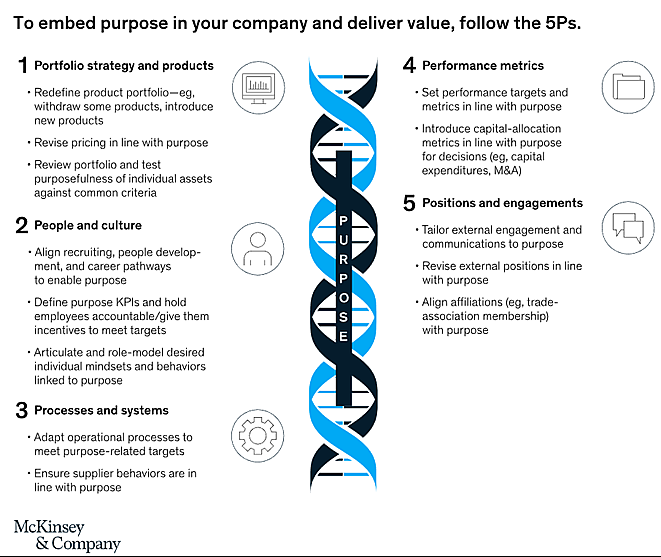
Over time, these five levers consistently increase purpose, but they must be diligently and frequently changed. Don’t fool yourself; there may be difficult choices to make and frequently difficult trade-offs as well. In every situation, begin by identifying the sources of your company’s strength and focus on its weaknesses. Then, programmatically develop your purpose infrastructure.
1. Portfolio strategy and products
There are two steps to demonstrating purpose in the goods and services you provide. First, check that the goals of your organization and your business portfolio are compatible. Almost all businesses can find ways to actively and purposefully modify their business mix, even though most won’t be able to start from scratch in terms of the markets and industries in which they compete. Second, after selecting your portfolio, fill out its businesses with goods and services that align with the goals of your firm and eliminate those that don’t. Avoid approaching your mission with an attitude that says, “This is the hand I’ve been dealt.” Of course, the endowment of your business counts, but you have more freedom than you may think in deciding what your business does and how it can contribute to society.
Think about BP. Since its establishment in the extractive industries more than a century ago, the erstwhile British Petroleum has been an energy firm. However, bp has continued to rethink what an energy firm may be despite being restricted by its past. The company has made a sharp pivot, adopting “reimagining energy for people and planet” as its mission; it has not only exited its petrochemicals businesses but also announced a plan to significantly scale up its low-carbon energy businesses (such as bioenergy, hydrogen, and electric-vehicle charging) and shrink its legacy oil and gas businesses by 40% by 2030. This will put the company on a path to becoming a net-zero carbon emitter by 2050 or earlier.
In actuality, there is plenty of precedent for audacious, goal-based portfolio changes. For instance, the Netherlands-based DSM (Dutch State Mines), which was initially founded to mine coal, has developed over a century into one of Europe’s major bulk chemicals corporations. However, DSM demonstrated that it could chart a very different road by deliberately going deep and insisting on a “triple bottom line” of people, planet, and profit. The corporation transformed itself into a cutting-edge specialty-chemicals leader between 2001 and 2015 by making more than 25 acquisitions in the food, feed, and nutrition sectors, in addition to divesting itself of industries like petrochemicals and ammonia.
Another example comes from S and P Global, which switched from a broader range of more generalized information and publishing businesses to a focus on research and analytics in order to achieve its purpose of accelerating progress in the world by providing intelligence that is necessary for businesses, governments, and people to make decisions with conviction. It remained an information company throughout the past ten years of transition, but it changed into a different kind of information corporation—one that was obviously more purposeful and aimed to satisfy the information needs of its stakeholders and larger society.
Making a bold choice to have a beneficial social impact might necessitate making difficult decisions, as was the case with CVS’s decision to remove cigarette products from its pharmacies in 2014. However, as evidenced by our research, strategic fortune favors the brave when assessed across industries and taken as a whole. In actuality, businesses with a stagnant portfolio consistently do poorly.
Few businesses have purpose as deeply ingrained as Patagonia. The outdoor clothing and equipment company in California has always been purpose-driven. It was the first business in its state to become a benefit corporation, a corporate structure that allows directors to legally extend their duty of loyalty to stakeholders other than shareholders. The company is also a certified B Corp. “Build the best product, cause no needless harm, utilize business to inspire and implement solutions to the environmental challenge” had been Patagonia’s motto for many years. But late in 2018, firm founder Yvon Chouinard added a bolder mission statement: “to save our home planet.” Purpose motivates Patagonia to diversify into other industries, such as food, in an effort to develop regenerative agriculture. Additionally, the brand publishes books and videos promoting environmental activism, as well as Patagonia Action Works (PAW), a platform for connecting volunteers with activist causes in various communities.
The example of Patagonia shows that your company’s mission should guide portfolio decisions and then guide your decisions regarding the goods and services you provide within those portfolio firms. By using the heuristics of superpower (“what is the unique method that our organization can produce value and drive progress?”) and vulnerability (“what choices could we make that would be particularly at odds with our stated purpose? “), you may improve the quality of your decision-making.
For instance, Alphabet places a high priority on its aim to encourage “independence and focus.” The removal of apps for personal loans with high annual percentage rates, like predatory payday loans, from the Google Play app store makes logical in light of this. Toy producers are successfully displacing dolls with exaggerated body ideals with more realistic options. Banks and other financial institutions respond to consumer demands by offering green insurance, green mortgages, and green vehicle loans. Swedish fintech company Doconomy, for instance, offers credit cards with CO2 emissions caps built right in. Purpose-washing? Not when an organization’s genuine, carried out mission is anchored to the goods and services it provides.
2. People and culture
People and culture may just as easily be regarded the first lever for embedding purposes as they are the second. Human beings are the source of purpose. Your supporters—all of your stakeholders, in fact—are your sources of strength and a strong deterrent to being untruthful. Employee emotion is thus frequently the most powerful factor undermining false claims of purposefulness. Consider organizations that are digitally native and have strong, “change the world” mission statements, but they nevertheless get called out for having “bro cultures” or for exploiting labor sourced from jail systems while marketing aspirational messages. In other instances, businesses that have promoted diversity have subsequently come under fire for discriminatory practices on the job.
At certain moments, your people and culture can connect with your purpose. Hiring is where it all begins. Managers can actively search for candidates that share the principles that uphold the mission of the organization. According to a senior executive of one successful sportswear company, “We hire people who reflect the values of the company. We never hire bad people hoping we can change them.” People development and career routes should represent human resource decisions that are grounded in purpose; being consistent and sincere will promote a positive cycle throughout your organization. The mindsets and behaviors associated with the firm mission should be articulated and modeled by managers, who should also hold staff members accountable for achieving goals. Alignment with a firm’s purpose can’t just be “management saying some nice words and calling it a day,” as the CEO of one Asian company recently stated. However, good managers “get it done” when the organization decides what it wants from a key performance indicator (KPI).
Making decisions about your people and culture also entails seizing opportunities when they present themselves. When will BP give its employees real jobs? a bp employee raised her hand and stated during the 2019 annual general meeting. Shortly after, senior executive (and current CEO) Bernard Looney gave her a promotion to the position of “purpose engagement manager,” with the responsibility of collaborating with staff to advance the business’s mission of rethinking energy.
Purposeful organizations embrace, rather than stifle, the human condition’s search for meaning. According to our research, employees at organizations with a purpose are four times more engaged at work, which is a significant source of competitive advantage. Think about Best Buy. The consumer electronics shop was changed by its former CEO Hubert Joly to a model where customer service, fueled by the human touch, would be the differentiator. Under his leadership, the business moved to heavily invest in employee training, offer employee discounts to encourage its own people to buy, use, and then recommend products to others, and advance Geek Squad, vivacious employees who assist customers in choosing, installing, personalizing, and supporting Best Buy products. That reaffirmed Best Buy’s mission to improve lives via technology and contributed to the company’s improvement in both customer and employee satisfaction.
It is challenging to overstate the significance of employee dedication. Professor Alex Edmans of the London Business School has shown that firms that make considerable investments in employee well-being outperform their competitors’ stock returns by 2 to 3 percent annually. That makes sense; after all, if all they are doing is punching the clock, how passionate should we really expect our employees to be? Therefore, when PayPal CEO Dan Schulman significantly increased employee pay, perks, and made all employees shares in the company in 2019, he did it with a specific goal in mind. Customers and communities benefit from the energy that passionate employees exude.
Your employees can serve as your best progress indicators. Recent investigations into the banking sector are rife with instances of workers providing early warning signs of improper behavior, product misselling, and flawed product design. Many of these signs were either purposefully disregarded or received no attention. To effectively integrate purpose, you must make sure that your employees have the proper procedures and tools, supported by a “speak up” culture, to discover shortcomings.

3. Processes and systems
Processes and systems, the third lever, tackles a fundamental “how” (the operational initiatives, rewards, and governance frameworks) that a company business model depends on to generate value and achieve its goals. To maintain (or start) the purpose engine running, you need reliable systems. Of course, certain factors will depend on the industry and the firm. Food companies, for instance, can find and buy healthier foods from farmers and more environmentally friendly packaging materials from packaging providers. However, most businesses may include best practices, from cafeteria composting to paid leave for community service, regardless of industry.
Your system and process initiatives should follow suit, with careful consideration of both the present and the future. Consider Microsoft’s approach to reducing carbon emissions. The company already worked to be carbon neutral (a goal it achieved in 2012), but has since set even higher goals: by 2025, Microsoft expects to use only renewable energy at its data centers, buildings, and campuses; and by 2030, the company plans to electrify its entire global campus operations vehicle fleet. By 2030, the company has declared it will be carbon negative. While some businesses track carbon to produce little but significant “carbon-adjusted” financial reporting, Microsoft already charges its business divisions an internal carbon fee. The money from the evaluation is invested in additional carbon-reduction initiatives within the company and donated to environmental causes all over the world.
It is crucial to go outside the company’s boundaries when incorporating purpose into the procedures and systems of your business. For instance, Walmart’s Project Gigaton integrates its whole supply chain and wants to assist suppliers in removing one gigaton of greenhouse gases by 2030. Walmart specified six areas where suppliers should cut emissions as part of the initiative: energy, trash, packaging, forests, agriculture, and product use and design. Then, a portal was created to assist suppliers in tracking their emissions reductions. The emissions-reduction targets that suppliers set for themselves must be “SMART”—specific, measurable, achievable, relevant, and time-limited. Additionally, they must submit an annual progress report. Top performers are honored on Walmart’s sustainability hub website. Currently, there are hundreds of suppliers involved, and Walmart anticipates that number to grow.
Embedding purpose throughout the supply chain is proving to be a source of resilience, even in the face of COVID-19, as BHP’s CEO, Mike Henry, recently shared. BHP took action to support its small, local, and indigenous suppliers as soon as the epidemic started by lowering the payment periods from 30 days or more to seven days. The business attempted to assist these suppliers since it recognized that they would be at risk. That makes sense. In Henry’s words, “When [suppliers] have seen that we’re there for them in their time of need, they’ll be there for us in our time of need,” “And that’s what we’ve seen. They’ve invested greater effort to ensure that they can continue to support BHP and keep the commitments they’ve made to us.”
4. Performance metrics
Purpose can and should be properly measured. In actuality, this entails establishing the KPI’s that relate to the purpose of your business, monitoring them over time, and motivating your organization to achieve purpose-related goals. What is measured, as Peter Drucker famously said, is controlled. The opposite is likely even more accurate: whatever you want to manage needs to be assessed, and consistently. Companies mix purpose metrics with environmental, social, and governance (ESG) criteria far too frequently. While necessary, ESG reporting standards from independent bodies like the Sustainability Accounting Standards Board (SASB) and the Global Reporting Initiative (GRI) should never become the “tail” that wags the purposeful company’s dog. The specific metrics you track and measure should be driven by your internal sense of purpose. Your business is approaching purpose backwards if it starts with ESG reporting and then “backs into” one.
Since purpose is who and what your company is, it should guide not only daily operations but also allocation choices like capital investments and mergers and acquisitions as well as company-wide transformation projects. For instance, a number of energy corporations now link executive compensation to emissions. To use another example, a major retail bank was implicated in a national scandal involving other financial institutions in the nation that involved various regulatory violations. The bank’s underlying mission, its relationships with the general public and with specific clients, and how to identify, assess, and enhance its purpose-based performance were all seriously considered as a result of the intense negative publicity. Improving customer outcomes was one of the goals. Redesigning incentives was one method the bank orientated toward a more purposeful outcome. Prior to this, the bank’s incentive program featured volume-based goals. The bank considered lessening the importance of volume-based targets in performance evaluations to be crucial to its purpose shift, even if just symbolically. This change was not monetarily important. But, surprisingly, the bank continued to beat its peers in terms of financial performance after reducing the weight of volume-based criteria. More importantly than quantity was the quality of the purpose and the wide actions and attitudes that supported it. The bank now has a more balanced method for evaluating and rewarding the work of management and frontline employees. It takes into account a wider range of indicators relating to customer outcomes, such as the volume and depth of contacts with customers to better understand their demands.
Companies can employ a variety of tools and KPI’s, but because every purpose is unique, generic solutions virtually never have the same impact as those that are properly designed. Additionally, assessing and activating shouldn’t be restricted to financial rewards. Businesses can promote community involvement by recognizing locations and personnel who significantly advance the organization’s goals. Businesses can use behavioral economics to “nudge” customers toward good choices like conserving energy or reducing trash. Additionally, we’ve seen that merely demonstrating to staff members and other stakeholders how the company is faring on criteria like diversity or sustainability—information that can be presented succinctly in standardized reports—reinforces purpose and encourages further action.
Purpose can appear to be orthogonal, especially at the beginning of a purpose-focused effort, and it is reasonable to claim that this may have been the case in the past. However, purpose will feel more at ease if employees and other stakeholders are often presented with purpose-based metrics, such as the percentage of employees from underrepresented groups or contracts with minority suppliers or customers. It becomes accepted practice.
5. Positions and communications
What is true within your business should also be true outside of it: purpose should be ingrained in how your organization informs the public and interacts with them. Charges of “purpose washing” are most likely to surface within this “P,” which makes sense. Artificial purpose statements ring hollow, and stakeholders can tell when something is fake.
A significant opportunity for many businesses to take a much more visible stand on the “S” aspect of ESG and reinforce their social license to operate is presented by the growing ascendance of the belief-based consumer. One approach to achieve this is to think about the trade associations your company supports—or possibly no longer ought to. For instance, Royal Dutch Shell and BP both conducted in-depth examinations of the groups they were supporting and finally withdrew from a number of trade associations because they were seen to be at odds with the goals of the companies. Another option is to increase corporate giving and philanthropy while integrating these initiatives into your business strategy. By doing so in an authentic manner that is connected to your company’s superpower and visible to people around you, you may fortify your company’s ties to the community and enhance your social standing. For instance, General Mills partners with its employees in the communities where they live and work to share food expertise through its 150-year-old philanthropic foundation. In addition, “Project Ugnayan,” a private-sector collaboration working with hundreds of local businesses to help feed millions of people in the Greater Manila area, is led by Philippines-based conglomerate Ayala Group.
Purpose bridges the gap between walk and talk by making your company’s stances, communications, and external engagement logical extensions of your business model. Think of Takeda, one of the biggest pharmaceutical corporations in the world with its headquarters in Japan. According to CEO Christophe Weber, the business seeks to “put [its] staff and patients first.” It was among the first pharmaceutical businesses in many nations to withdraw its field team and halt marketing calls when COVID-19 struck. Or Microsoft, which is steadfastly committed to “enabling every individual and every business on the earth to achieve more.” The business declared that it would shut down every physical location and concentrate its retail efforts on online shops. It took some time to come to that difficult conclusion, which was finally made during the COVID-19-induced recession. Surprisingly, Microsoft made the decision that the store employees would still provide digital sales, training, and support to clients from corporate locations and remotely.

Course Manual 4: Prioritization Process
How Prioritizing Projects Improves Project Success Rates
Project prioritization is much more than just a budgetary procedure, which is how many businesses view it.
Strategic prioritizing investments increase value by 40% for the organizations that make them.
Even though this sounds like sufficient justification to invest in enhancing the project prioritizing process, many businesses don’t even recognise that their current method is flawed because it has developed through time and is expected to continue working in the future.
Every day, the environment changes around us. If your organization doesn’t have a well-structured process for identifying and responding to these changes, and doing so in a way that has the support of the majority of the executive team, it will fall short of its business objectives.
It should go without saying, but you will gain advantages in the following areas if you enhance your project prioritizing procedure and choose a portfolio that more accurately reflects your objectives and priorities:
• 57% more likely to achieve their business goal
• 50% more likely to finish on time
• 45% more likely to finish on budget
Organizations that improperly prioritize their initiatives frequently have an excess of projects. Your team will be less effective as a result, and project failure rates will rise.
The ability to coordinate resources to support the projects that are actually important allows you to ensure their success.

Project Prioritization Process: Strategies to Prioritize Your Projects
A complex project requires a particular level of competence and knowledge to manage. Regardless of their size or complexity, all projects have inherent risks, interconnected tasks, limits, resource allocation, budgets, and timelines that need to be managed.
So how do you choose which activities to prioritizse to ensure that your initiatives are successful? Let’s examine the operation of a project prioritizsing process and the benefits of having one.
Why do you need a project prioritization process?
You can save time and effort by managing a single difficult project with a methodical procedure that adheres to best practises that have evolved in the sector over many years. Why recreate the wheel when you can use what others have discovered to your advantage?
Project managers with experience will frequently have acquired the knowledge and abilities necessary to prioritize projects through a combination of on-the-job training, formal education, and coursework for project management certifications.
However, it’s uncommon for businesses to have just one project active at any given moment. The likelihood of having multiple projects underway increases, and a portfolio manager or programme manager will be in charge of overseeing a number of projects that are all vying for attention and, as a result, necessitate an efficient project prioritizing process. Without an efficient strategy in place, managing this can be difficult even for seasoned project managers.
Before examining the various methods of project prioritization, let’s examine the distinction between portfolio and program management. These two domains have a direct connection to project management and call for prioritizing, but they also have different duties and problems that call for different project management skills.
What is program management?
Project management of a number of projects at once is all that program management entails. This is typically due to the fact that they are interconnected and all need to achieve a larger strategic objective inside a business.
Avoiding teams operating in silos and perhaps producing final deliverables that don’t work well together is one of the key benefits of managing projects as part of a program of improvements.
Additionally, it helps to make sure that the right resources are used where they are needed and that those skill sets are shared across projects.
What is portfolio management?
A portfolio manager, on the other hand, has the even greater responsibility to oversee a much larger group of projects and programs, with the aim of implementing more comprehensive business objectives. A project manager is responsible for a single project, whereas a program manager is responsible for a group of related projects.
A portfolio manager is in charge of the budgets, resources, and schedules for a much larger area of a company, or possibly the entire organization. They frequently have responsibility for tasks across numerous divisions of the company. Because of this, portfolio management places a lot more emphasis on strategy, vision, and potential future initiatives that may be needed to achieve long-term goals.
Therefore, portfolio managers are in charge of choosing the order of importance for various initiatives within an organization. And, of course, the requirement for a formal procedure to order these projects.

Project prioritization processes
It should be clear that projects need to be prioritized because we cannot complete them all at once. Most businesses are constrained by resources, talent, or both.
Given money and resource limits, a thorough methodology is therefore needed to decide which projects may be completed while providing the greatest value. There are many different methods that can aid in this prioritization, and they usually cover:
• Business Objectives
• Financial Analysis
• Risk
• Cost
• Value
Project Prioritization Process
Step 1. Value definition
What does “strategic value” entail in the context of your portfolio and how does it benefit the company? Whose definition ought we to employ?
The first step in the project prioritization process is to gather your key stakeholders and come up with a (very short) set of strategic objectives for your company. These objectives serve as the standards for rating and ordering your initiatives.
Step 2. Weight your criteria
Your criteria must be weighted because not all of them are equally crucial.
The issue is that each stakeholder will see each criterion’s importance in a different light. The selections made based on these criteria will be incorrect if you don’t take the effort to actually establish agreement around the weighting of criteria—how the value of each project is going to be determined.
In other words, this stage serves as the cornerstone for all prioritizing, project selection, and project execution. Error here, and everything else will fall apart.
Step 3. Evaluate and score your projects
Once you have determined your evaluation criteria, you can begin comparing proposals to both your existing portfolio and your criterion.
To accomplish this, you must:
• Capture basic information about your project,
• Score each project against the criteria,
• Estimates of the cost / resources required to deliver the project,
• Estimate the risk of each project,
• Capture any other information you might need to balance your portfolio (e.g., organizational unit, change impact, etc.)
In essence, this amounts to creating and outlining a business case for each project (even a straightforward one), but doing it in a way that enables aa numerical, unemotional evaluation.
Step 4. Calculate your prioritized list of projects
The weighted criteria and the score for each project are now ready to be combined. This math is easy. You use a weighted sum approach to determine the overall score (multiply the score for each criterion by the weight of that criterion and add them all up).
You will receive a score for each project as a result—a gauge of its overall value to the company. You are now prepared to use this score to begin choosing initiatives, determining how to allocate resources to ongoing projects, and more if you have properly involved your stakeholders (see step 2).
But choosing projects is more complicated than just picking the one with the greatest score and starting there.

Picking a Balanced Portfolio of Projects
Value for money matters
For each project, project prioritization assigns a score. In a world when you have a tight budget and limited resources, choosing projects is about maximising impact. This number shows how much strategic value the project will bring to your firm.
You can put your projects on a graph with the cost on the horizontal axis and your priority score (derived from your prioritization procedure) on the vertical axis. The top-left projects offer better value than the bottom-right ones. Simply divide your priority score by the project’s cost to determine value for money.
An easy technique to determine what the “maximum value portfolio” will be given your financial limits is to rank projects according to value for money. However, this strategy merely provides you with a jumping-off place for the conversation with your stakeholders.
There are other, more sophisticated optimization techniques that allow you to consider a variety of constraints in addition to the budget, but even those are not the full picture.
Balancing your portfolio
If you can’t balance your portfolio, project failure rates (as well as dissatisfaction with the team(s) completing those projects) will climb swiftly. It is simple to end up with an unbalanced portfolio when you are solely concerned with the overall worth. One company unit could, albeit rare, be left without support if you are simply motivated by value, which is not likely to be a good thing.
By balancing, you can:
• Match the work you take on with the resources you have to deliver
• Ensure you support all departments adequately
• Deliver value against your different strategic goals
• Ensure you don’t end up with a project that only includes highly risky projects
Make sure your stakeholders have a strong sense of ownership over the scoring model in order to be able to choose a robust, well-balanced portfolio. Using an Analytical Hierarchy Process (AHP) tool to prioritize your projects is the greatest method to make sure this occurs.
The “balance” of project demand and resource availability, as well as that across organizational departments, main themes, KPI’s, etc., must also be able to be seen. This not only aids in decision-making but also encourages support for and buy-in for your portfolio.
Project prioritization, project execution and project success
It’s time to distribute your portfolio to the project teams for implementation. This is an excellent chance to provide your list of objectives or requirements to the team. Because they are aware of your goals, this can greatly help project delivery teams make better in-project decisions.
Resource managers can allocate resources quickly and efficiently if they have a clear understanding of which projects are most crucial. These choices aren’t made primarily on who shouts the loudest, but rather on statistics.
Each project is handed off to the delivery team with a clear explanation about what it is for and what value is anticipated from it when there is a robust mechanism in place for prioritizing initiatives. This can be a particularly effective technique to aid a project manager in controlling the project’s scope and preventing scope creep.
After putting all of this together, you can see how crucial projects are that have strong executive support, defined goals, and adequate resources. And because of this, initiatives that are well-aligned have a 57% higher chance of achieving their goal of generating the desired commercial value.
But things don’t stop there. Now you may incorporate portfolio evaluations into your governance meetings. You can keep your portfolio strategically aligned and balanced in a situation where priorities and resources can change over night by updating data on active projects and adding new project requests.

The best techniques and methods
The MoSCoW method
This method of figuring out what stakeholders need is well-known. Although it is quick and easy to use, it has several limitations when it comes to effectively classifying stakeholder requirements. It is better suited to simpler projects as a result.
The acronym for the following stakeholder needs is MoSCoW (with an o to make it simpler to remember):
• Must have – critical elements without which a project could not succeed.
• Should have – essential elements that could impact the success of the project.
• Could have – “nice to have” elements that are not essential to the project’s success.
• Won’t have – additional elements that can be eliminated.
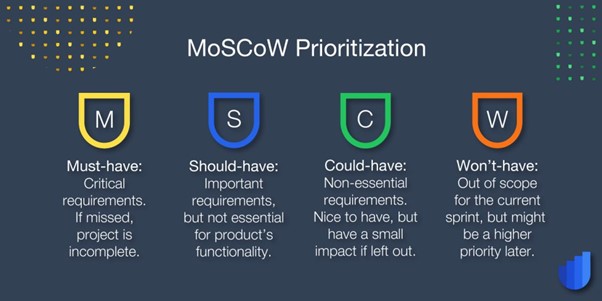
The Kano model
The Kano model is predicated on the idea that the features and functions offered have a direct impact on how satisfied end users are with the project’s ultimate delivery. A typical questionnaire is used to gauge customer satisfaction levels. The elements are divided into four distinct categories by the model:
• Performance – ease-of-use and speed are typical performance measures
• Must-be – these are features that are basic expectations
• Attractive – not necessarily expected but features that are a bonus
• Indifferent – these features are neither necessary nor missed by their absence
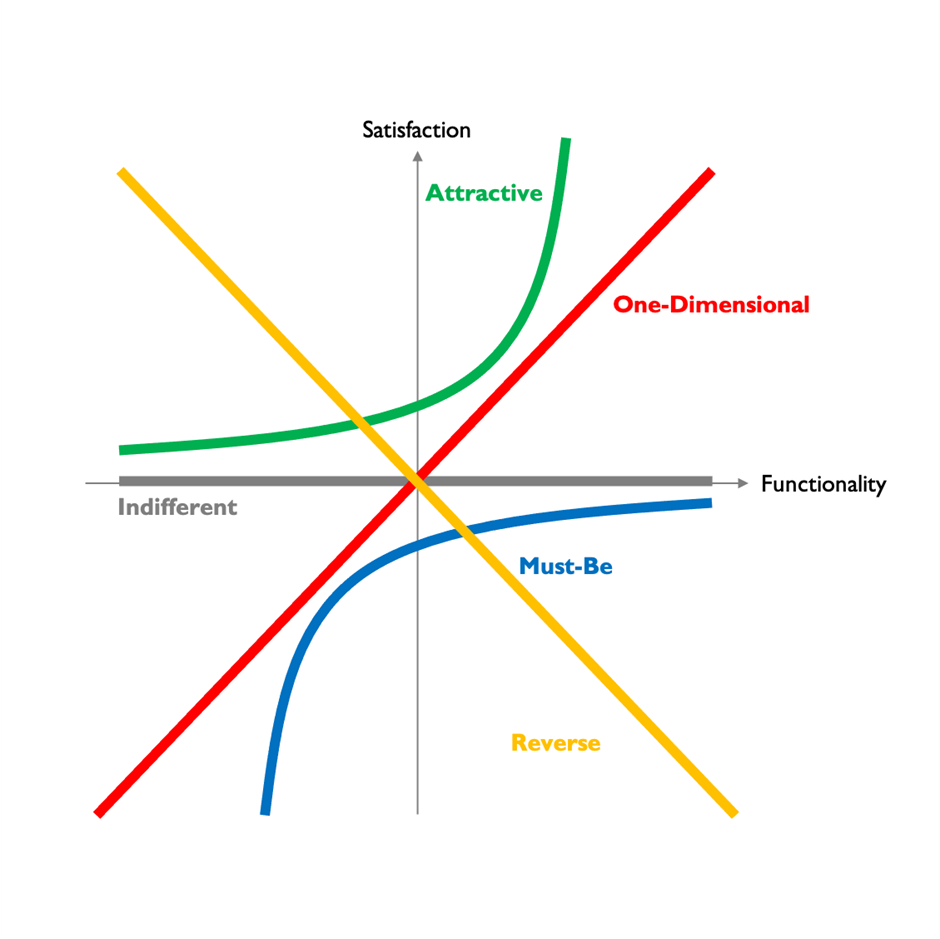
Net Present Value
The difference between the quantity of money today and the worth of money at a later time is referred to as the net present value (NPV). Higher NPV initiatives are preferable while prioritizing projects. Cash today is more valuable than cash in the future. As a result, projects with longer lifespans might have lower NPV’s than those with shorter lifespans.
Payback period
The time needed to recover the project investment is referred to as the payback period. It is computed by dividing the project’s cost by the average annual inflow of cash. This method aids the project management office (PMO) in identifying which project will recover the initial expenditure the quickest. However, employing this strategy to prioritize projects alone is reductive because it ignores project risks and time value of money.
Scoring model
A flexible method of assigning project priorities is a scoring model. The procedure can be as informal or detailed as required, and the grading criteria can be tailored to match the objectives and values of your PMO. Here is how it works:
1. Select three or four scoring criteria (e.g., benefits, size, risk, impact, margin, cost, feasibility)
2. Assign ranges to the criteria to rank the projects (e.g., 0-5 or 0-10)
3. Assign weights to each category (e.g., Risk may be a more significant deciding factor than impact)
4. Test out the model with different business units to assess whether the model provides meaningful results
These are only a few methods for ranking projects according to different criteria. If you’re interested in learning about additional prioritization techniques that you might consider trying, some others include internal rate of return and story mapping.
Conclusion
It might be challenging to maintain a single project, and it can be considerably more challenging to maintain several. Therefore, if managing a project is to be successful, it is clear that using clear procedures and processes is necessary.

Course Manual 5: Identifying and Clarifying Needs
How to Identify your Business Needs and Create Actionable Processes
How would you respond if someone asked you what your company needed right now to succeed in the future? What information (and where) would you look to get a response? It’s crucial to know the demands of your business in order to manage it more successfully, therefore ask this question carefully. The issue is that these demands may not always be as evident as they need to be. When that happens, some internal “digging” is necessary, but if you don’t have the correct instruments, it can be a difficult task. the positive news With the correct platform, determining how to maintain the health of your company is straightforward.
• Define your business objective
• Analyze your data and workflows
• Communicate findings with your team
• Create a Plan
Here are three actions you can take to determine your company’s needs and develop methods that will help it advance, whether or not it is operating on a smart technology platform:
1. Define your business objective
When determining your company’s needs and a course of action, a clear business purpose will serve as your North Star. If your goal is to boost revenue for your consulting business or digital agency, that’s fantastic. However, you’ll need to be more specific than that in order to be effective. How do you want to boost sales? It can entail improving your profitability visibility to discover new revenue streams or just improving efficiency to maximize your return. What’s crucial to understand is that until you gather some data and from there, acquire visibility into what’s happening in your organization, you won’t have a clear answer as to how you should approach the task of attaining your objective.
2. Analyze your data and workflows
Even though this is the logical next step to obtaining the solutions you require, it is frequently the most challenging. When all of your work is dispersed over several spreadsheets and applications that don’t adequately communicate (interface) with one another, it can be challenging to get your hands on the data you need to make decisions with confidence. If the prospect of acquiring the appropriate data for this research seems intimidating, you might want to consider several platforms that can make it easier. Mavenlink is a wonderful alternative if you work in marketing or design and need a platform to manage your projects because it enables you to keep track of time, money, and resources. Alternatively, Autotask, a solution that combines your service desk, sales, projects, and billing, is a good option if your business is in the IT industry. In contrast, give Accelo a try if you require a smart platform that will integrate all of your tools and want to receive a thorough picture of how effective and profitable your firm is.
Brendon O’Sullivan, CEO of Big Blue Digital, found himself in a similar situation to put things in perspective. Despite working harder than ever, he and his staff couldn’t make the statistics add up, he knew. When he attempted to investigate the agency’s finances, he discovered there were many gaps on how employees were allocating their time and how profitable their initiatives were. He was able to understand that his organization was having trouble due of inefficient tools and procedures that were impeding their goal of raising income. He was motivated to invest in more intelligent technologies by these pain areas in order to improve his business visibility.
3. Communicate findings with your team
There is no hiding what doesn’t look right if you can quickly access all of this data and see your business “naked” (in all its splendor), such as, “How does my revenue align with the productivity of my team?” It won’t be challenging to respond to questions like, “Are there trends in how my team communicates with clients or completes client work that eat away at our bottom line?” For instance, Brendon recognized right immediately how significantly Big Blue Digital’s delayed billing procedure was affecting their cash flow.
Brendon was able to reduce his invoicing cycle from 60 days to 18 days, a 70% reduction, after investing in more intelligent technology. You need a clear company objective to determine your demands; Big Blue Digital’s aim to boost revenue (and they did that by getting rid of inefficient processes). However, without easily accessible and trustworthy data, you cannot choose the best way to accomplish your goal. To make wiser choices and successfully advance your firm, you need visibility into your operations.
Create a Plan
The next stage is to develop a plan, now that you are aware of your business goals, have examined your data, and have discussed the findings with your team. Be practical and detailed when creating the actionable tasks your team will need to follow. Consider what success truly means to you and see if you can develop a quantitative goal to monitor progress. Finally, remember your goals and make sure each activity yields the intended results.
It will take some time, but by giving this step significant consideration, you’re boosting the likelihood of success while decreasing the likelihood of failure, frustration, and/or an unavoidable change in plans. The greatest method to keep your team on task and concentrated is to create a roadmap.
Conclusion
To ascertain your company’s requirements and find new procedures that can propel the enterprise toward achievement, follow the procedures outlined above. You will be able to plan deeper into the future and keep your attention on reaching your business objectives if you take the time to complete the necessary groundwork.

How to Define Business Needs through Business Analysis
A business, whether it is public, private, or nonprofit, serves a market, carries out a mission, and, assuming all goes according to plan, realizes the vision that its founders have set.
Business leaders define goals and objectives for their company during the course of operations, and they motivate workers to put in a lot of effort to meet those goals. These aims and objectives are necessary for the operation of the business; they are the things it needs to have or do in order to function, be profitable, provide excellent customer service, and successfully carry out its mission.
The most important business needs can be further categorized into two categories of needs. Iimprovement needs are defined as declarations about offering particular services, a range of products, helping those in need, or maintaining the organization’s own operational effectiveness. The second type of business needs are capability needs and are defined as suggestions meant to increase efficiencies or decrease costs, effort, or time-to-market.
Identifying and understanding the business’s goals, articulating its strategic direction, and capturing any important concerns relating to the business’s successes, challenges, risks, or problems are all parts of the enterprise analysis activity, which also includes articulating and defining business needs.
Critical analysis, intelligence, and thinking on one’s feet are necessary for effectively understanding company needs. It’s possible that a company’s business leaders won’t express their needs to you explicitly, but they’ll likely make suggestions for potential solutions, lament the lack of useful capabilities, and frequently discuss prospects they could pursue if they only possessed the newest technologies. As a result, you must perform extensive interpretation.
You can learn more about a leader’s goals and aspirations by investigating the origins of their wishful thinking. The main activities or drivers of the firm are determined when you attempt to determine why they require those things. IRACIS, which stands for “increase revenue, avoid costs, improve service,” is a well-known acronym for business analysis. Usually, one of these aims is connected to the company needs.
Business analysts must articulate needs in order to effectively meet them:
• What objectives or goals are being served or attempted in specific business area(s)
• What results or outcomes are desired
• What issues or problems are getting in the way
• What solutions are being suggested or considered for implementation or adoption in order to get the business needs met
Tip:
When determining company needs, the analysis should be combined with desired outcomes and issues thought to be impeding corporate success. However, this does not imply that opportunities and problems will always be expressed simultaneously. The company might identify an issue without a corresponding opportunity, or vice versa, a problem without a corresponding opportunity.
Business needs are often expressed in broad terms that characterize strategic (and perhaps unrealistic) aims or, in more precise terms, that describe tactical objectives, such as what will be completed by when. As a result, effectively addressing business demands may call for wide solutions, such as a group of operational stakeholders or organizations that take part in a number of projects that are then created to achieve the goals.

Understanding the Needs and Wants of Your Business
We learn the distinction between a necessity and a want from a young age. We are aware that we have a small number of genuine necessities and a large number of wants. It’s the same in business, but much more difficult to distinguish between and comprehend. We’ll look at the requirements and preferences of business owners, as well as the advantages and disadvantages of each, and determine what constitutes a satisfactory middle ground. Here are a few illustrations of each and advice on how to concentrate on the things that your company genuinely needs to succeed.
Clients/Customers
The backstory: The only way our company can turn a profit is as a result of the purchases of your clients and customers. To operate a profitable business, requires not just satisfied consumers but also a sufficient number of them. To maintain and expand your business, you must also consistently attract new clients.
Needs: To locate the ideal clients who will purchase your good or service and enable you to turn a profit.
Wants: Ability to assign tasks to people inside your firm to boost sales and boost profits.
Pros: To create a scalable business, it is important to target the correct audience.
Cons: It’s challenging to put your business development expertise in the hands of someone else.
The happy medium:
When the time is right to grow your business, you can do it by determining the appropriate target market of clients. You’re stuck with whatever sales come in passively if you don’t know how to target these clients and customers.
You can find the ideal personnel to tackle the work duties that keep you tied to a heavy burden by creating a hiring strategy. It’s challenging to get everything done, but creating a plan to delegate those talents to competent or vetted persons can help you focus on tasks that improve the bottom line or enable you to occasionally step away from your company. Building sustainability into your organization requires focusing on improving customer retention and customer average lifetime value. For the purpose of predicting sales, you should establish a referral program that enables your loyal customers to advertise your company in exchange for a benefit.
Employee Retention
The backstory: To run and expand our firm, we not only need a regular stream of clients, but also reliable, dependable workers. High employee turnover is expensive and causes serious issues for the business.
Needs: Must have dependable, devoted employees to support our company, our clients, and the customer experience.
Wants: To lengthen the typical employment period while lowering the expense and time needed for training new employees.
Pros: Low turnover makes managing a business simpler.
Cons: Employees will look for other work opportunities if growth opportunities aren’t offered and abilities aren’t being used to their full potential.
The happy medium:
One thing that is frequently repeated is that people leave managers rather than the actual jobs themselves. Making sure that your workplace culture is appealing, allowing employees to choose their own schedules, job titles, abilities, and other workplace flexibility (where possible), and providing these chances will boost employee engagement and reduce work stress. They are able to take charge of their roles and control their possibilities for advancement as a result. Everyone will be on the same page if team building exercises and periodic, regular training are provided. Encouraging professional development will also help everyone enhance their abilities and flourish as a group. The key to maintaining everyone’s satisfaction with their employment is ensuring that management is aware of the organization’s objectives and is managing their stress and workload in a healthy manner.

Marketing
The backstory: Every business owner should be aware of the value of marketing and want their efforts to translate into a profit for their company; nevertheless, it can be challenging to know what to do, how much money to allocate, and how to monitor the success of these efforts.
Needs: A strategic plan, a marketing budget, and a presence online and off.
Wants: To carry it out internally with a committed marketer who can ensure high conversions.
Pros: These actions can help your company expand.
Cons: If you don’t have the proper skill set, it might not be possible within the allocated budget and take a lot of time.
The happy medium:
Many small businesses lack the resources necessary to manage the hiring of a professional marketer. Budget-wise, you’re looking at hiring someone who has the knowledge and experience of the broad range of several professions for at least $70,000 USD per year, which might not be an immediate possibility. By providing professionals who handle your marketing but don’t need a dedicated workspace on-site and can who can also create and implement a strategy that’s the proper size and budget for your organization is ideal. Hiring contractors or a marketing agency may help you address your needs AND wants.
Office Space
The backstory: A lot of a company’s work is done behind the scenes, and business owners need room to accomplish that work. Many small businesses try to handle this task while running their business or from their home office, but they often find it is less than optimal owing to numerous interruptions and distractions.
Needs: A designated workspace with internet access and office equipment that is free from distractions and daily activities at home.
Wants: A leased or rented office space that is tailored to your company’s needs and provides a recognizable atmosphere for meetings and visitors.
Pros: The use of a specialized office space is tax deductible.
Cons: Setting up an office, even one that doesn’t require much space, can be pricey. Budget-friendly leased workplaces could be hard to come by.
The happy medium:
Going to a coffee shop or a coworking space may be your best option when you need a break from your home-based business or find it difficult to concentrate inside your shop, workshop, or other place of business. Libraries also provide a calm environment with few interruptions that let you concentrate for a few hours each day. A coworking space can be a little busier, but it provides dedicated, flexible workspace with access to a variety of services that can assist you in developing and expanding your business. Coworking subscriptions are also deductible as company expenses. In some cases, switching up your environment by going to your neighborhood coffee shop, restaurant, or park (with a mobile hotspot or work that is not dependent on wi-fi availability) can help you focus.
Vacation
The backstory: Business owners are under constant pressure to be available and visible throughout the day. Their physical and emotional health suffer as a result, yet it might be challenging to locate a replacement so you can take some time off.
Needs: Boundaries are defined for clients, customers, and staff, and there is separation from work, home, and technology.
Wants: To be able to spend a few days at a time, preferably abroad, away from their business without stress or worry.
Pros: Your mental health will benefit greatly from time away from work.
Cons: Paying for additional employees and travel costs associated with a vacation might be pricey.
The happy medium:
Utilizing weekends and planning lengthy weekends (3 days) as frequently as you can could provide your brain with the necessary respite. You can keep costs down by planning one long trip per year. You must choose a staff person you can rely on to make choices for the company while you are away before you take even a single day off from work. Training someone to run the company while you’re away is essential for your mental health because, even if you’re physically away from the firm, worrying will keep your mind too preoccupied to enjoy your time away and prevent you from taking future breaks.
Many of the demands and wants that a business has can be met with a little advance planning. What requirements, desires, advantages, and disadvantages have you found in your company?

Course Manual 6: Define Characteristics of Each Need
8 essential business needs
Here’s a list of eight essential business needs:
1. Data and information
Businesses frequently need a variety of data types to operate more effectively. They gather and arrange massive amounts of data using database systems so that they may examine it. Data aids businesses in making critical decisions, such as budget planning and marketing strategy creation. Sales personnel, for instance, can utilize data to estimate sales for next seasons. By forecasting sales, they can make an educated guess as to how much money they can expect from their upcoming cycle of sales based on historical sales data. These are some of the several sorts of data that companies use:
All the information kept in a company’s database falls under the category of internal data. They can utilize this data to learn more about how the business is doing and how to increase its productivity.
Data generated outside of the company is referred to as external data. Tax returns, police reports, and government data about the business are examples of this kind of information.
Time-stamped information: This kind of data shows when and how long a customer interacted with the business. An illustration of how a company might use this information is to determine how long visitors spent on a certain page on their website.
Structured information: Within a business, organized data is referred to as structured information. Data organization into tables or even just a list is an example of structured data.
2. Systems
Business systems employ software that automates operations to cut down on time and increase productivity. Utilizing automation technology can help a company enhance production, boost income, and eliminate errors. Employees can program the systems to accomplish the task exactly way they want it done, which may eliminate errors. Automated systems also boost profits and productivity because they can complete tasks more quickly and accurately, reducing the amount of time a good or service spends in the production stage. You can utilize the following several automation systems:
Information technology: Databases and artificial intelligence are two examples of information technology. This kind of system can be used by businesses to safeguard information, address problems, and boost overall productivity.
Workflow: Workflow helps to streamline production, particularly within a project, by involving employees and using automated technology. In order to find information pertinent to their tasks, employees can engage with the system.
Robotics: Robots are devices that a business can use to help in automatic product assembly using sensory receptors. These devices frequently perform a wide range of duties to aid in assembling things more quickly.
Event processing is a form of technology that sorts through data to look for events that may be taken action on. The system notifies someone to respond to the alert when it discovers events that can be taken action on.
3. Applications
Businesses can expand the functionality of their software by adding corresponding applications. Programs with project schedules can be included in applications so that staff members can keep track of their progress and remain on schedule to fulfill deadlines. Email programs, video chat, and/or instant messinging can be used by staff to communicate with clients they are working with on a project as well as with one another within the workplace. Depending on what your firm needs, you can add a variety of applications to a company’s software that are available online for free or for a minimal fee.
4. Infrastructure
The structures and networks that make up a city, state, or nation are referred to as infrastructure. The physical structure, software, and other systems used by a business, such as computers and servers, all constitute its infrastructure. You can also take into account other systems that can make the company run more smoothly and effectively, such as transportation, energy, and IT services.
5. Processes
Processing orders, producing the goods, and delivering them to clients are just a few of the procedures you might utilize in a firm. They can employ procedures like booking client appointments and obtaining office supplies in a business that doesn’t complete sales. In order for staff to follow a routine, processes assist maintain a business organized. Employees can assist their firm in achieving its objectives by establishing a routine using processes.
6. Customer experience
A satisfied customer base can boost your company’s performance. Customer experience encompasses in-person and telephone customer assistance. Your company can achieve its objectives by having pleased clients since they are more inclined to do business with you again. Additionally, they might tell their family and friends about your company, which could boost sales and brand recognition. Consumer awareness of your brand is how many people are aware that it exists. You can provide your staff members more customer service training to enhance the experience your consumers have.
7. Marketing strategies
Marketing tactics are beneficial for almost every business that wishes to expand. A marketing strategy can include your plans for informing consumers about your company and the products and services you have to offer. You can use your social media pages, email marketing, and print or digital advertising in this plan. Developing a marketing strategy can assist in achieving business objectives, particularly if you want to boost sales and attract new leads. Consumers who are likely to use a company’s goods or services are called potential leads.
8. Products and services
Your customers receive value from your products and services. You can ask your clients what they might like to see from your business if you want to improve your goods or services. Sending out questionnaires for people to complete anonymously will allow you to collect their thoughts.

Importance of Strategic Organizational Alignment in regards to Needs Prioritization
By following the right path and allocating organizational resources in accordance with the strategic priorities, strategic alignment enables businesses to prioritize appropriate efforts that ultimately aid in the achievement of long-term goals in an ordered manner. Initiatives must be in line with the organization’s vision and business strategy during this process. The word “Alignment” highlights the requirement that all initiatives and programs, from conception to completion, must be in line with the overall corporate planning process’s business aim.
For instance, a fast-moving consumer goods (FMCG) company has the ambition to provide new goods that will boost sales by 20% annually. They can be able to assist the organization’s mission and hit the yearly income target with the help of the introduction of Digital marketing and Electronic Media promotion campaign activities.
Employees should also be made aware of the organization’s strategy, objectives, and expectations if long-term goals are to be met. Employees start working more effectively and intelligently once they understand how they may directly impact the success of the company. This increases staff productivity, which benefits the overall effectiveness and standard of the organization.
As a result, strategic initiative alignment helps to boost ROI, generate more leads, and improve organizational efficiency. In light of this, strategic efforts (projects, programs, sub-portfolios, etc.) ought to be categorized into a portfolio based on their similarity and relevance. The PMO can then take on the portfolio to achieve the entire company objectives after that.
Component Prioritization and Selection
Making the right decisions based on aligned objectives and adhering to their proper order of execution forms a supercritical factor when we take into account the ever-changing dynamics of the environmental factors as we have never seen before (for example, the Covid19 pandemic). The ordering of initiatives in a portfolio based on the benefit-cost ratio of each project or program constitutes the prioritizing of those initiatives. Typically, components with greater advantages than costs are given higher priority (regulatory and government work-related components have obligations to be fulfilled irrespective of their benefits and cost alignment with organizational strategy).
It is crucial to keep in mind that a benefit/cost ratio does not always imply the use of solely financial standards; rather, it suggests a larger understanding of the benefits realized from carrying out the project and their associated efforts.

When examining the above chart, it is clear from the various dimensions how difficult it is to create a perfect translation for what low cost and high benefits represent. Because of this, it is not possible to choose which initiatives should be carried out using a single criterion. Therefore, it is essential to use a multi-criteria analysis that enables decision-making while taking all of the many aspects and organizational demands into account.
According to the Project Management Institute (PMI) Standard for Portfolio Management, each organization’s business circumstances may differ from the strategic objectives. As a result, no model can ever fully capture the appropriate criteria to be applied by an organization when prioritizing and choosing its initiatives. The organization’s needs should be founded on the preferences and values of its decision-makers.
Criteria used in the Prioritization of Components
Projects and programs in a portfolio can be prioritized using a set of criteria or precise objectives to establish the best possible benefit-to-cost ratio. The primary groups of criteria are:
Strategic – A set of standards closely related to the strategic goals of the firm, such as the Balanced Scorecard. Organization-specific strategic criteria are required. Undoubtedly, organizations with various business goals would use various prioritizing standards. For instance, some businesses would desire to enhance its resource capacity in order to compete in global marketplaces. Some people might seek to employ environmentally friendly methods or improve internal procedures. For some people, cutting costs is necessary to remain competitive. Others, however, might need to boost the standing of their goods and services in order to stand out, etc.
Financial – A set of standards intended to measure the financial gains from the portfolio’s elements. They are closely related to metrics for costs, productivity, and profit. For instance:
• Return on Investment (ROI) – ROI allows comparing the financial return of the strategic initiatives with different investments and profits.
• Profit – The value (in currency) of the profit gained. A project may have a smaller ROI, but its nominal profit can be more significant.
• Net Present Value (NPV) – It is the difference between the project benefits and costs, considering that all incomes and expenses are converted to be realized on the current date. To do so, it is necessary to bring all future values to the current date by using a given interest rate. That allows the assessment and comparison between projects which have future incomes and expenses from different time periods.
• Payback – Iit is the number of times in periods necessary to recover all of the original project investments.
• Financial Benefit / Cost Ratio – It is the ratio between the present value of the benefits and the costs. The higher the ratio, the more viable the initiative is.
Risks – It establishes the amount of risk that a company is ready to take in order to carry out a strategic initiative without entering the danger zone. For the majority of firms, the risk assessment criteria often include evaluating both opportunities and threats. Concerning this criterion, the organizational risk of forgoing the project or program is another equally viable viewpoint.
Regulatory – Particular attention should be paid to situations where the component scope of work contains governmental, regulatory, or operational requirements. No matter how they score or rank, portfolio components that must adhere to such mandates must be noted in order to guarantee their inclusion in the final portfolio.
Urgency – It establishes the portfolio components’ level of urgency. Those or programs that are urgent have a greater priority than projects that are not vital since they call for immediate decision and action.
Technical knowledge – Evaluates the level of technical skills required to carry out the strategic initiative. Any given endeavor will be easier to implement the more easily available technical information, leading to effective organizational capacity and capability utilization. It is crucial to keep in mind that if criteria for learning and growth are to be established, they should be linked to the strategic requirements of the business rather than any specific technical expertise.
Stakeholder commitment – A set of standards intended to gauge stakeholder commitment to the management of strategic initiatives. The component is given more priority the bigger the commitment. The commitment may be evaluated comprehensively, taking into account each stakeholder as a separate group, or it may be broken down into various stakeholder groups, such as:
• Customer
• Community
• Executive Leadership
• Regulatory bodies
• Project team
• End Users
• Vendors/Suppliers
The world’s most aligned brands: Examining the best—and worst—mission-driven companies
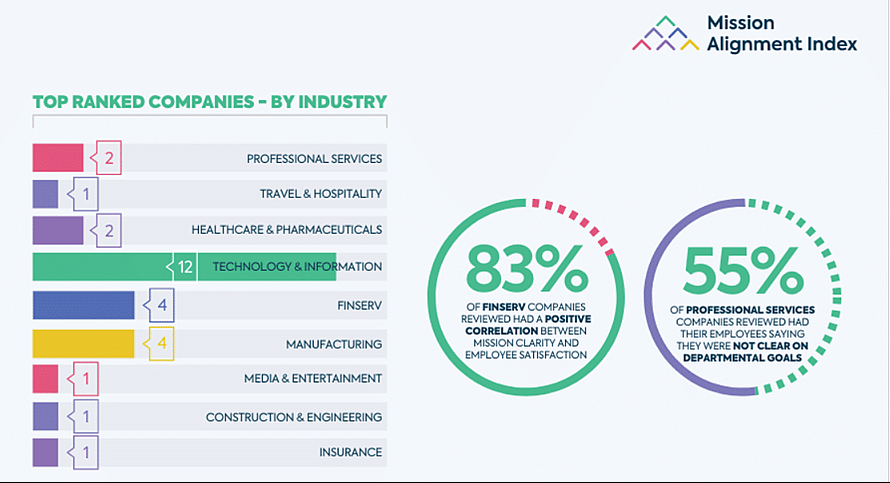
“Being aligned with your company’s mission allows employees at every level to understand their purpose in the workplace and hence, work towards growth, continued development and overall satisfaction with the work they are contributing to the company and their team,” said Seth Elliott, chief operating officer at Gtmhub, in a news release. “As an Objectives and Key Results (OKR) platform, we understand how critical an effective strategy execution framework is for ensuring clarity and alignment to achieve the mission. In serving the world’s largest brands, we have seen first-hand how essential mission alignment is for success, and the Mission Alignment Index (MAI) represents our effort to help companies improve their effectiveness in the Age of Outcomes.”
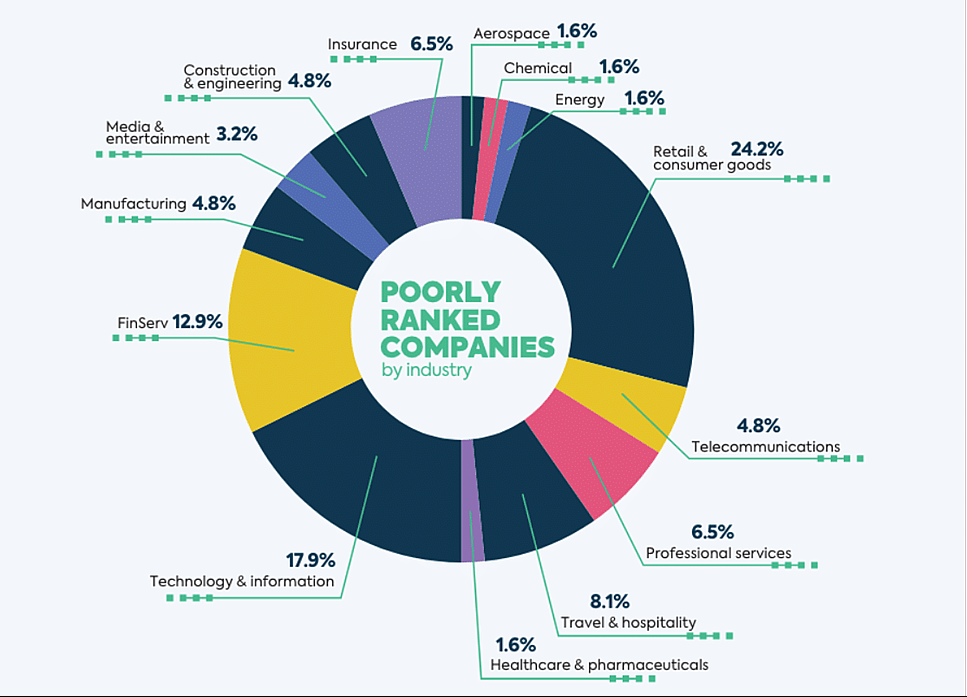
The company used self-reported survey data from confirmed employees for its recently released Mission Alignment Index (MAI). A company’s overall Mission Alignment score and employee satisfaction are correlated, according to the index’s main insights. The MAI assigns grades of A–F to hundreds of well-known brands. Important conclusions include:
• Only 14 percent of brands scored the highest rating for mission alignment.
• Gucci, HubSpot, Johnson and Johnson and Netflix were among the highest scored brands in the world
• IBM, Whole Foods Market, Chick-fil-A, Airbnb and Porsche earned a ‘C’ rating
• 14 percent of brands scored an “F” including McKinsey and Company, Marriott International, Gamestop and iHeartMedia
Conclusive Remarks
For authorities and decision-makers to take the appropriate actions that are consistent with the organization’s vision, it is essential that they consider the variables and criteria described above. The success of an organization is influenced by many factors. However, the portfolio’s strategic alignment clearly takes precedence over other components. Additionally, it guarantees the most effective use of a company’s material and intangible assets.

Course Manual 7: Tackling Needs in Order of Urgency
How To Prioritize Tasks When Everything Is Important
There are several advantages to owning and operating a business. More than any other career choice, being a business leader or entrepreneur can provide you a sense of fulfillment and professional satisfaction. The same stance does, however, have drawbacks.
When you have so many obligations to fulfill, time management may quickly become a problem that could slow you down or make it more difficult for you to accomplish your goals. This could also cause you to feel more stressed out than usual.
How can you manage everything without being overburdened when you have so many duties and responsibilities ahead of you? You need to develop an action plan that enables you to complete requirements and achieve your ultimate objectives when everything seems equally significant.
The following advice will help you better grasp the situation and what has to be done in relation to it:
Create a list of all of your current tasks
More often than you might think, having a to-do list in front of you can be really beneficial. Start by making a list of everything you have planned to do because staying organized is crucial to finishing each task accurately and on time. Simply list all of the duties in no particular order so that you can think of them individually. Making a Master List is a terrific method to view a large number of chores. With this method, you can more clearly see the big picture and determine how much work needs to be done.
After carefully examining the workload you must manage, you may then equally distribute the jobs using a hierarchical structure. This Master List will have a pyramid-like appearance.
Let’s imagine that you have a wide range of duties to complete in a month. After you’ve listed every task you need to perform, group them according to weeks and days. This will enable you to allot the necessary time for completing each assignment and to divide your efforts among them equally. In this manner, you will be fully aware of your progress toward meeting a particular deadline.
Your to-do list will keep you on your toes and prevent you from losing track of time or forgetting a key task that is crucial for your business. Even a quick glance at it will keep you on your toes. Keep the Master List updated as well, and check things off (or mark them as “done” in the Daylite CRM App) whenever you’ve succeeded in finishing them. A favorable productivity impact may result from being able to see your progress.
Organize your tasks based on their urgency
Not often the most important tasks are the most urgent ones, and vice versa. When you take care of the urgent matters first, you won’t have to worry about missing the deadline for a relatively easy assignment and can instead concentrate on the essential duties of your company. Put the most important items at the head of the list and deal with them in that order when trying to organize everything.
• Important tasks – activities with outcomes that lead to goal fulfillment
• Urgent tasks – activities requiring immediate attention
You may use your energy and concentrate to address the chores that will genuinely have an impact on your long-term business goals once you have cleared your schedule of everything that has a tight deadline. Setting priorities for your work based on urgency can make things run more smoothly and keep you from working under pressure to complete tasks that could truly contribute to the expansion and success of your company.
Split your to-do list into three segments
According to a study titled “Effectiveness at Self-Regulation and Prioritizing Difficult Exercise Goal Pursuit,” which was published in the Self and Identity Journal, categorizing tasks based on task complexity and tackling the most challenging problems first is the most effective method of task prioritization.
Here is a fairly straightforward method for classifying your tasks:
• Most complicated – these tasks will create the most significant outcomes. Break these task down into actionable pieces, if you aren’t exactly sure where to start. Handling them first will reduce stress and prevent you from using all of your resources on activities with a lower importance grade for business growth. This approach will allow you to benefit from rapid, significant progress.
• Complicated – slightly less complex than the ones mentioned above, complicated tasks come second in relevance.
• Least complicated – tasks with the lower-rated impact on business success. These can be various, but usually are easy to complete, involving clear actions towards completion and that is why they should be resolved last.

Prioritize the tasks that are most beneficial to your business
While tasks must be completed as quickly as possible, this shouldn’t imply wasting valuable work time on activities that don’t actually produce outcomes, decisions that have little business impact, or skipping over projects that actually have worth. A work that will increase profits, like a new email marketing campaign, is unquestionably more crucial than others that can end up being a waste of time for the organization.
Try to distinguish between jobs connected to internal routine operations and those that have critical qualities and add value for the company. Recognize the kinds of jobs and activities that can be completely automated or eliminated.
Learn to stay very focused
Although it may seem like very obvious and self-evident advice, the fact is that we need to prioritize our duties because we may not be initially extremely focused right out of the gate. And it’s not always our fault.
We currently operate in a challenging attention economy where numerous apps and services compete for our attention. According to a study on self-regulation published in Psychology, self-control is a skill that can be learned. Even when we don’t accomplish many things while working while distracted, we nevertheless manage to get exhausted, which makes the already challenging jobs even more challenging.
You can implement a number of ways to maintain your attention on your business vision, including:
• Keep your expectations realistic – overworking yourself will never be a good idea
• Track projects effectively by using a project and task management system like Daylite, for example
• Work in an environment free of distractions
• Maintain an organized and comfortable workstation
• Acknowledge achievements
• Get your team involved and be open to communication with your employees
Take a less important task off the list
You must recognize that sometimes there simply isn’t enough time to complete everything, and then reevaluate your duties to see what may be temporarily postponed. Even while crossing anything off your to-do list can cause anxiety, doing so will allow you to focus on tasks that are genuinely important for your company’s growth while also allowing you to be more productive and less stressed. Workplaces and their environments evolve–some needs can be reprioritized over time, relatively, if they evolve to become not as important as you initially believed.
Naturally, you must carefully review each item on the list, take into account the consequences of not completing it, and confirm that it is something you can delay.

How to Focus on What’s Important, Not Just What’s Urgent
Schedule important tasks and and try to generously timebox, i.e., allot much more time than you will require.
According to research, setting where and when you’ll complete a project or task greatly increases the likelihood that it will be completed.
I like to use a technique I call “clearing the decks,” which entails making one task the sole one I work on for the entire day, for highly critical and long-awaited activities.
Important but unfamiliar jobs frequently have a steep learning curve that makes it difficult to forecast how long they will take to complete. Another underlying reason we avoid working on these is that doing so frequently feels more awkward than efficient. Even when it appears excessive, the “clear the decks” method of giving yourself a full day might be helpful in certain circumstances.
Try setting out a specific time window once a week where you can schedule a personal appointment during working hours if necessary. This will help you avoid putting off vital personal care. This can guarantee that medical issues are investigated as soon as possible. The slot won’t be used most weeks, but keep it walled off in case a situation calls for it.
Isolate the Most Impactful Elements of Important Tasks
Big tasks often require incremental progress.
Try this if you frequently make grandiose goals that you end up putting off: Think about a goal’s half-size equivalent as well. Compare your original version and the scaled-down version in your mind and consider which is the superior (more attainable) objective. If your task still seems overwhelming, scale it back until it seems manageable. You might come up with a goal that is less than what you had originally imagined, but it will be more doable, and once you start, you can always keep going.
Anticipate and Manage Feelings of Anxiety
Tolerating the anxiety-inducing thought of “things that could go wrong” is a requirement for many crucial undertakings. Making a will, looking into a lump sum, business succession planning,, actually reading your insurance policies, or developing that crisis management plan are a few examples.
Even when duties don’t include thinking about disasters, they frequently involve putting up with anxiety in order to reap future rewards that could be significant. Creating new friendships, taking on a new challenge for the first time, asking for what you want, engaging in awkward conversations, accepting responsibility for mistakes and making them right, and making progress on lengthy, multi-month tasks that require you tolerating varying levels of self-confidence and doubt are a few examples of important but potentially anxiety-provoking tasks.
In general, working on significant tasks often necessitates having strong tolerance for unpleasant emotions.
Therefore, having excellent control over your thoughts and emotions can help you achieve goals that require you to step outside of your psychological comfort zone.
Prioritize Tasks That Will Reduce Your Number of Urgent but Unimportant Tasks
Being “too busy chasing cows to erect a fence” is a common temptation in modern life. Resolving the same issues continually or giving the same directions are the kinds of situations you want to stay away from. You can outsource, automate, batch small jobs, omit duties, optimize your workflow, or develop templates for repeating chores to break the habit of spending the entire day “chasing cows.” Look for circumstances where you can commit some effort up front to create a system that will save you time later, such as setting up a recurrent order for office supplies rather than buying things as you need them.
Retraining the “decision leeches” in your life is one specific tactic. People that postpone choices to you are known as decision leeches. For instance, you might ask someone else to decide something, but instead of doing it, they might send you an email with a list of possibilities to consider, which puts the onus back on you. Ask them to give a specific recommendation rather than immediately responding.
Pay Attention to What Helps You See (and Track) the Big Picture
It is challenging to have enough mental room to view the larger picture while we are head-down in the grind. Pay attention to what makes you do this naturally. More breaks can assist you avoid falling into the rabbit hole of spending a lot of time on pointless activities without realizing it.
The drawback of tracking your time consumption is that it requires time and willpower to do so in the first place. A lot of individuals use apps like the RescueTime app to easily keep track of how much time they spend on various websites. Each week they quickly scan the report after that.
Don’t disregard anything that will assist you see the big picture. After those exercises, give yourself some time to consider how you’ll turn your insights into concrete goals and actions.
Don’t be too hard on yourself if you have trouble giving the important a higher priority than the urgent. This struggle is essentially universal due to the sheer volume of deadlines and choices we must make in modern life and the emotionally and cognitively demanding nature of many crucial activities.

Avoid ‘The Urgency Trap’ with The Eisenhower Matrix
“Who can define for us with accuracy the difference between the long and short term! Especially whenever our affairs seem to be in crisis, we are almost compelled to give our first attention to the urgent present rather than to the important future.”
— Dwight D. Eisenhower, 1961 address to the Century Association
Dwight D. Eisenhower, the 34th president of the United States and a five-star general in World War II, can easily be considered a successful man.
He oversaw the development of the Interstate Highway System, founded NASA, passed the first significant civil rights legislation since the end of the Civil War, put an end to the Korean War, welcomed Alaska and Hawaii into the union, and kept the Cold War with Russia at a standstill during his two terms as president of the United States.
And he did it all with style; twelve times, Eisenhower was named Gallup’s most admirable person of the year.
How did Eisenhower manage to do so many things that would affect his nation and the rest of the world for such a long time? He was aware of the essential distinction between the Important and the Urgent. Eisenhower paraphrased a university president who said, “I have two kinds of problems, the urgent and the important,” in a 1954 address. The urgent are never importent, and the importent are never urgent.
Eisenhower’s observations were repackaged by Stephen Covey over three decades later in his best-selling book The 7 Habits of Highly Effective People as a straightforward framework for job prioritization that is now known as the Eisenhower Matrix (also known as The Time Management Matrix, The Eisenhower Box, The Eisenhower Method, and The Urgent-Important Matrix). This structure for prioritizing aids in overcoming the “mere-urgency” effect (more on that later), getting rid of time wasters, and freeing up your mind so you can work on your objectives.
You might want to try the Eisenhower Matrix if you:
• Find yourself running around putting out fires all day (figuratively speaking)
• Are busy but don’t feel like your work has a high impact
• Have long-term goals but no time or energy to make progress on them
• Have a hard time delegating and/or saying no
• Want to be the president of the United States (hey, it worked for Eisenhower)
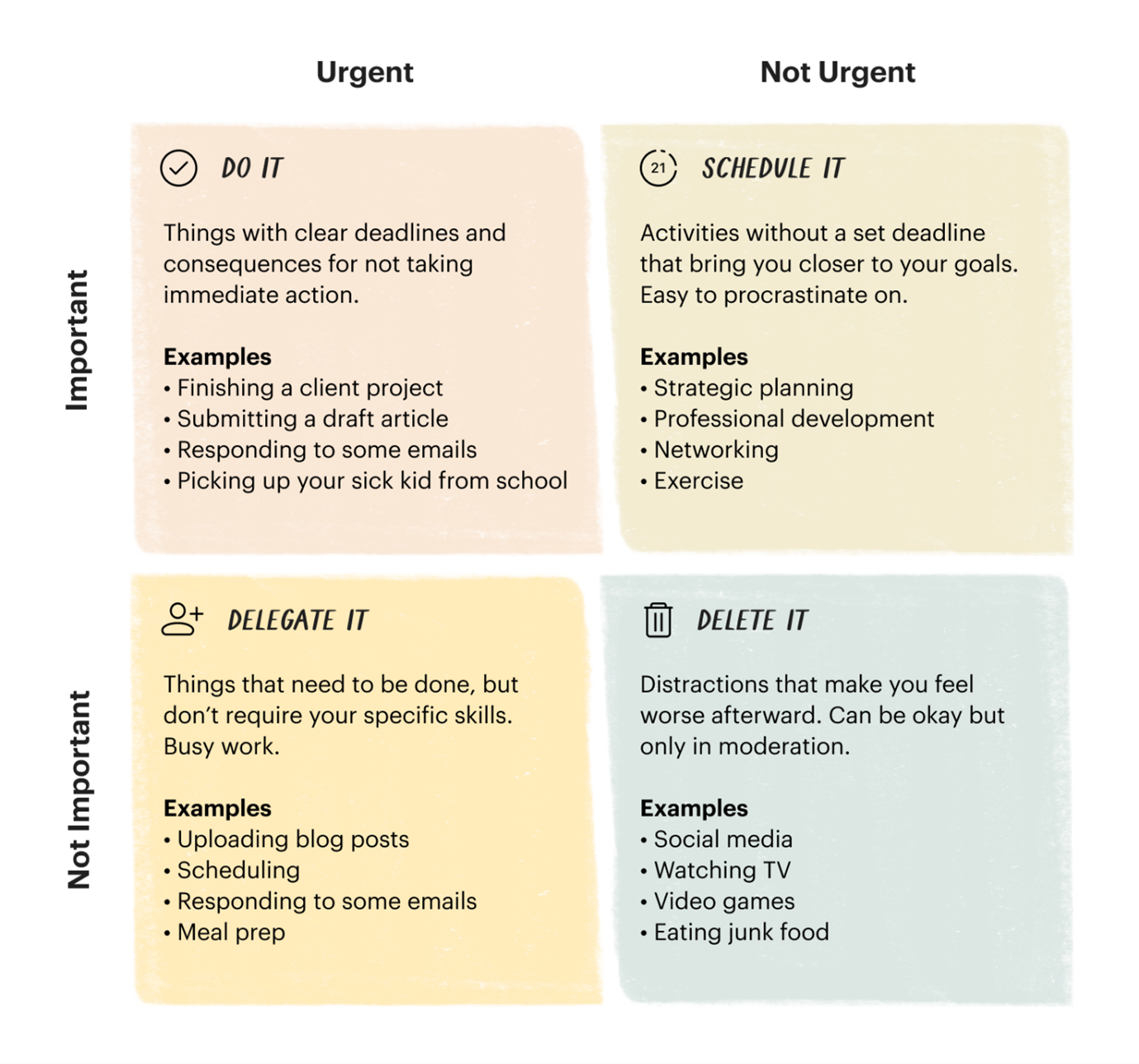
In course manual 8, we go into Prioritization Tools and associated ideas in further detail.
Conclusion
Every day, there will be new duties to complete when running a business, so you need to be well-prepared and know how to deal with incoming demands effectively. One of the things you need to keep in mind in these situations is that not everything is worth your time; certain jobs can easily be delegated to an employee or removed entirely from your to-do list. Consider these tips on how to prioritize your business operations so that you may always keep on top of what’s truly important for the future of your company.

Course Manual 8: Additional Criteria for Needs Prioritization
Return on Investment
Laying the Foundation
Data Collection
The quality of the analysis’s findings is influenced by the information’s quality. Not all necessary data is readily available in a compact form that can be incorporated into a ROI model. Such information might not be formally documented at all or be hidden deep within thick company records.
The data you’ll need to gather to build your project ROI analysis can be divided into numerous categories:
• Previous Project History: Results of evaluating prior project projections against actual results from both business benefit and cost perspectives yields valuable information for analyzing current or planned projects.
• Ranked Business Priorities: Successful projects align with business objectives. Prioritizing business goals aids in evaluating the business value of potential projects.
• Current Organizational Measurements and Trends: Documenting metrics (especially those related to achieving corporate goals) helps in evaluating project results. Metrics may include recent revenue trends, client satisfaction trends, and operational cost trends.
• Internal Cost Metrics: Internal resource availability and cost data are important in evaluating required outlays for new projects.
• State of the Organization: Technical, organizational and business factors (or short-term plans) that may impact project success should be documented. Corporate technical architecture, both current and planned, should also be considered in evaluating projects.
• Assumptions: Hypotheses about the future that impact your decisions should be documented so that when the future proves the hypotheses true or false, project priorities can be updated accordingly.
Putting it Together: A Systematic Process
Making judgments will be made easier if tasks are organized, analyzed, and prioritized in a methodical manner. Making the ROI process official allows you to:
• Ensure that your base information is as complete and accurate as possible.
• Provide consistency in evaluating projects by the same documented criteria.
• Incorporate business and market changes (i.e., revisit assumptions) to keep analysis results relevant.
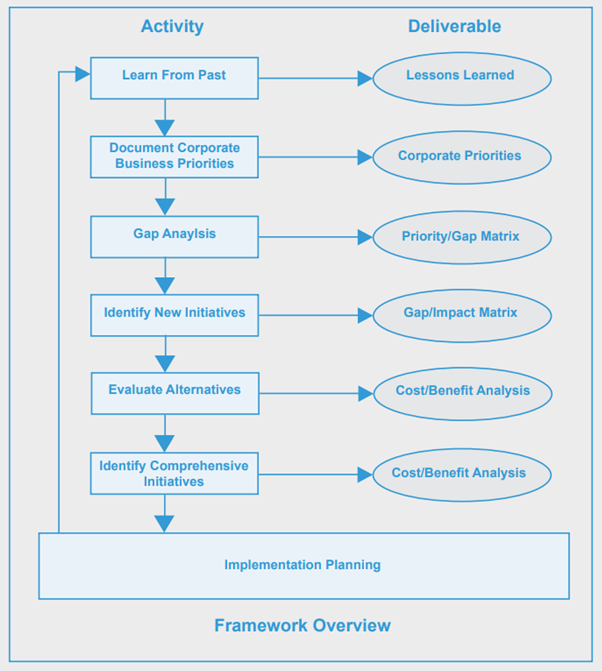
Activity 1: Learn from Past Projects
Many businesses (as well as individuals) are guilty of front-loading their projects when it comes to business reason. When a project is being justified, a lot of analysis and benefit calculations are frequently done, but relatively little analysis is carried out after the project has been completed to see how accurate the cost/benefit estimates were. This absence of post-mortem analysis spares project participants from criticism (and praise), but it also hinders the organization from learning important lessons that would help it evaluate, prioritize, and plan future initiatives. Every business must examine the following data regarding previous projects:
• Anticipated direct and indirect cost and schedule data, compared with the project’s actual costs and schedule.
• Anticipated business benefits compared with the project’s actual business benefits.
• Both positive and negative sources of unanticipated cost, schedule, and benefits. Documenting the sources of the unexpected helps refine planning for future projects.
• Business staffing and/or process changes that were needed but not anticipated as a result of the project’s implementation.
• Changes in requirements that occurred while the project was in process or shortly afterward. How can project planning be improved to minimize such changes for future projects?
• For each project, what element(s) (i.e., estimation algorithm, project team make-up, and/or reporting tool) can serve as a model for future projects?
• What mistake(s) (and a plan for avoiding them) can serve as a lesson?

Activity 2 – Document Corporate Business Priorities
Corporate goals are, of course, shifting targets. Market conditions or competitor actions frequently have the power to drastically alter organizational plans. To match business objectives with technological projects, a scorecard of business priorities is necessary. Comparing potential process initiatives is aided by quantifying the relative weight of the goals, which is frequently done in a straightforward style like a one-to-ten scale.
Some examples of business priorities are:
• Revenue or market share enhancements for specific company products/services or for the entire product/service line. These may also include client retention, expansion of client base, and/or increased volume of client orders.
• Efficiency and quality goals for specific corporate processes. These may include reductions in cost, cycle time, or defects (or a combination thereof). Efficiency targets are often set through comparisons to other firms, particularly competitors (e.g., best practices). Efficiency and quality goals are unique for the processes they measure (e.g., financial, supply chain, human resources).
• Qualitative goals, such as external and internal customer satisfaction, are a specific form of quality goals. These are common for evaluating the quality of corporate processes as well as the effectiveness of support organizations such as human resources, facilities management, and marketing.
• Financial measurement goals relate to a company’s balance sheet and/or its stock position. These may include mix of debt and equity, reduction in expenses (either cost of goods sold or indirect sales and administration expense), and turnover of inventory.

Activity 3 – Identify Gaps in Achieving Objectives
In order to connect with business objectives, many ROI models start with projects and work backward. When possible, we advise starting with the business priorities before looking into any procedures (including automated systems) that might be impeding the achievement of the goals.
We advise assessing each business process or collection of processes pertinent to accomplishing a particular corporate priority in this activity and determining the main causes (or process gaps) that can obstruct the fulfillment of that business objective.
For instance, if increasing sales or market share is a top aim for your catalog business, you may wish to assess the procedures related to customer happiness and client acquisition. These might suggest that various processes (and the automated software that support them) could use some enhancement.
Examples of procedures with regard to a revenue-related business objective are:
• Customer Analytics: Are we selling all possible products/services to existing clients?
• Market Analysis: Are we selling the products that the market is ready to buy?
• Customer Satisfaction Management: Are we answering our clients’ questions and managing their orders well?
• Inventory Management: Are we managing product delivery and availability to meet market needs?
• Production: Do our products have defects?
• Distribution/Inventory: Are we delivering products in time and quantity to meet client requirements?

Activity 4 – Identify New Initiatives
Incremental Initiatives
The fastest and least expensive approach to accomplish a business goal is frequently to incrementally improve an already-existing process or group of processes. Since this takes into account both the manner in which an organization executes tasks and the automated technologies that support those tasks, you should concentrate on both manual and automated processes. Most objectives (and challenges) require changes to computerized systems and processes in order to be achieved.
Enhancements to applications (like new reporting formats) or modifications to current processes (such new process measurement, altered reporting relationships, and/or updated procedures) are examples of incremental efforts. To further operational objectives, new automated applications (either developed from scratch or purchased from a vendor) may be taken into consideration.
New Model Initiatives
In the recent years, major transformation initiatives—including reengineering, enterprise resource planning (ERP), and “e-commerce will solve it all” initiatives—have developed a bad image. Many people have discovered, nonetheless, that in order to get a competitive edge and/or address enduring operational issues, it is beneficial to take into account large-scale process or overhaul changes. Evaluating the advantages, disadvantages, and hazards of each new model realistically is the key to avoiding the “latest new thing” mentality.
We advise starting with the company aim and the gaps found in Activity 3 in order to find new models. Next, research industry best practices and come up with fresh ideas for processes and/or technologies that could vastly enhance your company model, close any gaps, and greatly raise the likelihood of attaining the business goal.
New models might employ strategies like:
• Outsourcing functions (e.g., call center) that are now handled internally.
• Reorganizing procedures (e.g., customer service), staffing models, and/or metrics.
• Using new vehicles for client acquisition and service, such as Internet-enabled client entry or affiliate marketing (cross-selling with another vendor online).
• Developing applications to provide new functionality, such as data mining.
• Creatively using new technologies, such as wireless, voice recognition, and imaging.
By researching business best practices in your sector, coming up with creative solutions to business problems, and studying best practices from other sectors, you might uncover new models. Many inventions that start in one field can be used to many types of businesses. For instance, just-in-time inventory was first used in manufacturing but quickly spread to other industries to handle a variety of supplies and assets.

Quantifying Initiative Value
It is often difficult to obtain quantitative data about the worth of possible initiatives. However, there are some inventive methods for determining objective value assessments. The following elements should be included in the value analysis of an initiative:
• Business impact of known problems in the process.
• Likelihood that the initiative will solve these problems.
• Success history of similar initiatives.
• Value of process improvement in achieving the business goal.
The sort of initiative (automation and/or procedure) and its quantitative value in resolving the known issue should be determined. According to the objective value and the expected goal impact of an initiative, many companies find it helpful to assign numeric “scale” values to those efforts.
After addressing each goal’s stated process issues, you will have a baseline from which to determine the relative importance of each project. Despite the fact that project priority does not immediately correlate with dollars saved or earned, this strategy aids businesses in more objectively comparing various initiatives.

Activity 5 – Evaluate Alternatives
Cost Estimation
Calculating the costs of execution for projects is the first step in setting their short- and long-term priorities. Direct costs (which call for particular financial outlays) and indirect costs are among the cost types.
Make certain that the cost descriptions are thorough. For instance, the price of implementing an IT system frequently consists of direct charges for the hardware, software, and consulting services as well as indirect costs for internal programmers and project funding. Don’t forget to factor in the time and money spent on planning, delivering, and attending the training. Cost analyses frequently fail to account for maintenance costs, both financially and in terms of labor. Many firms use present-value analysis to discount projected project cost schedules, resulting in present expenses that are larger than costs incurred in the future.
Hidden Costs
The cost of learning curves, the time and money required to overcome opposition, and the lost productivity of staff members who are no longer performing the jobs they were initially allocated are all examples of hidden costs associated with changes in process design, measurement, and organization. Process change incurs training expenditures like as awareness raising, training design, training attendance, and training maintenance, just like the introduction of new systems. Do not forget to account for both one-time and ongoing expenses.
Implementation Risk
The success of a project frequently depends on elements that are not considered in a cost-benefit analysis that is just based on money. We advise that initiatives be assessed in light of implementation risk (i.e., elements that could prevent project success), the success of related projects, the length of implementation, and the extent of organizational change.
Project complexity, ease of integration with current systems and processes, precedents for similar projects (newer technology and procedures certainly raise risk) and past corporate project histories are possible implementation risk factors. It’s also important to keep in mind that risk rises proportionately as implementation time grows. Short implementation cycles are frequently encouraged as a way to lower this risk on large-scale projects.
Since resistance to change frequently prevents a project from succeeding, the scope of organizational change should also be assessed. People affected by the change, the extent of the change based on present practices and operations, staff readiness for the change, and the history of changes in previous projects are all organizational change variables.
In addition to the ones listed below, an organization may decide to examine other factors. These could include how an initiative uses limited organizational resources, how dependent it is on other projects, or any other factor that has been successful in predicting the worth or success of previous efforts.
Decision-Making
Keep in mind that every project involves trade-offs in terms of cost, benefit, and risk. Rarely does one particular project stand out as being the most deserving of realization. Prioritizing top-tier projects and identifying areas that call for more data collection are made easier with a complete portfolio view of all activities and their costs, benefits, risks, timelines, and durations. As long as stakeholders agree, management can assign weights to various business value categories; nevertheless, it is crucial to exclude partisanship from the process. An objective analysis can occasionally be aided by a disinterested third party.
When your analysis is finished, how should projects be chosen? Your corporate resources, project history, the state of the economy, and your business objectives all play a role. Some businesses base their top-tier cutoff decision solely on numerical criteria, such as the weighted business value divided by the implementation’s three-year cost. Others decide to devote their funds and internal resources to initiatives with the greatest business value. When rating projects by business value, organizations facing severe financial constraints may opt for those with the lowest out-of-pocket expenses. Regardless of your organization’s priorities, project prioritization should be monitored and evaluated after project completion. Your priority and/or estimating elements should be revised if your initiatives didn’t achieve their business objectives.

Activity 6 – Identify Comprehensive Initiatives
An examination of all projects (and gaps) might occasionally reveal a structural, technical, or organizational problem. Analyze the suggested projects in this assignment and look for broad issues that might be the cause of numerous organizational challenges.
These may consist of:
• Strategic alignment within and/or among business centers.
• Alignment between business and information technology management.
• Technology infrastructure issues that might include:
– Staff skill shortages.
– Persistent problems with system availability or response time.
– Ineffective project management.
Comprehensive initiatives can be created to address fundamental problems after they have been recognized. This activity offers the chance to find comprehensive projects that could support numerous initiatives and company objectives, evaluate them in terms of their business value, and estimate the costs (and risks). Additionally, it offers a framework for organizing the strategies for putting all selected projects into action.

Activity 7 – Implementation Planning
The preceding activities are combined in this activity. A thorough timeline, resource estimates, and cost projections are included with the presentation of the company’s portfolio of proposed projects. Resource dependencies, estimated corporate benefits in dollars, and/or interim project checkpoints with predicted business value results are a few examples of supporting documentation.
Remember that the procedure outlined here doesn’t have to be very involved or drawn out. For first-round prioritization, the prioritization process can be accomplished fast (high level assumptions and estimations can be documented), and later, more specific data can be identified for collecting. Please keep in mind that setting priorities is a continuous process. Plan routine evaluations of ongoing projects to compare pre-project projections to the projects’ actual risk, cost, and projected business value.
So, what’s most important?
The following are the most important components of a good project value ROI analysis:
• Always starting with business goals and challenges. Keep in mind that starting with technology and working backwards to business utility often results in clever but non-fruitful projects.
• Remembering that ROI analysis should be completed both for the past and the future. Estimates should be evaluated against project realities so that discrepancies can be factored into future projections, making them more realistic.
• Recognizing that not all business goals can be achieved through technology alone. A combination of process redesign (including organization, metrics, and procedures) as well as technology (new or updated applications) may be necessary. Creative focus on business goals can help in defining initiatives to achieve them.
• Realizing that project benefits cannot always be completely or accurately quantified. When choosing among competing initiatives designed to achieve multiple goals, independent evaluation of the goal value and the initiative’s impact on that goal may help in comparing the value of projects.
• Remembering that there are many kinds of project costs. Be sure your cost evaluations factor in direct costs, indirect costs, project risk, impact of organizational change, and lag time until results are achieved.
• Analyzing your entire technology project portfolio may reveal something broader in your business that needs to be changed. Be alert for underlying structural issues (in IT infrastructure, organizational design, and/or business/IT alignment) that may contribute to multiple business problems.
• Continually monitoring critical business success metrics and re-evaluating your project alignment process based upon them. Business models change and project prioritization criteria should change accordingly.

Low-Hanging Fruit Matrix
Why it is effective…
Because much of the work of an office environment is not explicit or visible to leaders.
Most team members will bring anecdotal evidence of where overall efforts should focus, based on a narrow opinion or perspective. These opinions may not always align with overall business objectives. There is often a lack of effective data (time studies, processing steps, etc) upon which a clear focus can rise to the top.

What to watch for…
The Low-Hanging Fruit Matrix is susceptible to individual lobbying or persuasion because it is not based on data. A skilled facilitator will watch out that team members with significant influence do not seize control of the review and prioritization process.
Leading a team through a Low-Hanging Fruit Matrix
1. The facilitator leads the team through brainstorming a list of potential projects or continuous improvement ideas.
2. A number is assigned to each potential project.
3. Create a matrix with 4 boxes arranged in a square (see attached)
4. On a sheet of paper or PowerPoint, each individual should separately place the number of each item on the list on the matrix based on the:
• Impact the project will have on the organization (High or Low)
• Estimated effort to develop and implement the change (High or Low)
5. Using a flip chart or some other visual, have each individual place the project idea’s corresponding number into the appropriate box (not necessarily in the center; it may be off to one side or the other relative to degree) in the matrix.
• Note: if the team is geographically dispersed, each person can send their results to the team leader or project manager for consolidation.
6. As a team, review, discuss and adjust the results. Discuss any differences, being wary of advocacy that has an undue influence.
You should anticipate some inconsistencies at first. As an illustration, one person would view idea #1 as High Impact and Low Effort whereas another might view it as High Impact and High Effort. Despite these variations, the majority of project ideas ought to exhibit consistency. The team should ultimately be able to agree upon where to focus once they have determined what causes variances.
How to Read the Results:
• High Impact / Low Effort – These are the projects that are “low-hanging fruit”.
• High Impact / High Effort – “The cream of the crop” initiatives. While the effort is considered by the team to be high, these projects are considered worth the effort and should be pursued. They may require a longer time-line and advocacy with leadership for funding and resources.
• Low Impact / Low Effort – “Harmless weeds” should be considered, but not pursued at the expense of “low-hanging fruit”.
• Low Impact / High Effort – “Rotten tomatoes” that the team should avoid.
Examples of Low Hanging Fruit in Business
Although appealing, the low-hanging fruit may not be as beneficial as more difficult problems. Other instances of low-hanging fruit could be:
• Customers who regularly reorder a product, requiring little more than an occasional reminder call from a sales representative
• Quality defects in manufacturing that are easily identified and repaired
• Boosting employee morale through positive feedbackand recognition
• Remedying performance problems with constructive feedback
• Satisfying a customer by accommodating a return request
• Casual employee goal setting where the goals do not directly tie to the firm’s strategies
• Process improvement initiatives where the simpler processes are attacked and improved before more complicated processes are evaluated
The low-hanging fruit that we identify should be simple to handle during regular business operations. However, if we streamline our objectives to concentrate on these straightforward elements, we run the risk of undervaluing the company.

Business Goal Selection and Low-Hanging Fruit
Prioritizing business objectives according to their overall significance for accomplishing the organizational strategy is advised. Setting objectives correctly entails creating the framework for evaluating and tracking success as well as connecting goals to important strategic initiatives. It is probably not advisable to pursue an objective if it is not directly related to a company’s primary strategy.
Low-Hanging Fruit Beyond Business Goals
Low-hanging fruit doesn’t just apply to objectives. Targets may also be mentioned.
Sales experts will tell you that increasing an existing customer’s purchase is simpler than acquiring a new one. Some salesmen focus on repeat business with current clients because they see them as easy pickings. Focusing on this readily accessible market, however, can be risky if a company’s overall health depends on consistently acquiring new clients.
The Bottom Line
It’s crucial to avoid choosing the tasks and objectives that are the simplest to achieve, even though each situation and project may call for a different strategy. The genuine rewards are frequently found when one climbs higher and stretches for the fruit in the higher branches, despite the fact that going for the low-hanging fruit may be enticing and perhaps advantageous.

Course Manual 9: Prioritization Tools
What is a Prioritization Matrix?
A 2×2 matrix called a prioritization matrix is used to identify which jobs or projects are “Critical and Urgent” so that you can concentrate on what is most important. Prioritization matrices typically look like this:
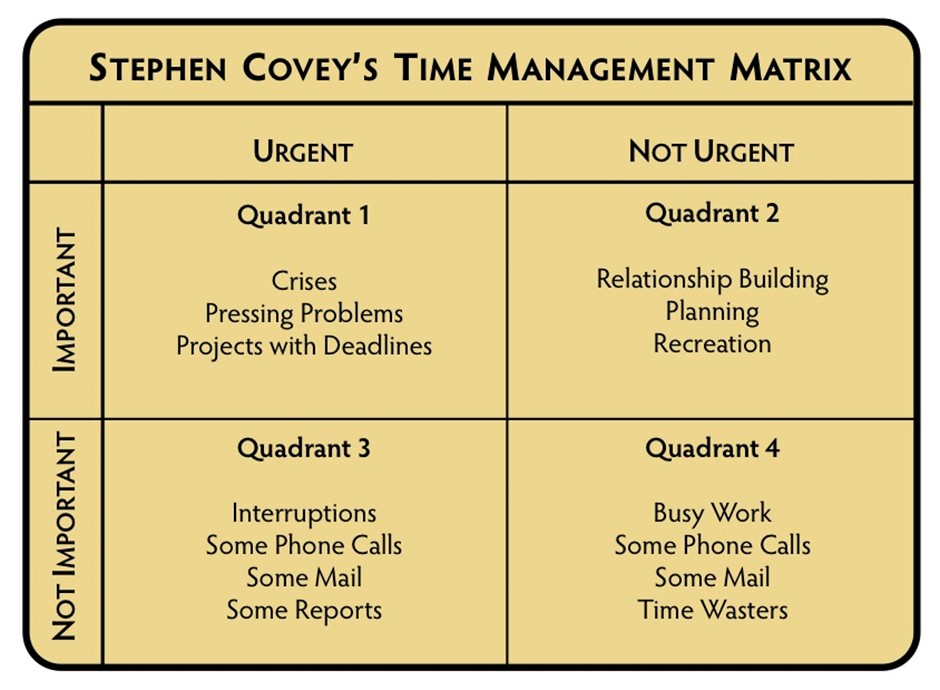
Source: Crowe Associates
A priority matrix is an effective time and project management tool that can assist you in maintaining focus on important tasks and keeping projects on schedule. This prioritization matrix divides tasks into two dimensions based on the four time management quadrants created by renowned businessman Stephen Covey: urgency and importance, impact and effort.
The Eisenhower matrix, which is particularly helpful to manage personal activities and prioritize time, is quite similar in form and use to this matrix. Priority matrix project management, on the other hand, is more suited to project and operations managers that must oversee larger initiatives and teams as well as improve the efficiency of production schedules in order to maximize ROI.
Let’s examine the matrix’s four quadrants individually.
Quadrant 1: Quick wins (High impact, low effort)
High-value activities and unanticipated or postponed projects fall under this category. This quadrant contains tasks that must be finished immediately.
Approach: Finish up these jobs first.
Quadrant 2: Major projects (High impact, high effort)
Project type: High-value work without definite, strict deadlines. These activities will make a difference, but because they don’t have a deadline, they are frequently overlooked or given lower priority.
Approach: Include milestones in your schedule and set deadlines.
Quadrant 3: Fill-ins (Low impact, low effort)
Project type: Lower priority work with flexible deadlines. These are filler jobs that are simple to assign or reprioritize.
Decide whether to assign these assignments or reject them.
Quadrant 4: Thankless tasks (Low impact, high effort)
These time-consuming operations have little bearing on the return on investment for a corporation. Avoid scheduling these chores whenever you can to prevent them from detracting from higher-value work.
Approach: Complete these activities later or try to do away with them altogether.
Your project schedule should consist primarily of “fast win” items. However, the majority of project and operations managers will have to juggle duties in each quadrant. However, you may maximize your time and prospects if you have a clear grasp of how to prioritize each sort of activity.
Who can use a Prioritization Matrix?
Everyone.
For example:
• CEOs – This allows you to look at the big picture while being able to zoom in to see the little things
• A small business owner
• Leaders of organizations (churches, non-profits, ect.)

The science behind why the priority matrix works
No matter how focused, involved, and meticulous you may be, it is not only impractical but also unnecessary to give each assignment the same amount of attention.
Making a priority list or outlining a priority chart makes use of your brain’s innate propensity to concentrate on the most pressing issues at hand. This is what psychologists refer to as selective attention—the brain’s innate propensity to weed away irrelevant information as it continuously processes information.
Selective attention is divided into two types by cognitive scientists: bottom-up and top-down. Bottom-up concentration is reactive and occurs when something diverts your attention and impairs your ability to think clearly. Bottom-up is used to describe situations where you can’t help but pay attention, like when a dog barks, a loud bang, a panicked idea, or a phone notice.
However, top-down thinking is characterized as the selective attention that results in top-notch execution: Top-down or “voluntary” concentration is defined as the ability to focus on one job at a time while being able to perceive the bigger picture. This concentration is goal-oriented and causes brain activity that is based on both past and present circumstances.
According to research, multitasking is a fiction and what we actually do when we say we’re multitasking is just our brains rapidly switching between several tasks. According to experts, switching back and forth consumes extra energy that may be used for your most crucial job and life duties. Additionally, your brain attaches less focus to a task the less important you think it is, making distraction simple and unintentional.
Consider a situation that you deem to be minimal effort and low impact, such as making five additional cold calls for a low-selling good or service rather than pitching the CEO of your firm on a project you’ve been working on for a year. Which task is most likely to have distractions accompany it?
It’s critical to keep an eye on your work, the level of concentration you give it, how frequently and how long you get sidetracked, and how crucial the task is. By offering you a more effective ROI on your limited attention, having a clearly defined priority map will take use of your brain’s natural cognitive processes and provide you a brain power boost.
How to make a priority matrix
You’ll be able to use the priority matrix successfully if you comprehend how and why it functions. To get the most out of every new tactic or instrument, it’s critical to understand exactly how to apply it.
Use a priority matrix by starting with these essential actions:
1. Make a list: Log all of your current projects, goals, and priorities—whether they are daily tasks, ongoing projects, or larger strategic initiatives.
2. Rank each item: On a scale of 1-10, rank each task by its impact on the business. Use the same scale to measure each item on your list by level of effort required.
3. Map it out: With this weighting in place, you’ll be able to strategically plot your activities into appropriate quadrants on the matrix and prioritize, delegate, or deprioritize accordingly.

Benchmarking as a foundation
What are the Four Types of Benchmarking?
The competitive advantage that enables firms to adapt, expand, and prosper through change is benchmarking. In order to determine how and where the organization needs to make changes in order to improve performance, benchmarking is the process of measuring important business metrics and practices and comparing them—within business areas or against a competitor, industry peers, or other companies around the world. Benchmarking can be divided into four categories: practice, performance, external, and internal.
1. Performance benchmarking involves gathering and comparing quantitative data (i.e., measures or key performance indicators). Performance benchmarking is usually the first step organizations take to identify performance gaps.
What you need: Standard measures and/or KPIs and a means of extracting, collecting, and analyzing that data.
What you get: Data that informs decision making. This form of benchmarking is usually the first step organizations take to identify performance gaps.
2. Practice benchmarking involves gathering and comparing qualitative information about how an activity is conducted through people, processes, and technology.
What you need: A standard approach to gather and compare qualitative information such as process mapping.
What you get: Insight into where and how performance gaps occur and best practices that the organization can apply to other areas.
3. Internal benchmarking compares metrics (performance benchmarking) and/or practices (practice benchmarking) from different units, product lines, departments, programs, geographies, etc., within the organization.
What you need: At least two areas within the organization that have shared metrics and/or practices.
What you get: Internal benchmarking is a good starting point to understand the current standard of business performance. Sustained internal benchmarking applies mainly to large organizations where certain areas of the business are more efficient than others.
4. External benchmarking compares metrics and/or practices of one organization to one or many others.
What you need: For custom benchmarking, you need one or more organizations to agree to participate. You may also need a third party to facilitate data collection. This approach can be highly valuable but often requires significant time and effort. That’s why organizations engage with groups like APQC, which offers more than 3,300 measures you can use to compare performance to organizations worldwide and in nearly every industry.
What you get: A factual understanding of your organization’s existing situation that enables you to establish benchmarks and improvement objectives.
Although internal performance benchmarking is frequently a good place to start, external benchmarking that looks at both performance and practice offers the greatest advantages. When you go outside your own desk, department, and business, you have the most influence.
In the end, benchmarking is about having the humility to acknowledge that others are better at something and the knowledge to figure out how to compete with or even outperform them. If you don’t look outside of your own office, department, or business, you’ll never learn that lesson. In the words of the renound management consultant Peter Drucker, “What a business needs most for its decisions—especially its strategic ones—are data about what goes on outside it. Only outside a business are there results, opportunities, and threats.”

Course Manual 10: Roadmapping Tools
You need a flexible document when planning organizational optimization that captures and clearly communicates the important objectives, deadlines, and plans of action for each of your stakeholders–. Not a mountain of paperwork that needs to be thoroughly combed through, but. an organizational roadmap.
A roadmap is a long-term picture of where your organization is heading and how you’re getting there, similar to a business plan. But what sets it apart from a standard business plan is that it provides a higher-level illustration of your company’s overall strategy.
This kind of roadmap outlines the main goals and tactics your business will use to expand. By explicitly defining the business’ future and each department’s role in impending growth, a roadmap helps firms with several departments avoid siloing off individual teams.
Now, several types of roadmaps, such as a strategic roadmap, a startup roadmap, or even something as narrow as a marketing or HR roadmap, can be used to depict corporate progress. However, a roadmap that depicts important business growth initiatives and completion dates for all of a company’s departments is the most typical use case for business growth mapping. Let’s examine this roadmap sample now.
How to visualize your business roadmap
Assume for the moment that our business has past the two-person-in-a-garage stage. You’ve got various teams and departments with many balls in the air (not that this roadmap can’t work for small businesses, but it will be lot easier than what we’re providing.) Product is preparing to launch on mobile. Marketing must make sure the launch’s primary marketing strategy is prepared. They are also preparing for their next event. Sales is following up on a ton of leads that were generated during the previous event. Additionally, HR is actively hiring for all departments.
Anyone working in a business has a lot to think about with all the moving parts. Clarity regarding the direction in which your departments are moving is required for your C-level executives. Your department chiefs need to be assured that their initiatives are advancing the company as a whole rather than being held back by other divisions. Furthermore, if your company is looking for investors or partners, these outside parties will undoubtedly be interested in learning about your future goals for growth.
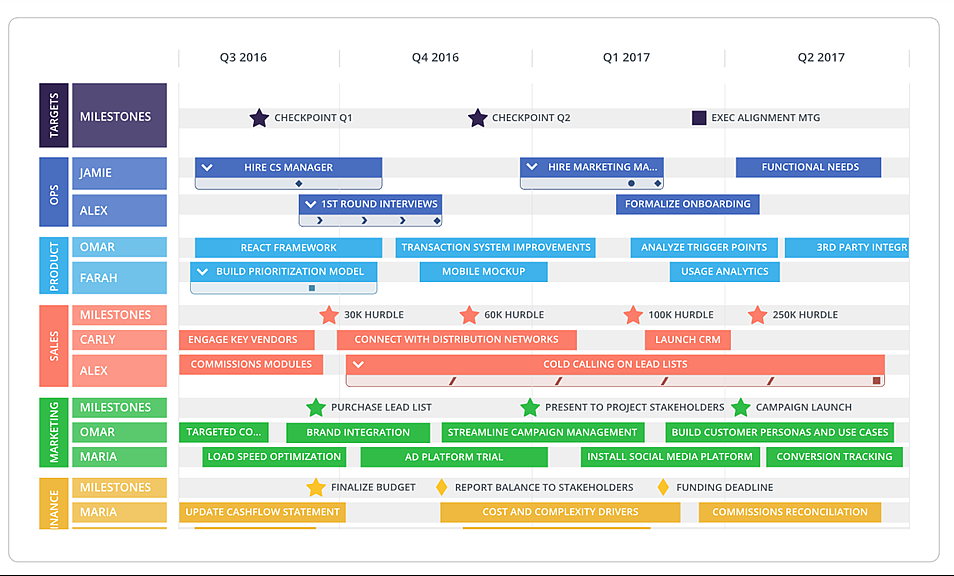
A Timeline:
The team-by-team overview of significant projects and dates is given in a clear and concise manner by your roadmap. Businesses can precisely evaluate each team’s time/resource allocation and commitment to growth-related projects by plotting each department’s growth plan across months, quarters, or a year (the duration is entirely up to you!). This view also dispels (or highlights) any thoughts of being isolated by allowing teams to understand how they collaborate with the rest of the organization to grow the business.
A timeline also enables a company to extract crucial dates via Milestones. It will be simpler for teams to schedule their work in accordance with projected deadlines if everyone in the organization is clear on when to expect specific efforts or goals to be completed.
Businesses that love details can flip this view in a variety of ways to present a more in-depth story about their business strategy. Higher-ups can see whether excessive strain is being placed on specific resources by pivoting the roadmap by owner, as shown in the roadmap above. Better decisions were made on the division of labor as a result.
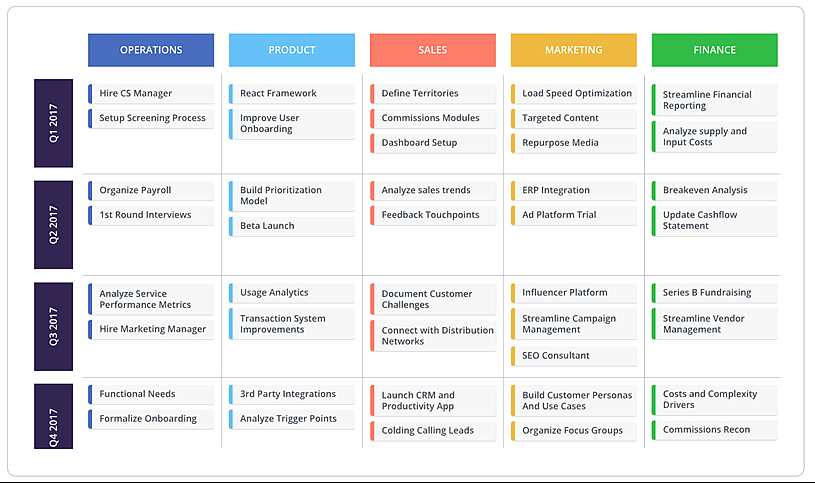
Businesses can arrange their roadmap in a Swimlane View if they don’t like the idea of giving each item a set deadline. You can create swimlanes dedicated to each team and then organize the things by any timeframe while still displaying each department’s unique projects and strategies. Consider this perspective as a glimpse of each team’s main goals over specific time periods. This plan ought to make it simple for anybody to see what each team is attempting to accomplish in each period of time.
Perhaps, though, you’re a more status-oriented businessperson. In that scenario, you can change this view to emphasize the projects for each team that are currently being worked on, scheduled, or suggested. This is yet another way to give everyone who is interested in an update on the state of the company a transparent snapshot.
However, as your business develops, your business objectives will change, and your strategy must adapt. We’re still dealing with a lot of high-level business activities in the aforementioned scenarios, such as operations deciding onboarding procedures, sales cold-calling their lead lists, or marketing implementing conversion tracking. Your ambitions get more specific as you mature.
You could want to lay forth particular revenue or fundraising targets. Alternately, you may change direction to solely highlight each department’s efforts to increase its business in a relatively short period of time. Alternatively, if you’ve attained enterprise status, you might only map LARGE, ambitious commercial skills like launching new product lines or controlling a particular share of the market. Your roadmap must develop in order to represent the more elaborate and detailed objectives that come with corporate expansion.
Regardless of the size of your company, you will always require a growth strategy. Implement a roadmap to bring your entire company into alignment with each team’s efforts to expand the business rather to relying exclusively on a business plan to deliberate growth.
Getting Started with Roadmaps
Any type of project or activity management requires strategic planning, but it’s crucial when putting your company’s vision into action. A straightforward graphic, such as a roadmap, gives you a clear picture of your strategic tasks and milestones and aids in the formulation of a long-term strategy for achieving your objectives.
To make it simpler for you to design and maintain your project or product roadmap, we’ve put up a few resources. From what a roadmap is to practical examples, user-friendly tools, and roadmap templates so you don’t have to design them yourself, you’ll find all you need to know right here. Let’s get going.

What Is a Roadmap in Project Management?
A roadmap, in its simplest form, is a strategic planning tool that groups together a project’s objectives and key deliverables (tasks, milestones) on a timeline. Always keep in mind that a roadmap planner is different from a conventional project plan in that it is a high-level, simple-to-understand strategy tool rather than one that contains all the specifics of a project.
Why Do You Need a Roadmap?
Making a well-thought-out roadmap enables companies and project/product managers to make wise commitment decisions. Roadmaps make ensuring that time and effort are used properly by connecting each work item to the ultimate goal. They also give a solid basis in terms of:
• Clarity – by answering the question “what are you working towards and why?”, a roadmap clarifies strategic goals and how the involved work is linked to the overall strategy.
• Communication – sharing the strategy of an initiative, a roadmap shows direction, visualizes timing, and helps drive conversations with key parties around challenges in a transparent manner.
• Coordination – in large or complex projects, a roadmap enhances collaboration between multiple participants within an organization as it can help track dependencies and identify bottlenecks.
• Accountability – sharing what needs to be delivered and when, a roadmap makes it easier for everyone to follow through on the plan.
• Alignment – clearly stating the vision and the objectives of a project, a roadmap aligns teams, portfolios, or areas of the same business.
• Impact – highlighting how each area of investment ties to a high-level goal, roadmaps easily illustrate the impact of a team’s progress.
• Prioritization – focusing on what is most important, roadmaps help project/product managers make tradeoff decisions and prioritize the work that brings the greatest benefits more easily.
A roadmap, which explains the rationale for a planned action, is advantageous for any kind of business because:
• It clarifies business strategy.
• It communicates company-wide initiatives to internal teams.
• It links department goals to those of the business.
• It shares general plans with external audiences such as partners and advisory boards.
• It tracks organizational performance.
A visual roadmap, which serves as the focal point for all of a team’s efforts, is incredibly helpful for product/project managers in important meetings with clients and executives since it:
• Illustrate how business strategy ties to company goals.
• Translate product goals and initiatives into features and requirements.
• Communicate with leadership, cross-functional teammates, and customers.
• Prioritize new functionalities and enhancements.
• Report progress and status as the project is moving along.
Roadmap Examples
Although a roadmap’s form may differ from project to project, there are several essential components you must include in any roadmap. Which are:
1. Goals and initiatives – defining the value that your product or project brings and how it delivers on business objectives.
2. Releases and milestones – stating when work will start and be delivered.
3. Features – showing the efforts that are prioritized based on their overall value.
4. Dependencies – highlighting interrelated work that might impact delivery.
To sum up, a roadmap must connect your strategy (the “why”), the steps you must take to accomplish your goals (the “what”), and a completion date (the “when”), regardless of the kind of venture it represents.
To learn more about these essential components, look at the sample roadmap below.
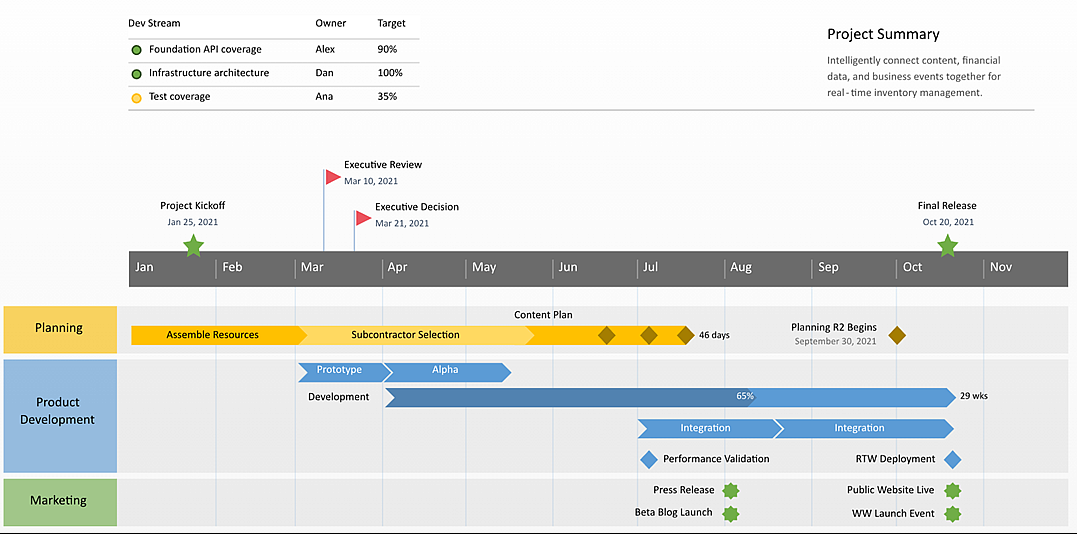
Beyond the Business Plan
Every business roadmap does not have to include the entire organization. They can also map out more specific themes.
Throughout their existence, businesses must cope with transformational activity. Business roadmaps can promote consensus within the organization and improve the efficiency of those procedures.
For instance, firms may need to make a substantial change. This might involve a change in the business model, a change in the suppliers or underlying technology, or a new go-to-market approach. These kinds of projects have many moving parts and involve numerous departments. A roadmap is a fantastic tool for outlining who is responsible for what and when.
A roadmap might be helpful for businesses when they want to introduce new features. A new business unit might be established, a new service might be unveiled, or support for new partners and platforms might be added. It’s a perfect candidate for a business roadmap once more because there are numerous teams engaged and a lot of dependencies.
Along with other strategic objectives including research projects, new sales initiatives, and compliance projects, architectural and IT activities are ideal for roadmaps.
Key Ingredients in a Business Roadmap
Business roadmaps are only helpful if the audience can understand them. Make sure they start with these elements to make ingestion easier.
Breakdown by organizational department:
There are several benefits to highlighting the projects that each division of the business is working on. The visual representation of what each group has planned could reveal resource problems first and foremost. This can lead to certain priorities being rearranged or duties being redistributed.
Additionally, it aids the other departments in the business in understanding what their coworkers are working on. When everything is out in the open, there will be no more “we’re working hard while they’re munching bon-bons” notions. Additionally, the increased visibility fosters greater accountability. Everyone is aware of what is expected of them and why.
State the purpose of each activity:
It’s great to make clear what each person is working on. Even so, it’s more helpful if everyone knows why the task is even being carried out. Business roadmap users gain more insight by grouping each activity into a category that describes its function.
A fantastic method to do this is to connect each task to a strategic objective. Additionally, if each activity is color-coded according to a strategic aim, it is easy to see whether one or two activities received an equivalent amount of effort or resources during specific time periods.
Milestones:
Milestones on a roadmap are commonly associated with software updates or new iterations of the product. On a corporate roadmap, however, a milestone might stand in for any success or significant event.
It may be achieving a revenue goal, participating in a trade show or industry event, forming a strategic relationship, attending a crucial conference, or starting operations in a new area. anything that the participating teams’ combined efforts have produced that is notable. Milestones provide the path even more meaning and perhaps a little more urgency.

Tips for Creating a Compelling Business Roadmap
Despite the fact that business roadmaps are a different animal from product roadmaps, some fundamental concepts still hold true.
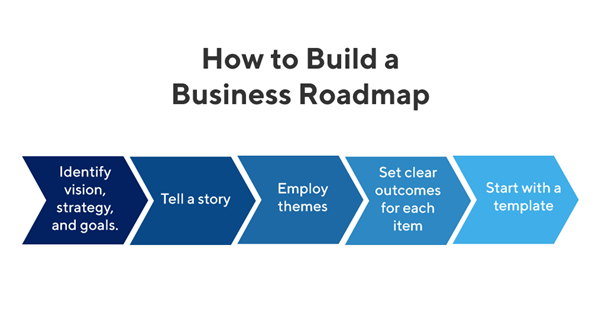
Step 1: Vision, strategy, and goals
Business roadmaps are more likely to be more detailed than the ideal product roadmap since they are execution-focused. But the goal is still to draw an image. A vision of where you want to be, a plan for getting there, and objectives along the route are all present.
Although the vision in this situation is most likely not complete, applying the same criteria for what constitutes a strong roadmap is still true. According to the strategy outlined in the company plan, every task listed in a business roadmap should represent the small steps needed to realize that goal.
Step 2: Tell a story
We’ve stressed numerous times how crucial it is for roadmaps to have a narrative structure and for their authors to be skilled storytellers. This idea also applies to company roadmaps.
Both an issue and a state of being must be achieved by the company. There are sequential stages that various organizational components must take to get there. That picture may be painted by the business roadmap. It might demonstrate how each step forward strengthens the previous one to finish the story.
Step 3: Employ themes
A great roadmap must also make use of themes to organize its components. Themes still have a place on a business plan even though it can demand more concurrent action than a conventional product roadmap.
Themes for a business roadmap might be anything like “creating the environment for transformation,” “updating important systems,” “launching,” or “engaging channel partners.” The context of each work and their appropriate bundling are further solidified by themes.
Step 4: Clear outcomes for each item
When anything is significant enough to be included in your business roadmap, the result should be good and measurable. What is now possible that it wasn’t before? And why is that so crucial, in case it isn’t clear?
Uncharted Territory
You now understand what a business roadmap is. Your firm might be unfamiliar with business roadmaps. Nevertheless, they are an effective tool for putting a lot of information into a format that is simple to understand and highly visible. Check out the template below to get a better idea of how straightforward it may be to align your company with a business roadmap.
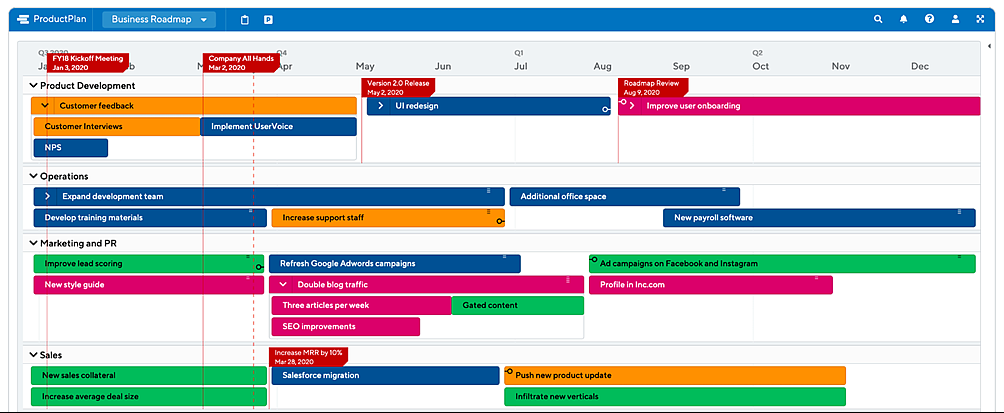
Source: Product Plan

Course Manual 11: Stakeholder Communication and Buy-in
What Are the Benefits of Stakeholder Communication in Regards to Project/Needs Prioritization?
Stakeholders are the individuals and groups whose beliefs and behaviors affect the outcome of your project or business. Employees, labor unions, suppliers, consumers, business partners, investors, shareholders, the local community, government authorities, and regulators are just a few of your stakeholders. Different stakeholders have various priorities, attitudes, and interests. The delivery of information that is pertinent to their needs and the development of good attitudes toward your business or project are both ensured by effective communication.
Better Understanding Your Goals
Stakeholders need to comprehend what you’re aiming to accomplish. When you communicate with workers and labor unions, for instance, your audience will better comprehend your objectives and the advantages to them if they assist you in achieving them. You can get the financing you need for significant projects by maintaining contact with shareholders and investors.
In order to achieve your goals, you must communicate with local government agencies, pressure organizations, and the community if you intend to make changes to your company that will affect the neighborhood.
Creating Influence and Positive Relationships
Relationship-building through communication is a key component of influencing other stakeholders, including the media and special interest groups. Press releases, journalist interviews, and encounters with interest groups foster understanding and guarantee that their messages match your viewpoint.
Building a Dialogue
Dialog is created by communication with stakeholders. You can improve your communications by better knowing the interests and attitudes of your stakeholders by creating forums or encouraging various types of feedback. When you connect through forums or other social media, you can answer criticism and clear up any misunderstandings. As users share their opinions with others, communicating via social media can help your message get out there.
Influencing Sources of Power
The stakeholders who can most significantly affect your success must be the center of your communication strategy. Concentrating your messages on such groups will ensure that they consider your point of view if, for example, government agencies or industry regulators are proposing laws that could harm your company.
Stronger Stakeholder Relationships
You may establish strong, lasting relationships with important groups by communicating with stakeholders frequently and fostering mutual understanding. Numerous advantages come from having a solid friendship. By interacting with clients, you can put yourself in a good position to influence their purchasing decisions.
You can create a supply chain that meets your demands by keeping in touch with your suppliers. Your ability to obtain money may be made easier via shareholder communications.

Stakeholder Buy-in and Why It Matters
Even while the phrase “buy-in” implies money, the majority of stakeholder buy-ins aren’t monetary in origin. It’s the term used to describe getting a given stakeholder’s blessing or agreement on an idea, such as a design or project plan. In reality, the stakeholders who opt to buy in are pledging to embrace the suggested courses of action. Obtaining a loan approval from a lender stakeholder, which also signals that they are prepared to back your idea, is one example of another financial buy-in.
Almost all projects have influential stakeholders, and without their backing, progress might not be made. Any designer or project developer knows how important it is to have employees’ support as well as that of other powerful organizations. It may be impossible to proceed if there is opposition from executives, workers, directors, management, or shareholders. Your project has very little chance of success under this amount of strain. You must therefore interact with them to gain their buy-in and ensure that all key stakeholders are on the same page. This enables you to advance by taking cooperative steps as opposed to rebellious ones.
Tips for Gaining Stakeholder Buy-in
You now have a comprehensive understanding of the different types of stakeholders and why getting their cooperation and consent is crucial for the success of your project. Knowing what to do to get stakeholder buy-in in the most efficient manner is all that’s left to be determined. You’re covered by this course manual because we’ve compiled and described 12 useful suggestions for achieving just that. You’ll need to overcome obstacles, resolve conflicts, and develop your ability to compromise.
1. Ensure You Include All Internal Stakeholders In The Process
The more engaged people are, the simpler it will be to influence them toward a shared objective. It makes sense for project managers to pay closer attention to the person in charge of the budget while paying less attention to other internal stakeholders. Finances are crucial, but it’s also necessary to take into account the internal parties participating in the integration and task procedures. Discuss the situation with them and try to grasp their priorities, needs, and point of view.
2. Speak The Language Of Each Stakeholder Group
Avoid using terminology that only a small group of stakeholders will comprehend. Make sure you address their concerns specifically because the sponsors or lenders will have entirely different goals than the customers or consumers of your product. You must take an interest in their needs if you want them to agree to your demands.
3. Engage As Early As Possible
It is best to become involved as soon as possible. Any project leader is aware of the value of time. Stakeholders’ demands can be met more quickly the earlier you engage them and interact with them. By avoiding stakeholder involvement altogether, you avoid a ton of potential problems.
4. Give a Clear Rationale For The Project
As long as their requests are also being taken seriously, stakeholders are typically amenable to reason. Write down the specific project’s primary aims and objectives and tell stakeholders why they must be met. Give them a thorough knowledge of the main justification for the whole endeavor. You can also convey background details about the current scenario to help people better understand the backdrop.
5. Be Explicit About The Benefits
Put the project’s benefits in the context of the organization’s larger goal to help stakeholders understand their significance. By effectively communicating these considerations, you’ll provide the groundwork for winning the support of influential decision-making stakeholders.
6. Identify And Manage Risks
Risques are the fastest method to drive interested parties away. Although you can’t completely get rid of them in a commercial enterprise, you can certainly cut them down to an acceptable level. It’s critical to implement required risk mitigation measures to reduce potential hazards in order to increase the likelihood that a project will succeed. Prepare a summary of the major risk factors that have been discovered, and then list your well-thought-out response strategies in case they come to pass. This demonstrates competent management conduct and will present a favorable impression to the senior management team. Gaining support from significant parties, particularly sponsors and lenders, is made much simpler by showcasing your skill in risk management.
7. Listen And Communicate
Effective communication is extremely important. You’ll be asking stakeholders’ perspectives as part of the process of gaining buy-in. You must make sure that each stakeholder truly feels that his or her opinions and thoughts are valued on the listening end. Make sure everyone is informed throughout the project and provide your comments.
8. Focus On Telling The Truth, Even When It Isn’t What Stakeholders Want To Hear
No of the expense, being honest fosters a culture of trust between you and the stakeholders. If they don’t already trust you, you can’t expect them to accept your suggestions. Stakeholders must never experience a persistent disconnect from the management, the team, or the business as a whole. Such emotions make it impossible to secure buy-ins, which instantly undermines enterprises.
You must comprehend the significance of transparency from the start if you want to avoid such a catastrophe. Things that you know will affect a stakeholder’s decision-making should not be hidden or omitted. Avoid making exaggerated claims and never provide solutions you aren’t certain you can carry out. Ask for extra time to look into things rather than making firm promises right away. Even if it’s a response they won’t appreciate, telling them the truth demonstrates your reliability to them. Your relationship with stakeholders will improve if you are objective and honest with them, which will increase the likelihood that they will buy-in.
9. Make Sure Stakeholders Understand Their Contribution To a Project
You should be able to comfortably picture each stakeholder’s needs and motives by this point. Being sincere and honest with them has already helped you win their trust, which is always beneficial. The following stage would be to help them realize how important each of their contributions is to the project’s success. Indicate the advantages they could contribute to the project and the potential rewards it could bring them. Make sure you clearly communicate each of their important tasks in relation to the project’s deliverables. Clarifying these hazy boundaries will be a crucial step in persuading them to support you and work together with you to achieve success together.
10. Reaffirm Goals and Communicate Progress Throughout The Execution
Setting objectives and developing a recognized reliance on stakeholders’ performance are crucial, but they won’t get you through the entire process. Every engaged stakeholder must receive regular updates and reassurances of the targets in order for professional execution to take place. Without constant direction, it’s simple to lose sight of the long-term objective being pursued. Managers frequently expect that the stakeholders would just grasp and remain focused on their tasks throughout the project execution process. Without regular checks, such irrational expectations could prevent the project’s advancements. Make sure you continuously repeating the deliverables and responsibilities at hand to avoid losing the buy-in you’ve already gained.
11. Remain Consistent
A project manager must be consistent in his management techniques. All of your communication throughout the course should be consistent, including your speech patterns, instructions, and frequency. For the objectives of the project, stakeholders must believe you to be dependable, reachable, and available. For them to continue to be invested and devoted to their buy-ins, stakeholders need stability, whether they are aware of it or not.
12. Provide Positive Feedback After The Project Ends
You must never forget to provide feedback as a final touch while a project is wrapping up, just like you would with any other project-related activity. Describe how effective each stakeholder’s contributions have been during the project’s implementation. Feedback on potential areas for improvement should also be given. I sincerely appreciate the support and input from all the parties that were involved.
Conclusion
In conclusion, keep in mind that it is crucial to include significant stakeholders from the beginning. Never undervalue the opportunities that growing collaboration brings about. Give the stakeholders a priority based on their influence and interest, and assist them in appreciating the importance of their presence and contribution. As time went on, you would have developed a strong rapport with those close to you and be prepared to tackle another difficult assignment as a team.

Case Study: How Unilever effectively communicates with it’s stakeholders
Unilever explains how they must collaborate closely with all of its stakeholders in order to fulfill their purpose and expand their business, including their employees, shareholders, governments and regulators, suppliers, customers, scientists, non-governmental organizations (NGO), communities, and peer businesses (often through trade associations). The multi-stakeholder model used by Unilever and how it is intended to provide value to all stakeholders are both explained in the Compass.

Transparent and responsible
They are steadfastly committed to conducting themselves ethically. Unilever strives to be open and truthful with their stakeholders in whatever they do.
The greatest standards of conduct are required in order to uphold their reputation and foster confidence. The standards that Unliever expects of all of its employees are outlined in their Code of Business Principles and Code Policies, which include one of the four code themes, “Engaging Externally,” which addresses topics like ethical marketing, political activism and donations, and interactions with the government, regulators, and NGOs. They also demand the same morals and conduct from those with whom they work.
How Unliever engages with their stakeholders
Unilever, a multinational corporation with products sold in almost 190 countries, engages in daily interactions with a broad spectrum of stakeholders. A overview of how they interact with some of their most significant stakeholder groups is given below.
Shareholders
Open and efficient communication with their shareholders is important to Unilever. Through quarterly results broadcasts, conference presentations, meetings, and calls, they communicate directly with shareholders about many areas of business performance and consumer trends.
On a variety of topics, senior executives and their Board have direct conversations with shareholders. Unilever, for instance, discussed innovation and non-animal testing methods with investors in 2021. Unilever presented their Climate Transition Action Plan to their shareholders for a vote as part of their engagement efforts in 2021.
Their people
148,000 talented individuals work with Unilever in more than 100 nations, contributing their talents and time in offices, factories, R and D facilities, and tea estates. Their success depends on maintaining their interest and keeping them informed.
Unilever offers their employees numerous opportunities to voice their opinions to them. Their yearly UniVoice survey is an important resource for gauging employee attitude. The UniVoice employee survey was completed by almost 90,000 workers in 2021. Unilever maintained extremely high levels of employee engagement (82% in offices and 83% in factories), placing them in the top percentile when compared to industry norms.
In order to provide their workers with direct access to their leadership team on a regular basis, Unilever holds biweekly “Your call” sessions with their CEO and ULE members. During these sessions, the leadership team responds to queries on pressing topics. Unilever often hosts virtual town hall meetings in each market to interact with employees about issues and subjects that are pertinent to that location.
Unilever hosts virtual “Compass Live” events, inviting key senior leaders from across their business to engage with and inform their employees on the Unilever Compass strategy and their progress throughout the year. This helps to keep their employees informed and engaged about their Compass strategy.

Course Manual 12: Define Stakeholders for Process Improvement Projects
How to do a stakeholder analysis
You may utilize your project charter to begin mapping out your stakeholders as soon as it is finished and the project’s scope is established. Here’s how to start the stakeholder analysis process off right.
1. Identify your stakeholders
You must first determine who your genuine stakeholders are. To achieve this, create a comprehensive list of all of your project’s stakeholders, both internal and external, using your project charter and any other plans and paperwork you may have.
Remember that some stakeholders won’t get involved until later in the project’s lifespan, but if you can predict who they will be in advance, you can start to gain their support, establish a rapport with them right away, and make them feel connected.
2. Prioritize your stakeholders
You may begin to prioritize your stakeholders once you’ve determined who they are.
Setting your stakeholders’ priorities will assist you decide where to devote your resources. In other words, it aids the project manager in determining who the major decision-makers are at any given time, enabling them to make sure they are speaking with the appropriate individuals at the appropriate time.
Stakeholder prioritizing can be accomplished in a number of ways, but one straightforward option is to map out the stakeholders using a power/interest (or power/influence, or impact/influence) grid.
By responding to two important questions that help you classify them into one of four categories, the power/interest grid enables you to identify your key stakeholders:
• What level of power do they have?: How crucial is it that they are pleased with the project’s development and outcomes? What proportion of the project’s success depends on them? How much sway do they have on the project, other stakeholders, the team, etc.? (Remember that a stakeholder might have either positive or negative influence.)
• What level of interest do they have?: Do they care deeply about this project or are they merely loosely involved with it? Is it something for which they bear sole responsibility? Do they depend on it for other tasks or outcomes? Are they against the project or are they worried about it in any way?
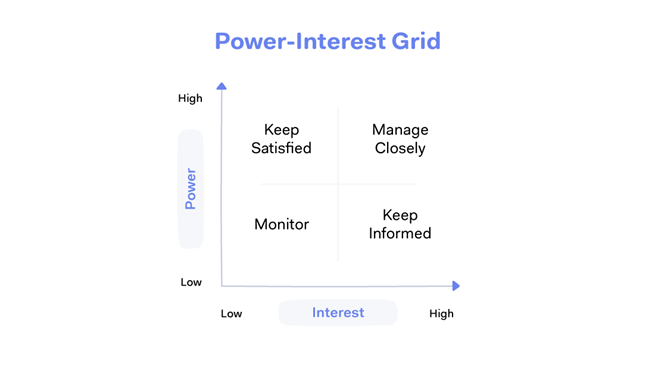
The stakeholders in the top-right quadrant of the matrix above (powerful + interested) are the ones you should pay special attention to since they can have the biggest influence on your project — for better or worse.
3. Understand your stakeholders
You need to fully understand their expectations for the project now that you are aware of who the important participants are and which ones to give top priority.
This can entail scheduling a brief in-person interview or talk with key stakeholders to go over topics like:
• What their definition of project success looks like
• Any concerns or reservations they have about the project or its outcomes
• What their expectations for the project are
• What impact a positive or negative project outcome would have on them
• Whether there are any anticipated conflicts of interest with other stakeholders that you need to be aware of
These discussions will not only help you comprehend each stakeholder’s involvement in and perspective on the project, but they will also help you develop a more comprehensive understanding of your stakeholder network and how each stakeholder interacts with the others.
Additionally, interacting with the key stakeholders at the start of the project allows you to establish relationships with each stakeholder and gauge certain fundamental interpersonal preferences (like communication style).
If you can, keep an eye out for any political, cultural, or environmental signs when you’re doing this as well. When it comes to managing your project or anticipating certain decisions, being aware of factors like the political atmosphere of the business, how your main stakeholders communicate with one another, and any potential conflicts of interest can help.

How to manage your project stakeholders
The first step in stakeholder management is to identify your stakeholders and their demands. But things don’t stop there. The needs, goals, and satisfaction of your key stakeholders should be a constant focus throughout your project if you want it to succeed.
However, this does not imply that the stakeholder is always correct. In fact, a project manager’s role may occasionally require them to push back against the stakeholders and re-align their expectations with the project charter and project plan that everyone initially agreed upon.
The challenge is striking a balance between everyone’s demands, wants, and goals so you can satisfy your stakeholders and complete the project on time.
Here are some methods you can use to set up some best practices for stakeholder management and build stronger stakeholder interactions across every stage of your project.
Document each stakeholder’s roles and needs
All that work you put into figuring out who your stakeholders were and what they each needed from the project? Make sure you have a record of everyone’s position and duties and keep you all on the same page by gathering it into a common, accessible document.
You may manage a huge number of people and priorities by keeping track of them by creating a stakeholder registration for your project. You can make sure you’re always leading the project in the right path and keeping the right people informed at the right moments by having a definitive document you can update, revise, and consult as your project advances.
And speaking of which…
Communicate with your stakeholders
One of the most crucial tasks is to keep your stakeholders informed, involved, and motivated throughout the project’s lifecycle.
Your “priority” stakeholders will definitely change based on what stage of the project you’re in, as was already mentioned. That’s advantageous since you can focus your efforts where they’re needed and stop educating folks on things they don’t need to know.
This is crucial because, while you want to provide your stakeholders visibility, both inadequate and excessive communication can be annoying.
By utilizing a project management solution with a variety of communication options, you can customize your notifications to meet the specific requirements of each stakeholder while still maintaining a complete audit trail of each action and decision (which is especially handy when it comes to reporting time).
Give project stakeholders visibility over what matters to them
By designing personalized Dashboards, you can assist each stakeholder in sifting through the clutter and get quick insights into the data that matter most to them. Create individualized Dashboards with panels to monitor your team management, including tasks, project statuses, team activity, milestones, risks, and more, so your stakeholders can easily see how specific project components are progressing and get an immediate overview of the information they care about at a glance.
Stakeholders shouldn’t come last in planning. Instead, incorporate them into your project from the start by staying in touch with them, keeping them informed, involving them, and making sure they feel heard and respected.
The ability of the project manager to successfully negotiate and handle the complex nature of the multiple affected stakeholders of a project is one factor that unites successful process improvement projects, as was previously indicated.
Stakeholders have a significant impact on projects, if not the most. Therefore, managing relationships with sponsors and stakeholders is essential to ensuring the success of projects, including the adoption and use of team recommendations. The word “connection” is crucial. This suggests that stakeholder management entails more than just recognizing them. An emotional link between two people is what defines a relationship. Project managers need to be aware of this emotional link in order to have successful process improvement initiatives. As a result, they should concentrate on honing their interpersonal communication skills. The project manager must make sure that all stakeholders are not only identified but also examined in order to foster ongoing relationships and support for the endeavor. Project managers must ensure that stakeholders support the team management strategy, the use of high-quality tools and data to aid in decision-making, and the testing techniques the project manager will employ to confirm recommendations. Otherwise, the project management strategy or technique could be continuously contested by sponsors or other stakeholders.
Identifying the various stakeholder types should be one of a project manager’s initial tasks. The project team, auxiliary bodies, governing bodies, and clients are the four main groups of stakeholders listed in the Stakeholder Relationship Skills for Project Managers course offered by the International Institute for Learning (IIL). A project manager should go one step further and create categories for stakeholder assessment when individual stakeholders have been identified. What different factors or dimensions can provide hints on how to manage complicated stakeholder relationships? Are stakeholders in favor of the project or are they opposed to it? Do they hold a lot of authority or influence? Exists open hostility between project stakeholders that might have an impact? Following the identification of these characteristics, the project manager may quickly evaluate the stakeholders, decide where to focus, and create a strategy to address and strengthen those stakeholder relationships. A quick method for performing this evaluation is shown in Exhibit 2. Stakeholder groups and other variables or dimensions can be altered or added to this matrix as needed. Any scale or weighting system can be used to assign ratings.
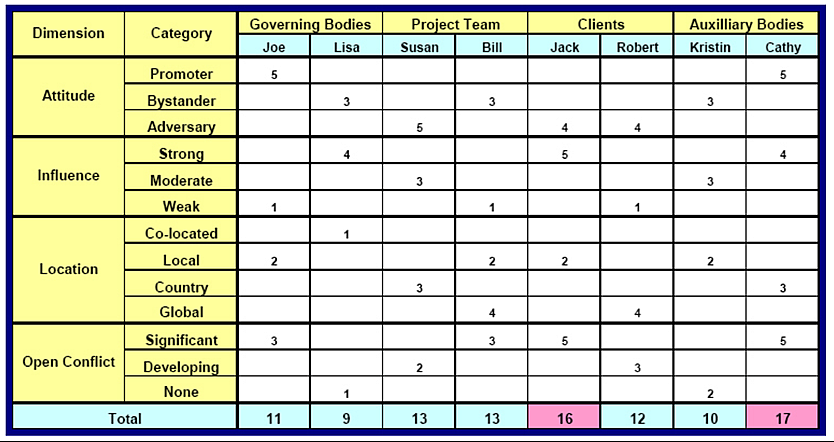
Exhibit 2: Example of a simple Stakeholder Assessment Matrix
A project manager only needs to apply a variety of interpersonal skills to actively work on and strengthen those stakeholder relationships once stakeholders have been discovered, evaluated, and prioritized. This will help the project team be more productive. Here are some ideas for how to strengthen bonds with others:
• Persuade others to adopt and support the project or your point of view using promoting and negotiation skills
• Inspire others to work enthusiastically toward project objectives through influencing, facilitating, and mentoring efforts
• Instill trust in your desire and ability to achieve win/-in results through communication and managing change
• Enable accurate diagnosis and appropriate response to “special” project needs through creative problem solving and networking
The effectiveness of process improvement projects is critically dependent on the management of stakeholder relationships. Even the best initiatives with the most skilled project managers run the danger of failing without stakeholder support. Throughout the course of the project, project managers should proactively invest time in enhancing stakeholder relationships utilizing a variety of effective interpersonal skill strategies.
Team Ground Rules
Projects of any kind can easily become problematic. It is inevitable that issues may develop while working with diverse stakeholder groups, team members, degrees of experience, and departments. Projects for process improvement (PI) are by definition quite prone to issues. Usually, a PI project is put together because the current outcomes are insufficient. Process improvement projects typically consist of cross-functional teams because processes nearly always cut across departments within a business. Some of these silos, or departments, frequently have contrasting goals and opinions, or they may just not get along very well. Here is where things start to go wrong. Every project encounters a variety of difficulties, disputes, and problems. The project and team will be impacted by how such issues are handled. To properly manage these difficulties, a project manager needs some form of instrument or method. The basic solution is ground rules.
The term “ground rules” refers to a set of guidelines for how the team will communicate, make choices, and manage problems that need to be dealt with. The project manager must really design the ground rules and then use them if they are to be applied successfully. The ability to detach from the circumstance and confront the disagreement or scenario without unneeded or detrimental emotion is the key to the effectiveness of ground rules for a project manager. The project manager essentially takes on the role of ground rules document facilitator; nothing more, nothing less.
Prior to the team beginning to work together, it is best to lay out the ground rules during the kick-off meeting. The project manager should start a list of ground rules subjects, but they should be open to team additions. The team should remain involved, and agreement should be reached on the “ground rule” for each potential issue, or how each issue would be handled. To ensure that the project’s sponsor is actively participating at the proper level, the project manager should even create ground rules tailored specifically for him or her. Then, simply refer back to the ground rules when issues arise (because they always will). It is that simple. The possibilities that teams might encounter are listed in Exhibit 3 and should be discussed at the ground rules discussion.

Exhibit 3: Situations that Grounds Rules Can and Should Address
A project manager’s best friend can be a basic, understandable, and effective instrument or technique. One such instrument is a set of ground rules. In addition to assisting a team in learning how to collaborate, ground rules also enable a project manager to handle challenging situations more calmly and effectively.
Process Improvement Methods
The goal of a process improvement project is to enhance outcomes. However, getting better results isn’t always simple. To move a project from its current outcomes to higher performance, a project manager needs a tried-and-true approach. The Six Sigma DMAIC steps might be useful for any project involving process improvement in this situation. Define, Measure, Analyze, Improve, and Control is referred to as DMAIC. There are only five steps, so they are simple to comprehend, easy to remember, and make sense. If used effectively, this tried-and-true methodology can enhance any procedure.
What is a project’s overarching goal? Why are you being asked to collaborate on a project by a company executive or organization? Really, it’s very easy. Any project you are managing should benefit the company in some way, whether it be through lower expenses, higher sales, improved productivity, fewer errors, or shorter cycle times. The list is endless. You work hard, along with your colleagues, to improve a critical area of the company. However, teams frequently fail to see that their goal is improvement. They become bogged down in the details and paperwork associated with project management, such as scope documents, meeting minutes, action item lists, jeopardy logs, and meeting due dates.
Improving results necessitates the identification, definition, and monitoring of key and process measures. When process modifications are done, it should be possible to see evidence of progress on the key measure compared to the baseline “before” photos.
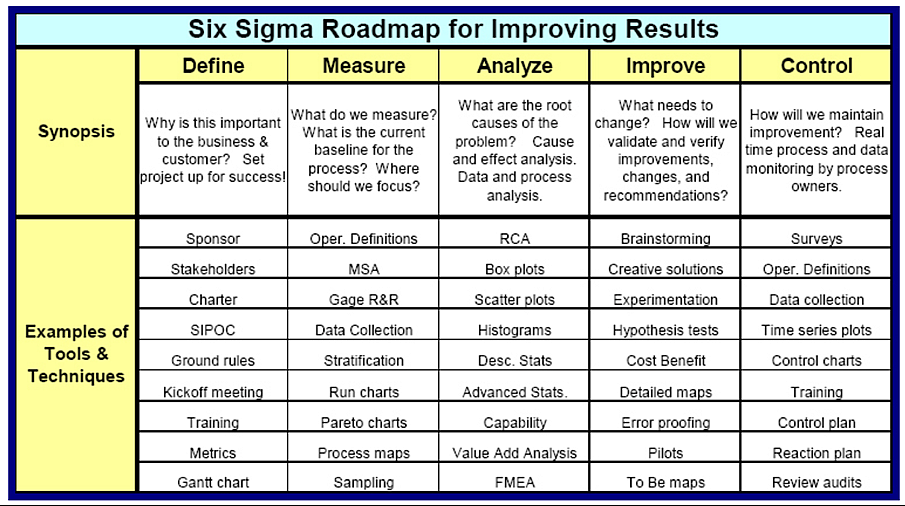
Exhibit 4: Process Improvement/Six Sigma Roadmap for Improving Results
Metrics are established early in a project as part of the DMAIC “Define” process, along with other deliverables. A project manager only needs to guide the project team through the DMAIC steps once the appropriate metrics have been decided upon, using the required tools and approaches under each step to enhance outcomes. Although this does necessitate a basic knowledge of DMAIC and Six Sigma, it is nothing an experienced project manager can’t handle. The Six Sigma road map for enhancing results is presented in Exhibit 4. Implementing these phases into the real project management process will give it structure, take emotion out of the decision-making process, and provide better, more long-lasting results.
Project Facilitation
The value of project facilitation can be attested to by anyone who has ever worked on a project where the project manager was a poor facilitator. An great facilitator makes all the difference in the world as a project manager. Teams collaborate. People sense a connection. Nothing seems to go wrong. Most project managers are excellent planners and natural leaders. But that doesn’t necessarily imply that they make effective facilitators.
Finding a skilled facilitator is really difficult. Only a few people are “naturals” with this skill set; for the rest of us, it takes work, practice, and ongoing improvement. A few essential traits of outstanding facilitators include:
• Leads but doesn’t dominate
• Actively listens
• Maintains momentum
• Encourages participation
• Leads by example
• Keeps the sponsor actively involved (but ensures sponsors do not micromanage)
• Documents to the level needed (nothing unnecessary, does not go overboard)
• Is very organized

Exhibit 5: Example of a Simple Facilitation Development Matrix
The ideal coach or quality advisor, according to “The Team Handbook,” possesses a combination of people, technical, and training skills—talents that are rarely found together. Becoming a good facilitator also requires displaying compassion and awareness for others. Project managers should always strive to develop their facilitation abilities. A straightforward personal growth matrix is simple to make, as shown in Exhibit 5. Every project might begin with a self-evaluation by the project manager, who could then actively endeavor to strengthen any areas that were found to be weak. A project manager’s facilitation skills will increase only by using this proactive approach to self development.
Big-picture thinkers make effective facilitators. They can guide a team toward the project’s goals because they have a clear vision for it. Experienced facilitators employ a technique (such as the DMAIC stages previously stated) as a framework to guide a project team. They are self-assured but modest people. Effective facilitators guide, develop, coach, and assist teams so they can “get there” on their own. Keep in mind that a project manager should be happy when the team succeeds.
Testing and Experimentation
The simple truth is that improving results is difficult—very difficult. Processes can be challenging. The complexity of the process, the number of hand-offs, the variety and number of departments involved, the variation among the process participants, the accuracy of the measurement system, the variety of customer requests or expectations, and the accuracy of upstream inputs and information are just a few of the many variables that can affect a process or key measure. There are undoubtedly many other factors as well; these are but a few of the many that can affect results. Changes to the process must overcome all of these obstacles in addition to those not listed for there to be an effect. The issue is that not all suggestions for improvement are sound ones. Though some ideas do contribute, the majority, if not all, either have no bearing on the important variable under investigation or even work against it. So how does a project manager decide what has to be modified or suggested? The approach is simple: identify what genuinely works and what concepts enhance the main metric, then put those concepts into practice.
In contrast, the project manager must ascertain whether process modifications have no or a negative impact on the outcomes, and then make sure that those modifications are not advised. Data should be used as the basis for decisions, not opinion, experience, conjecture, or hierarchical position, when deciding which ideas to implement or not.
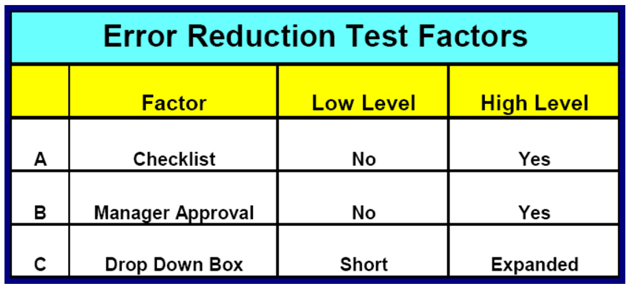
Exhibit 5: Examples of Test Ideas/Factors with Levels
The project manager must become familiar with the art and science of experimentation in order to determine which process adjustments are excellent ideas and actually have an impact on the key metric under review. Exhibit 5 shows how suggestions for improvement discovered during the project’s Define-Measure-Analyze phases are essentially transformed into test factors. Each enhancement suggestion should have two levels: a “low level” and a “high level.” The low level typically represents the current state of affairs, whereas the high level refers to a novel notion. A test matrix is made based on the quantity of ideas generated, and an experiment can then be conducted to determine which ideas have a substantial impact on the outcomes. Although not difficult, experiment analysis does require some training.
Conclusion
Simply said, it is challenging to enhance outcomes. Everyone would be doing it if it were simple. Due to this same reason, process improvement projects are arguably the most challenging to manage. The project manager must include five essential components in any project for it to be successful, which is determined by a significant improvement in the key measure. For a project to be supported, proper stakeholder assessment and relationship management are essential. Setting ground rules for a team can make it much easier for them to collaborate. Decision-making will be improved, and emotion and knee-jerk reactions will be diminished, by using the DMAIC improvement processes as a template to direct the project forward. The most challenging undertakings appear considerably easier when facilitation abilities are actively practiced and improved. Finally, utilizing strong testing techniques to confirm and validate recommendations would guarantee ground-breaking outcomes. Any process improvement project will benefit immensely from the proper application of these five essential factors if it is to function smoothly, produce better outcomes, and ultimately be successful.
Workshop Exercises

Needs Prioritization Exercises
01. Defining a Need : Explain in your own words how this process will directly impact upon your department?
02. Organizational Priorities : Explain in your own words how this process will directly impact upon your department?
03. Purpose and Vision : Explain in your own words how this process will directly impact upon your department?
04. Prioritization Process : Explain in your own words how this process will directly impact upon your department?
05. Identifying and Clarifying Needs : Explain in your own words how this process will directly impact upon your department?
06. Define Characteristics of Each Need : Explain in your own words how this process will directly impact upon your department?
07. Tackling Needs in Order of Urgency : Explain in your own words how this process will directly impact upon your department?
08. Additional Criteria for Needs Prioritization : Explain in your own words how this process will directly impact upon your department?
09. Prioritization Tools : Explain in your own words how this process will directly impact upon your department?
10. Roadmapping Tools : Explain in your own words how this process will directly impact upon your department?
11. Stakeholder Communication and Buy-in : Explain in your own words how this process will directly impact upon your department?
12. Define Stakeholders for Process Improvement Projects : Explain in your own words how this process will directly impact upon your department?

SWOT and MOST Analysis Exercises
01. Undertake a detailed SWOT Analysis in order to identify your department’s internal strengths and weaknesses and external opportunities and threats in relation to each of the 12 Needs Prioritization processes featured above. Undertake this task together with your department’s stakeholders in order to encourage collaborative evaluation.
02. Develop a detailed MOST Analysis in order to establish your department’s: Mission; Objectives; Strategies and Tasks in relation to Needs Prioritization. Undertake this task together with all of your department’s stakeholders in order to encourage collaborative evaluation.
Project Studies
Project Study (Part 1) – Customer Service
The Head of this Department is to provide a detailed report relating to the Needs Prioritization process that has been implemented within their department, together with all key stakeholders, as a result of conducting this workshop, incorporating process: planning; development; implementation; management; and review. Your process should feature the following 12 parts:
01. Defining a Need
02. Organizational Priorities
03. Purpose and Vision
04. Prioritization Process
05. Identifying and Clarifying Needs
06. Define Characteristics of Each Need
07. Tackling Needs in Order of Urgency
08. Additional Criteria for Needs Prioritization
09. Prioritization Tools
10. Roadmapping Tools
11. Stakeholder Communication and Buy-in
12. Define Stakeholders for Process Improvement Projects
Please include the results of the initial evaluation and assessment.
Project Study (Part 2) – E-Business
The Head of this Department is to provide a detailed report relating to the Needs Prioritization process that has been implemented within their department, together with all key stakeholders, as a result of conducting this workshop, incorporating process: planning; development; implementation; management; and review. Your process should feature the following 12 parts:
01. Defining a Need
02. Organizational Priorities
03. Purpose and Vision
04. Prioritization Process
05. Identifying and Clarifying Needs
06. Define Characteristics of Each Need
07. Tackling Needs in Order of Urgency
08. Additional Criteria for Needs Prioritization
09. Prioritization Tools
10. Roadmapping Tools
11. Stakeholder Communication and Buy-in
12. Define Stakeholders for Process Improvement Projects
Please include the results of the initial evaluation and assessment.
Project Study (Part 3) – Finance
The Head of this Department is to provide a detailed report relating to the Needs Prioritization process that has been implemented within their department, together with all key stakeholders, as a result of conducting this workshop, incorporating process: planning; development; implementation; management; and review. Your process should feature the following 12 parts:
01. Defining a Need
02. Organizational Priorities
03. Purpose and Vision
04. Prioritization Process
05. Identifying and Clarifying Needs
06. Define Characteristics of Each Need
07. Tackling Needs in Order of Urgency
08. Additional Criteria for Needs Prioritization
09. Prioritization Tools
10. Roadmapping Tools
11. Stakeholder Communication and Buy-in
12. Define Stakeholders for Process Improvement Projects
Please include the results of the initial evaluation and assessment.
Project Study (Part 4) – Globalization
The Head of this Department is to provide a detailed report relating to the Needs Prioritization process that has been implemented within their department, together with all key stakeholders, as a result of conducting this workshop, incorporating process: planning; development; implementation; management; and review. Your process should feature the following 12 parts:
01. Defining a Need
02. Organizational Priorities
03. Purpose and Vision
04. Prioritization Process
05. Identifying and Clarifying Needs
06. Define Characteristics of Each Need
07. Tackling Needs in Order of Urgency
08. Additional Criteria for Needs Prioritization
09. Prioritization Tools
10. Roadmapping Tools
11. Stakeholder Communication and Buy-in
12. Define Stakeholders for Process Improvement Projects
Please include the results of the initial evaluation and assessment.
Project Study (Part 5) – Human Resources
The Head of this Department is to provide a detailed report relating to the Needs Prioritization process that has been implemented within their department, together with all key stakeholders, as a result of conducting this workshop, incorporating process: planning; development; implementation; management; and review. Your process should feature the following 12 parts:
01. Defining a Need
02. Organizational Priorities
03. Purpose and Vision
04. Prioritization Process
05. Identifying and Clarifying Needs
06. Define Characteristics of Each Need
07. Tackling Needs in Order of Urgency
08. Additional Criteria for Needs Prioritization
09. Prioritization Tools
10. Roadmapping Tools
11. Stakeholder Communication and Buy-in
12. Define Stakeholders for Process Improvement Projects
Please include the results of the initial evaluation and assessment.
Project Study (Part 6) – Information Technology
The Head of this Department is to provide a detailed report relating to the Needs Prioritization process that has been implemented within their department, together with all key stakeholders, as a result of conducting this workshop, incorporating process: planning; development; implementation; management; and review. Your process should feature the following 12 parts:
01. Defining a Need
02. Organizational Priorities
03. Purpose and Vision
04. Prioritization Process
05. Identifying and Clarifying Needs
06. Define Characteristics of Each Need
07. Tackling Needs in Order of Urgency
08. Additional Criteria for Needs Prioritization
09. Prioritization Tools
10. Roadmapping Tools
11. Stakeholder Communication and Buy-in
12. Define Stakeholders for Process Improvement Projects
Please include the results of the initial evaluation and assessment.
Project Study (Part 7) – Legal
The Head of this Department is to provide a detailed report relating to the Needs Prioritization process that has been implemented within their department, together with all key stakeholders, as a result of conducting this workshop, incorporating process: planning; development; implementation; management; and review. Your process should feature the following 12 parts:
01. Defining a Need
02. Organizational Priorities
03. Purpose and Vision
04. Prioritization Process
05. Identifying and Clarifying Needs
06. Define Characteristics of Each Need
07. Tackling Needs in Order of Urgency
08. Additional Criteria for Needs Prioritization
09. Prioritization Tools
10. Roadmapping Tools
11. Stakeholder Communication and Buy-in
12. Define Stakeholders for Process Improvement Projects
Please include the results of the initial evaluation and assessment.
Project Study (Part 8) – Management
The Head of this Department is to provide a detailed report relating to the Needs Prioritization process that has been implemented within their department, together with all key stakeholders, as a result of conducting this workshop, incorporating process: planning; development; implementation; management; and review. Your process should feature the following 12 parts:
01. Defining a Need
02. Organizational Priorities
03. Purpose and Vision
04. Prioritization Process
05. Identifying and Clarifying Needs
06. Define Characteristics of Each Need
07. Tackling Needs in Order of Urgency
08. Additional Criteria for Needs Prioritization
09. Prioritization Tools
10. Roadmapping Tools
11. Stakeholder Communication and Buy-in
12. Define Stakeholders for Process Improvement Projects
Please include the results of the initial evaluation and assessment.

Project Study (Part 9) – Marketing
The Head of this Department is to provide a detailed report relating to the Needs Prioritization process that has been implemented within their department, together with all key stakeholders, as a result of conducting this workshop, incorporating process: planning; development; implementation; management; and review. Your process should feature the following 12 parts:
01. Defining a Need
02. Organizational Priorities
03. Purpose and Vision
04. Prioritization Process
05. Identifying and Clarifying Needs
06. Define Characteristics of Each Need
07. Tackling Needs in Order of Urgency
08. Additional Criteria for Needs Prioritization
09. Prioritization Tools
10. Roadmapping Tools
11. Stakeholder Communication and Buy-in
12. Define Stakeholders for Process Improvement Projects
Please include the results of the initial evaluation and assessment.

Project Study (Part 10) – Production
The Head of this Department is to provide a detailed report relating to the Needs Prioritization process that has been implemented within their department, together with all key stakeholders, as a result of conducting this workshop, incorporating process: planning; development; implementation; management; and review. Your process should feature the following 12 parts:
01. Defining a Need
02. Organizational Priorities
03. Purpose and Vision
04. Prioritization Process
05. Identifying and Clarifying Needs
06. Define Characteristics of Each Need
07. Tackling Needs in Order of Urgency
08. Additional Criteria for Needs Prioritization
09. Prioritization Tools
10. Roadmapping Tools
11. Stakeholder Communication and Buy-in
12. Define Stakeholders for Process Improvement Projects
Please include the results of the initial evaluation and assessment.

Project Study (Part 11) – Logistics
The Head of this Department is to provide a detailed report relating to the Needs Prioritization process that has been implemented within their department, together with all key stakeholders, as a result of conducting this workshop, incorporating process: planning; development; implementation; management; and review. Your process should feature the following 12 parts:
01. Defining a Need
02. Organizational Priorities
03. Purpose and Vision
04. Prioritization Process
05. Identifying and Clarifying Needs
06. Define Characteristics of Each Need
07. Tackling Needs in Order of Urgency
08. Additional Criteria for Needs Prioritization
09. Prioritization Tools
10. Roadmapping Tools
11. Stakeholder Communication and Buy-in
12. Define Stakeholders for Process Improvement Projects
Please include the results of the initial evaluation and assessment.

Project Study (Part 12) – Education
The Head of this Department is to provide a detailed report relating to the Needs Prioritization process that has been implemented within their department, together with all key stakeholders, as a result of conducting this workshop, incorporating process: planning; development; implementation; management; and review. Your process should feature the following 12 parts:
01. Defining a Need
02. Organizational Priorities
03. Purpose and Vision
04. Prioritization Process
05. Identifying and Clarifying Needs
06. Define Characteristics of Each Need
07. Tackling Needs in Order of Urgency
08. Additional Criteria for Needs Prioritization
09. Prioritization Tools
10. Roadmapping Tools
11. Stakeholder Communication and Buy-in
12. Define Stakeholders for Process Improvement Projects
Please include the results of the initial evaluation and assessment.
Program Benefits
Operations
- Employee Utilization
- Capacity Planning
- Process Improvement
- Systems Understanding
- Involved Commitment
- Rising Productivity
- Clear Assignments
- Personal Effectiveness
- Overcoming Inertia
- Negative Entropy
Management
- Engaged Workforce
- Increased Trust
- Heightened Teamwork
- Productive Meetings
- Idea Generation
- Role Clarity
- Tasking Formula
- BOP Understanding
- Strategic Direction
- Shared Vision
Human Resources
- Improved Morale
- Reduced Conflict
- Infrastructure Knowledge
- Management Processes
- Managing Change
- Heightened EQ
- Transparent Systems
- Team Building
- Change Culture
- Solution Ownership
Client Telephone Conference (CTC)
If you have any questions or if you would like to arrange a Client Telephone Conference (CTC) to discuss this particular Unique Consulting Service Proposition (UCSP) in more detail, please CLICK HERE.
























